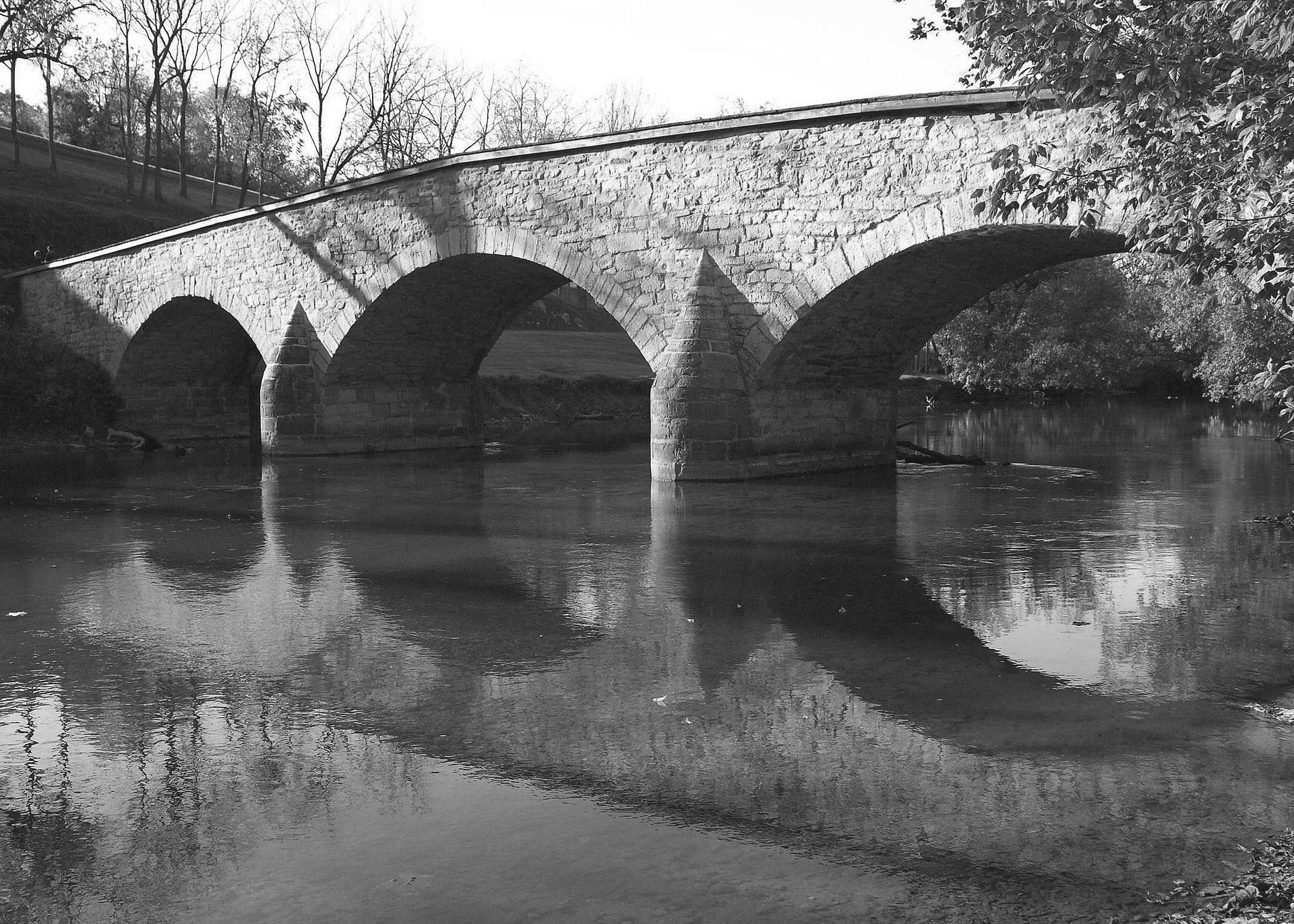

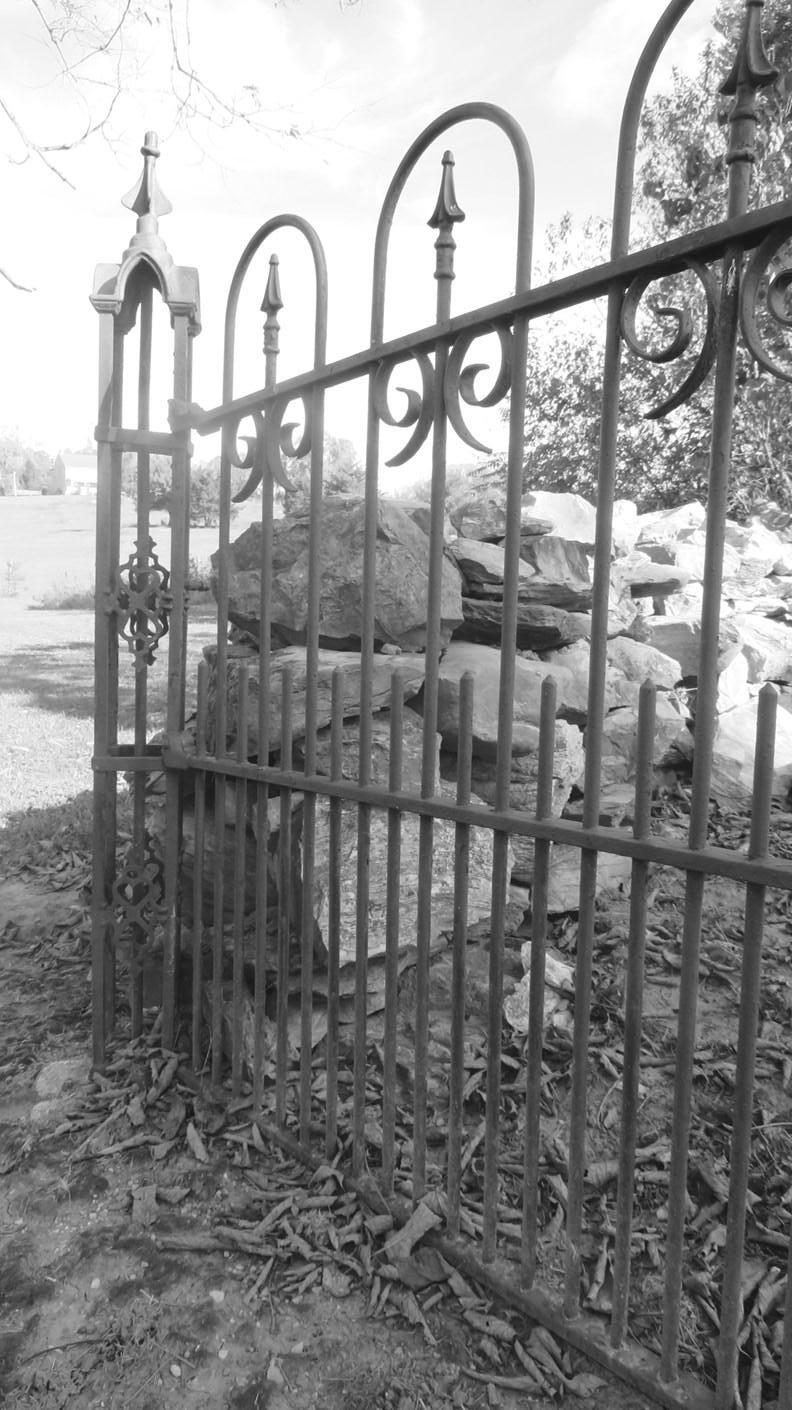

Guidelines for Historic Structures
Design
Adopted June 8,2022
Washington County,Maryland
Acknowledgements
Historic District Commission:
Gregory Smith, Chair
Lloyd Yavener, Vice Chair
Ann Aldrich
Vernell Doyle
Kourtney Lowery
Michael Lushbaugh
Edith Wallace
Jeffrey A. Cline (BOCC Representative)
Special Acknowledgements:
The Maryland Historical Trust
Preservation Maryland
Washington County Historical Trust (WCHT)
Clear Spring Historical Association (CSHA)
Former Historic District Commission Members:
Robert Bowman II
Thomas G. Clemens
Kurt Cushwa
Michael Gehr
Chris Horst
Sandra D. Izer
Gary W. Rohrer
Charles R. Stewart
Merry Stinson
Christine Toms
Carla Viar
David Wiles
County Staff:
Jill Baker, AICP, Director, Department of Planning & Zoning
Debra Eckard, Administrative Assistant, Department of Planning & Zoning
Meghan Jenkins, GISP, GIS Coordinator/HDC Staff person, Department of Planning & Zoning
Stephen Goodrich, AICP, Former Director, Department of Planning & Zoning
Wyatt Stitely, Comprehensive Planner, Department of Planning & Zoning
Cover Photos (Clockwise)
Burnside Bridge, Plumb Grove
Mansion, Church of the Brethren, Antietam Observation Tower
Adopted: June 8, 2022
ii Historic Structures
Table of Contents
Purpose of the Design Guidelines
Historic District Commission
Certified Local Government
National Register of Historic Places and Section 106 Review
HDC Review Areas
Historic Rural Villages (Historic Communities)
Antietam Overlay
Historic Preservation Overlay
Tax Credits
Maryland Inventory of Historic Properties
What’s Historic?
Significance
Integrity
Application Requirements
Evaluation Process
Demolition
Demolition Permit Evaluation
Demolition Permit Review
Failure to Comply or Willful Disregard
Demolition Permit Application
Requirements
Ordinary Maintenance
A Short History of Washington County
Architectural Styles of Washington County
Vernacular Forms 18th-19th Century
Georgian
Federal
Greek Revival
Italianate/Italian Villa
Second Empire
Queen Anne and Other Victorian Styles
Colonial Revival
Classical Revival
Twentieth Century
Mill Complexes
Common Accessory Structures
Commercial Buildings 1890-1930
Commercial Buildings Post 1930
Gas Stations
Ecclesiastical Architecture
Schoolhouses
Historic Markers
Standards for Review
Standards for Rehabilitation
Design Guidelines iii
Table of Contents (continued)
Guidelines
Setting and Site
Viewsheds
Site and Landscape Design Features
Landforms, Plantings and Landscapes
Fence and Walls
Circulation Systems
Patios, Decks, and Other Site
Features
Archaeological Resources
Cemeteries
Existing Accessory Buildings
Rehabilitation of Existing Buildings
Building Exteriors
Masonry
Additions to Historic Buildings
New Construction and Accessory
Buildings
Site and Building Lights
Signs
Solar and Other New Technologies for Environmental Sustainability
Solar Green Roofs
Wind Turbines
Hazard Mitigation
iv Historic Structures
Wood Entrances Windows Roofs Porches

Design Guidelines v
This page is intentionally left blank

These design guidelines are a set of guiding principles that establish a basis for the Historic District Commission’s (HDC) recommendations, approval, or denial of applications. The HDC uses these Guidelines and the Secretary of Interior’ s Standards for the Treatment of Historic Properties to determine if proposed work is appropriate for properties that fall under its review. Maryland Land Use Code S8.1018.501 and Article 20 of the Washington County Zoning Ordinance require the HDC to base its decisions on these documents. Conformance with the Secretary’s Standards is also a condition of the County’s Certified Local Government status, a program administered by the National Park Service (NPS) and Maryland Historical Trust (MHT), which is the state’s federally designated State Historic Preservation Office (SHPO).
These guidelines provide guidance for the protection and enhancement of significant historic structures, sites, and districts. Additionally, the guidelines define the appropriateness of requested exterior changes to existing historic structures and the approval of harmonious new construction within historic districts with attention to scale, massing, proportion, materials, and height.
Purpose of the Design Guidelines
Design Guidelines 1
Mong-Linger Farm, Spring House, WA-IV-004

Historic District Commission
The Historic District Commission (HDC) was created in 1986 and its duties and powers are largely housed in the Zoning Ordinance for Washington County. The HDC is responsible for reviewing applications which are affected by select Rural Villages in the County (see Rural Villages Inventory), the Antietam Overlay 1 or Antietam Overlay 2 (AO) zoning districts, and the Historic Preservation (HP) zoning overlay. In addition, applications affecting properties on the Maryland Inventory of Historic Properties (MIHP) are also reviewed. The HDC makes recommendations regarding legislation, applications for zoning text or map amendments, special exceptions, variances, site plans, subdivisions or other proposals affecting historic preservation or historic resources. Other duties of the HDC include:
• Recommend programs and legislation to the Board of County Commissioners and Planning Commission to encourage historic preservation
• Serve as a clearing house for information, provide educational materials and information to the public and undertake activities that advance the goals of historic preservation
• Development of additional duties and standards. For example, criteria to be used in the review of building permit applications
• Prepare, adopt, publish and amend additional guidelines to provide adequate review materials for applications including HP and building permits
• Oversee maintenance and updating of the inventory of Washington County Historic Sites
2 Historic Structures
Bank Barn, Rufus Wilson Complex, WA-V-074
Certified Local Government
The State of Maryland has a total of 24 counties, of which, eleven are Certified Local Governments (CLG) having a special commitment to historic preservation. Washington County is one of the few western counties designated as a CLG. The County obtained the designation in August of 1991. While the Certified Local Government program is a Federal-State-local partnership administered through Maryland Historical Trust (MHT), it is mentioned here because the Historic District Commission (HDC) acts as the required qualified historic preservation commission for the program.
Benefits of becoming a CLG include: eligibility to compete for funds to conduct projects that promote preservation, CLG sub-grant funds, ability to participate in the CLG Educations Set Aside Program, formal participation in the National Register nomination process, annual performance evaluations, and priority technical assistance. Being designated as a CLG means that the County is recognized by the National Park Service as being able to participate in the national policy of preservation.
National Register of Historic Places and Section 106 Review
The National Register is a tool that is used to document historic resources that are significant to the Nation and worthy of preservation. The National Register does not have regulatory power but it does provide a process for additional review for resource impact when Federal or State funding or permitting is involved in a project. It also provides access to Federal tax credits to incentivize rehabilitation projects. Because the HDC is a CLG, they are part of the review and coordination process for National Register nominations in the County.
Section 106, part of the National Historic Preservation Act of 1966, review occurs when any Federal or State funding or permitting is involved in a project that affects a National Register resource or a resource eligible for the National Register. In many cases properties identified on the MIHP may trigger at least an initial review for Section 106. Any project which has the potential to trigger this review should contact the Maryland Historical Trust (MHT) prior to application at the County to ensure the Section 106 process has been initiated. This opens up a consultation with Federal, State and local government (HDC), as well as the public, about views and concerns for the project. The review usually results in agreements and plans to mitigate the impacts on historic resources.
Design Guidelines 3
HDC Reviews
Historic Rural Villages (Historic Communities)
The County’s unincorporated Rural Villages are often strongly related to industry, transportation or migration. The County has a zoning classification of Rural Village; but, it is important to note that Historic Rural Villages do not always coincide with this zoning designation. Once an Historic Rural Village is surveyed by MHT or the County, the individual resources identified would henceforth have to undergo review by the HDC if any exterior changes are to be made.
Those properties individually listed on the MIHP within the Rural Village Zoning designation would also have HDC review of applications. Lastly, new construction in County surveyed Historic Rural Villages which have been adopted would also be reviewed by the HDC.
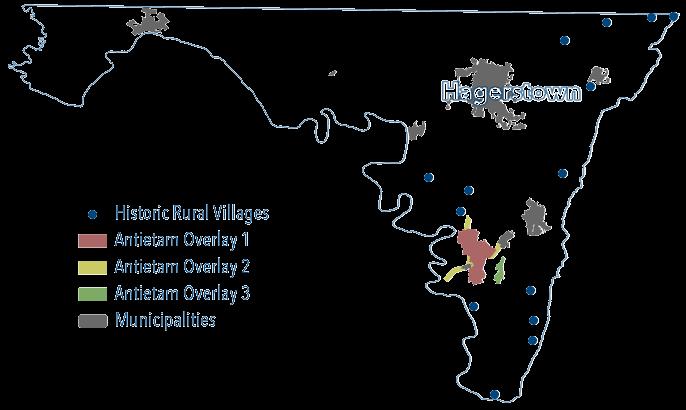
View Interactive Mapping
4 Historic Structures
Map of the Historic Rural Villages and Antietam Overlay Areas
Antietam Overlay
The protection of scenic vistas, especially those associated with small towns and villages, is important to historic resource protection. Deteriorated vistas can detract from the context of historic resources and also reduce the goal of immersion that heritage tourism strives to achieve. Washington County has numerous examples of historic and cultural landscapes, such as the Rural Villages. Currently, the County has adopted only one land management regulation specifically targeted at preserving the context of the Antietam National Battlefield. The Antietam Overlay zoning district protects viewsheds around the Antietam National Battlefield and its approaches with additional levels of review.
There are three distinct subareas that are defined in the Antietam Overlay zoning district. Overlay Area 1 (AO1) encompasses the Battlefield proper and a buffer surrounding the Federally owned land. In this area, the exterior appearance of all uses are subject to HDC review. Overlay Area 2 (AO2) consists of the approach areas to the Battlefield along major transportation corridors. The AO2 area requires applications involving the exterior appearance of all commercial and non-residential uses, excluding farm structures, to include HDC review. The final area, Overlay Area 3 (AO3), pertains to the Red Hill middle ground viewshed from the Battlefield. This area was designated with assistance from the National Park Service via a technical study entitled “Analysis of the Visible Landscape: Antietam” published in April 1988. Regulations in this area limit the amount of tree cutting allowed on specific areas of Red Hill. Applications in the AO3 area, unless individually listed on the MIHP, are not reviewed by the HDC.

Design Guidelines 5
Additional Tax Credit Resources
Secretary of Interior Standards for the Treatment of Historic Properties
MHT Tax Credits
County Tax Credit Resources
County Tax Credit Ordinance
County Tax Credit Application
Section 20.6, Washington County Zoning Ordinance
United States Internal Revenue
Service, Publication 530, Tax Information for Homeowners
Historic Preservation Overlay
The purpose of the Historic Preservation zoning overlay district is to provide a mechanism for the protection, enhancement and perpetuation of historic and cultural resources. It is an overlay zone meant to enhance, not substitute, for the existing zoning designation, that regulates land use. The presence of the overlay on a property indicates there is a historic or cultural resource that has significance to the heritage of Washington County. This overlay must be in place on a property to be eligible for County tax credits. Once in place, the HP Overlay provides continued opportunities for County tax credits as well as providing review authority for new construction or modification of existing structures’ exteriors on the property. The HDC reviews all applications for the HP Overlay and any applications containing HP Overlay. There are currently more than 40 HP overlay areas within the County. The intention of the Overlay, as listed in the zoning ordinance, is as follows:
• Safeguard the heritage of Washington County as embodied and reflected in such structures, sites and districts;
• Stabilize and improve property values of such structures, sites, and districts and in Washington County generally;
• Foster civic pride in the beauty and noble accomplishments of the past;
• Strengthen the economy of the County; and
• Promote the preservation and appreciation of historic structures, sites and districts for the education and welfare of the residents of Washington County.
Tax Credits
One of Washington County’s main tools used to promote historic preservation since 1990 is the tax credits for the restoration and rehabilitation of exteriors on historic structures. These credits are applied for prior to work starting, to determine if the property is in the HP Overlay or Antietam Overlay 1 or 2 zoning areas. If the property is not in an existing area the HP Overlay must be applied prior to application for the tax credit. This overlay is added through the rezoning process. Once the property is in an eligible area, credits of up to 10% of the total amount spent on preservation are available from the County if the owner follows the Secretary of Interior Standards for the Treatment of Historic Properties. The HDC reviews applications for tax credits against eligible items in the Zoning Ordinance Section 20.6 or improvements as described by the US Internal Revenue Service. The owner can also apply for State and Federal tax credits up to 20% through the Maryland Historical Trust, which is a separate application process.
6 Historic Structures
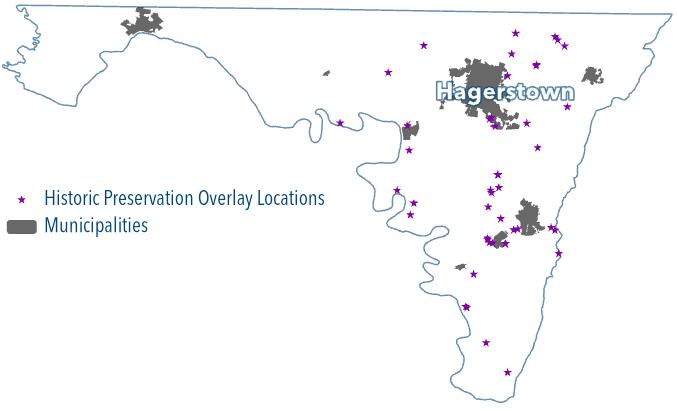

7
Antietam Iron Works Bridge (SHA W5731), WA-II-033
Map of the Historic Preservation (HP) Zoning Overlays View Interactive Mapping
Maryland Inventory of Historic Properties
The primary repository for resource identification and documentation is the Maryland Inventory of Historic Properties (MIHP). The Inventory was created by the Maryland Historical Trust (MHT) shortly after its creation in 1961. The inventory includes the nationally listed resources mentioned previously as well as those added by State and local efforts. The County, with grant assistance from the State, has been adding resources to the MIHP since the 1970’s. The County currently does not maintain its own inventory of historic or cultural resources. The properties fall into the categories of Buildings, Districts, Objects, Sites or Structures. The HDC reviews impacts to all resource categories listed but primarily reviews permits and plans affecting buildings on the Inventory.
What’s Historic?
Historic resources have factors which are used to evaluate and prioritize them. Typically, to be included on the National Register, a resource must be at least 50 years old. Age of the resource is simply one component to be considered.
Significance
Resources can have local, state or national significance. Typically, there is a period of significance which can be anywhere from a thousand years to a few days depending on the events the resource may be associated with. Significance is the importance of a property to the history, architecture, archaeology, engineering, or culture of a community. Significance is achieved by association with a set of criteria:
Criteria A
That are associated with events that have made a significant contribution to the broad patterns of our history; or
Criteria B That are associated with the lives of significant persons in our past; or
Criteria C
Criteria D
That embody the distinctive characteristics of a type, period, or method of construction, or that represent the work of a master, or that possess high artistic values, or that represent a significant and distinguishable entity whose components may lack individual distinction; or
That have yielded or may be likely to yield information important in history or pre-history.
8 Historic Structures

Design space, structure, and style of a property. This includes such elements as: organization of space, proportion, scale, technology, ornamentation, and materials.
Materials
Workmanship
Feeling
Association
Materials are the physical elements that were combined or deposited during a particular period of time and in a particular pattern or configuration to form an historic property.
Workmanship is the physical evidence of the crafts of a particular culture or people during any given period in history.
Feeling is a property's expression of the aesthetic or historic sense of a particular period of time.
Association is the direct link between an important historic event or person and an historic property.
Design Guidelines 9
Sign, Rufus Wilson Store, WA-V-074
These guidelines will provide assurance to property owners that their application review will be based on clear and consistent standards. These guidelines are also designed to be flexible and interpreted to accommodate each request as it is measured against the unique circumstances of each application, existing historic structures, and the proposed activities.
In the event of a conflict between state laws and the County’s ordinances and policies or these Design Guidelines, the HDC will consult with the County Attorney’s Office.
Application Requirements
The HDC makes prompt and proper decisions to issue a Certificate of Appropriateness or comments in support or not in support of applications when it has sufficient information to determine all aspects of a design proposal. The applicant bears the responsibility for ensuring that all applications are complete and on time.
The Historic District Commission hosts a public meeting on the first Wednesday of each month. Applicants must submit their detailed application at least ten (10) business days before the meeting to be included on the agenda.
The following information is determined to be the minimum acceptable to accompany an application for review by the HDC.
1. Scale drawings and pictures of the existing buildings showing their current condition. *All photographs must be in color and have excellent clarity; digital format is preferred.
2. A scale drawing of the proposed changes to the existing building or the new construction, showing all affected sides of the structure. The drawings should identify all new materials and show the actual design of a treatment rather than descriptions in words alone. Dimensions should be provided.
3. A scale drawing of the property showing the location of the existing buildings on the site and the location of the building additions or new construction. The relationship to public road and other points of access shall also be shown. The relationship of other buildings in the same or adjacent historic districts should be shown.
4. Sufficient information to determine the appearance of new exterior materials either in the form of manufacturer’s publications or samples. Photographs are especially helpful.
10 Historic Structures
5. See demolition section for additional application requirements specific to that application type.
Applications that require HDC reviews resulting in a Certificate of Appropriateness that are approved, approved with conditions or disapproved include:
1. Design review for construction within a Historic Rural Village or Antietam Overlay
2. Design review for construction within a Historic Preservation District
3. Demolition permit review for all structures within a Historic Preservation District or contributing structures within the Antietam Overlay
4. Determination for the issuance of County property tax credits for properties in the Historic Preservation District, Antietam Overlay, or National Register District within a municipality with a Historic District Commission
Applications that require HDC reviews resulting in comments in support or not in support for the application include:
1. Design review for construction within a Rural Village zoning designation for a property containing resources on the MIHP
2. Demolition permit applications for structures identified on the Maryland Inventory of Historic Properties that are outside the review areas listed above
3. Zoning text, zoning map amendments, special exceptions and variances, site plans, cell towers, and subdivision applications that affect historic structures or zones
The HDC does not review permit applications for construction under 100 sq ft in the Antietam Overlay or Rural Village zoning designations. Agricultural building permits also are not reviewed in those areas. The HDC does not review applications for interior changes but will provide consultation if requested. The information listed above is specific to the application review of the Historic District Commission. Additional submittal requirements may be necessary. Applicants should contact the Division of Permits and Inspections to determine those requirements. All applications, excluding Historic Preservation Tax Credit, are currently made through the Division of Permits and Inspections.

Did you remember?
Check for State or Federal Funding/Permitting and apply to MHT if needed

Check for MIHP or HDC Review Area Information

Check building permit or plan requirements


Check additional HDC application requirements based on review type Review the Design Guidelines for the work proposed
Design Guidelines 11
Evaluation Process
The Commission shall consider only exterior features of a structure that would affect the historic, archeological, or architectural significance of the site or structure, any portion of which is visible or intended to be visible from a public way. It does not consider any interior arrangements, although interior changes may still be subject to building permit procedures. The Commission renders a decision on a completed application within 45 days of receipt of the completed application. Failure to act within the specified time period shall be considered an approval of the application by the Commission. The 45-day review period may be extended upon agreement by the Commission and the applicant.
1. The application shall be approved by the Commission if it is consistent with the following criteria:
A. The proposal does not substantially alter the exterior features of the structure.
B. The proposal is compatible in character and nature with the historical, cultural, architectural, or archeological features of the site, structure, or district and would not be detrimental to achievement of the purposes of Article 20 of the County Zoning Ordinance.
C. The proposal would enhance or aid in the protection, preservation and public or private utilization of the site or structure, in a manner compatible with its historical, archeological, architectural, or cultural value.
D. The proposal is necessary so that unsafe conditions or health hazards are remedied.
E. The Secretary of the Interior's Standards for Rehabilitation and Guidelines for Rehabilitating Historic Buildings and subsequent revisions are to be used as guidance only and are not to be considered mandatory.
2. In reviewing the plans for any such construction or change, the Commission shall give consideration to and not disapprove an application except with respect to the factors specified below.
1. The historic or architectural value and significance of the site or structure and its relationship to the historic or architectural value and significance of the surrounding area.
2. The relationship of the exterior architectural features of the structure to the remainder of the structure and to the surrounding area.
12 Historic Structures
3. The general compatibility of exterior design, scale, proportion, arrangement, texture, and materials proposed to be used.
4. Any other factors, including aesthetic factors, that the Commission deems to be pertinent.
3. The Commission shall be strict in its judgment of plans for those structures, sites, or districts deemed to be valuable according to studies performed for districts of historic or architectural value. The Commission shall be lenient in its judgment of plans involving new construction, unless such plans would seriously impair the historic or architectural value of surrounding structures.
For Rural Villages, additional review criteria for applications are listed in Architectural Review of the Zoning Ordinance and include:
1. The exterior appearance of existing structures in the Rural Village, including materials, style, arrangement of doors and windows, mass, height and number of stories, roof style and pitch, proportion.
2. Building Size and Orientation
3. Landscaping
4. Signage
5. Lighting
6. Setbacks
7. Accessory structures

Design Guidelines 13
Click
to View Document
Demolition
Washington County encourages the retention of significant buildings, structures, sites, objects, or other historic resources within the County. Given the irreversible nature of demolition, full deliberation of all alternatives before action is essential.
Additional Resources:
Preservation Brief #31 Mothballing of Historical Buildings
Demolition Permit Evaluation
In considering a request for a Certificate of Appropriateness or comment to demolish a structure, the Commission will weigh the criteria listed in the Evaluation Process previously discussed.
Demolition Permit Review
Demolition review is a legal tool that provides the Historic District Commission with the means to ensure that potentially significant buildings and structures are not demolished without notice and review. This process creates a safety net for historic resources to ensure that buildings and structures worthy of preservation are not inadvertently demolished.
Demolition review does not always prevent the demolition of historically significant buildings or structures. Rather, as the name suggests, it allows for review of applications for demolition permits for a specific period to assess a building’s historical significance.
If the applicant or the HDC requests additional guidance regarding the property to determine significance or documentation status, the Maryland Historical Trust may be contacted to assess a to-be-demolished structure. The Maryland Historical Trust does not have a formal role in regulating or reviewing local demolitions but will act as a technical resource as needed.
Failure to Comply or Willful Disregard
Failure to comply or disregarding these policies will result in applicable fines being administered.
The Historic District Commission will review demolition permits for structures 400 square feet or greater or if partial demolition is proposed in coordination with new construction or additions. Reviewable structures are on the Maryland Inventory of Historic Properties (MIHP), within the Historic Preservation Zoning Overlay, Antietam Overlay 1 or 2 or are greater than 50 years old in a Historic Rural Village.
14 Historic Structures
Demolition Permit Application Requirements
The following demolition permit application requirements are in addition to the Application Requirements listed previously for the Historic District Commission. Demolition permits that involve multiple structures, such as a farmstead or site, should include documentation that will enable full review of all involved structures.
The demolition permit number, provided after permit application with Division of Permits and Inspections, must accompany the demolition application materials listed below. Materials for HDC review may be submitted digitally to the Department of Planning & Zoning at askplanning@washco-md.net once the permit application has been filed. Applicants may be required to provide additional materials to other reviewing agencies.
A. Written description and history of the building or structure to be demolished.
B. Detailed drawings, such as construction or trim details.
C. Floor plan for each floor level, drawn to approximate scale or fully dimensioned.
D. Applicant’s plan for the recycling of waste generated.
E. A report analyzing the demolition alternatives and mitigation (listed in descending order of preference) as to their feasibility. The report shall consist of thorough, deliberative analyses of each of the alternatives, explaining why each alternative is or is not feasible. Additional photographs should be provided in support of the analysis. In cases where a permit may involve multiple structures, each structure must have its alternatives documented.
F. A site plan illustrating any proposed development or introduction of plantings following demolition (if applicable).
The HDC highly encourages the early review and involvement of the Maryland Historical Trust (MHT), using their Project Review Form. The instances where MHT should be consulted include buildings, sites, and projects that involve State or Federal funding or may require state or federal permits; for example, a state highways entrance permit. This review will ensure that the Section 106 process, if needed, is at least started before the HDC reviews a demolition permit. This process allows for greater consulting party input.
The HDC may request additional information from the applicant following the review and discussion of the application. Additional information ensures that the structure has been fully documented before a Certificate of Appropriateness or support of a demolition permit occurs. This documentation could include supporting documents from licensed professionals such as an architect, engineer, or restoration specialists.
Demolition Alternatives
Redesigning the project to avoid any impact to the structure or its setting;
Incorporating the structures into the overall design of the project;
Converting the structure into another use (adaptive reuse);
Relocating the structure on the property;
Relocating the structure to another property;
Demolition Mitigation
Documenting the structure as a whole and its individual architectural features in photographs, drawings, and/or text. This documentation should follow the Standards and Guidelines for Architectural and Historical Investigations in Maryland and be completed by a professional as listed in those Standards;
Salvaging from the structure historically significant architectural features and building materials.
Design Guidelines 15
Preferred Less Preferred
Initial Process for demo (Applicant)
Open Maryland Historical Trust (MHT) Project Review if applica-

Consider demolition alternatives and gather documentation which supports those alternatives’ feasibility

Apply for demolition permit with Division of Permits and Inspections AFTER any applicable Site Plan, Grading or Subdivision review is completed.

Supply required documents and demolition permit specific required documents to HDC Staff at time of demolition permit application.

Review Process for demo (HDC)
Complete demolition permit applications will be distributed for review by the HDC at next meeting date. Permit is shared with additional interested historic partnerships for comment. If MHT Project Review is applicable review will not be scheduled until MHT initial review is complete.
HDC Meeting Process for demo (HDC and Applicant)
HDC discusses provided application information and any qualified professional documentation with the applicant. Demolition alternative information will be reviewed extensively. Note: No public comment is taken. This is not a hearing.

HDC Recommendation
HDC will make motion in support or not in support of the demolition permit.

Support
If the HDC supports the demolition permit, a letter stating support will be attached to the application with reasoning and the application will need no further HDC review.

Not in Support
If HDC is not in support of the permit, the permit and all review information will be forwarded to the Planning Commission to be scheduled at their next available meeting date for their determination of support. Planning Commission may provide additional alternatives to the applicant that are available from the subdivision or site plan perspective to minimize impacts to historic resources.
16 Historic Structures
Ordinary Maintenance
Maintenance of all structures, historic or otherwise, is strongly encouraged. Routine maintenance of buildings in the historic preservation zone, rural villages, or properties listed on the Maryland Inventory of Historic Properties may not require review or approval by the Historic District Commission, a Certificate of Appropriateness, or a building permit. However, it is strongly recommended that the customer reach out to the Historic District Commission prior to starting work if there are questions regarding a project on a historic structure. The Historic District Commission is a resource for proper treatments and can assist in determining if the changes are within the scope of ordinary maintenance. Ordinary or routine maintenance is work that does not alter the exterior features of a Historic Site or contributing structure. Key exterior features, including roof materials, doors, windows, moldings, are discussed later in detail in these guidelines.
Ordinary maintenance can include activities to prevent or correct deterioration, decay. or damage to a structure or any part thereof as long as repairs or replacement are of like material and design. Nothing in these guidelines shall be construed to prevent ordinary maintenance or repair that does not involve a change of design, material, or of the outward appearance of a building.
While the repair of an individual pane of glass in a window may be considered maintenance, the restoration of windows, or other exterior elements, as part of an overall home improvement project may be considered for tax credits. The HDC reviews applications for tax credits against eligible items in the Zoning Ordinance Section 20.6 or improvements as described by the US Internal Revenue Service. It is important to reach out to the HDC or staff to determine if a project may qualify for tax credits.
Additional Resources:
Preservation Brief #3 Improving Energy Efficiency in Historic Buildings
Preservation Brief #39 Holding the Line: Controlling Unwanted Moisture in Historic Buildings
Preservation Brief #47 Maintaining the Exterior of Small and Medium Size Historic Buildings
Publication 530, Tax Information for Homeowners, United States Internal Revenue Service
Washington County Zoning Ordinance, Section 20.6
Design Guidelines 17
A Short History of Washington County
The first European settlers who arrived in Lord Baltimore’s colony of Maryland in 1634 were mostly English Catholics. It took another 100 years before the first land patent was issued in what is now Washington County. While some of those applying for the earliest patents in our county were of English descent, it was the German Protestants emigrating south out of Pennsylvania who would have the greatest impact on the landscape and architecture. Settlers such as Jonathan Hager, Hagerstown’s namesake, and other skilled Germans decidedly had the largest impact of transforming a wilderness landscape into neat, productive farms and towns. The architecture in both their homes and agricultural buildings reflects their Dutch, German, Swiss, Italian, Bohemian, and English heritage. With the farming of vast acreages, surviving outbuildings and deed references provide evidence that large landowners in the County owned slaves or indentured servants to tend to their land. As a result, there are examples of institutional buildings such as schools to support the African American community as well as vernacular structures which were later homes to the freed.
As the transportation routes of the rivers, canals, and roads to the area improved, an even larger mix of ethnic groups came to the area. The legacy of these settlers and their descendants is a diverse accumulation of architectural styles and construction methods that make Washington County a unique and special place. The German’s fondness for usage of the most readily available building material, native limestone, is reflected in the stone houses, barns, and bridges that are still evident in our community. Surviving also, are the English brick and log structures. Along the National Road and the Chesapeake and Ohio Canal, many highstyle, large, brick and frame buildings appeared, reflecting the financial prosperity there. Other humbler structures were built elsewhere, representing the more common agricultural settlements. Fortunately, many of the older buildings of our early days remain. The purpose of these Guidelines is to assist those who wish to preserve and restore these defining aspects of our culture.
18 Historic Structures
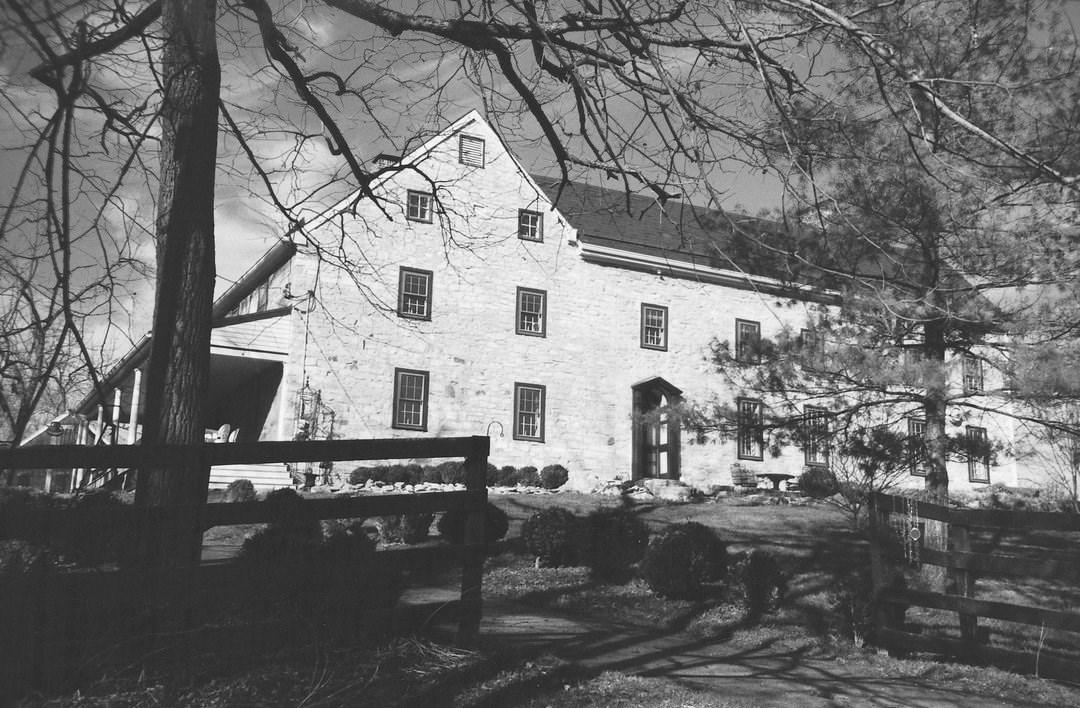



Design Guidelines 19
013
Sunshine
Hill,
WA-VI
Old Forge Farm, Surveyor’s Last Shift, WA-I-054
Valentia, WA-I-231
Stone Hill, WA-II-403
Photo Credit (All Photos): WCHT
This page is intentionally left blank
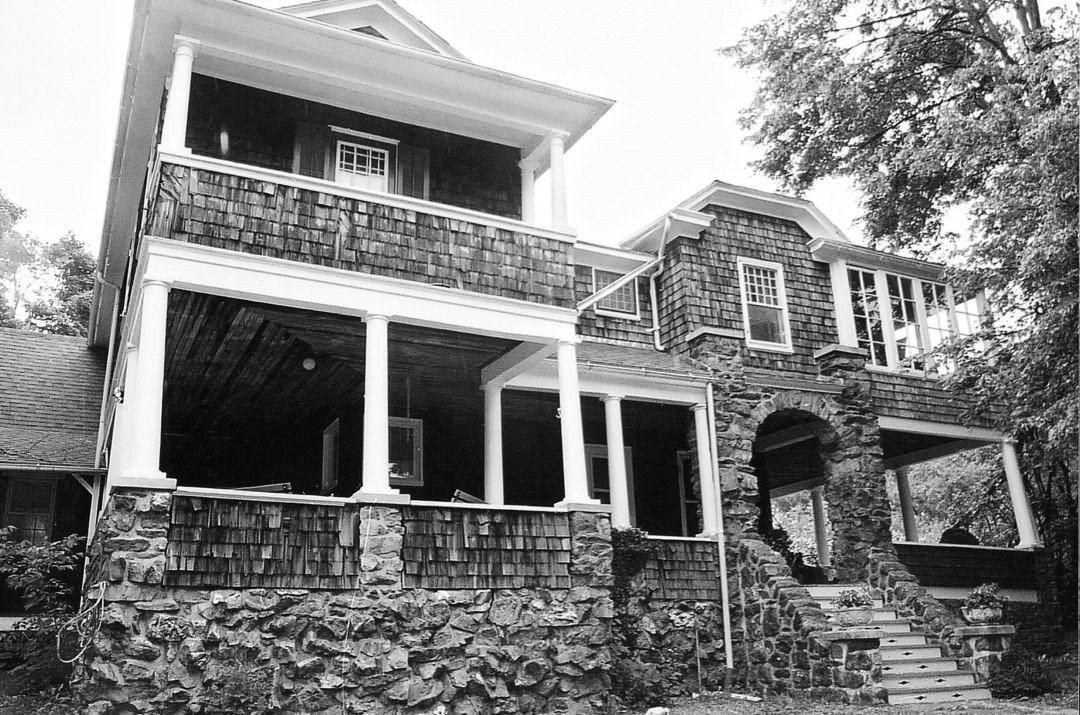
Whether magnificently restored or lovingly maintained, the historic properties that dot Washington County’s rural roads and rolling hills are fine adornments in the rich tapestry comprising Maryland’s diverse history.
Washington County contains examples of a wide variety of eighteenth, nineteenth, and early-twentieth-century residential and commercial architecture, including Federal, Greek Revival, Italianate, Second Empire, Queen Anne, Colonial Revival, and Neoclassical Revival styles.
Very rarely are buildings academic, textbook examples of their particular style; rather most are vernacular interpretations of high-style architecture. The original design includes numerous modifications. Through their decorative detailing, these vernacular buildings reflect the influences of popular styles.
The character-defining elements that define a building’s style are particularly important to preserve and should receive special consideration in planning for maintenance or rehabilitation e.g. siding, windows, doors and roofs. The following descriptions and illustrations provide an introduction to the historical background and distinguishing features of the architectural styles commonly represented throughout Washington County.
Architectural Styles of Washington County
Design Guidelines 21
Keewaydin, Mt. Angelwood, WA-IV-089 Photo Credit: WCHT
The term vernacular (or folk) architecture generally refers to buildings not planned by an architect but based upon regional traditions, the materials at hand, and some expedience.
Vernacular Forms 18th—19th Century
The earliest houses in Washington County do not fit easily into any particular category, but they can be grouped by several identifying features that reflect the changes in eighteenth and nineteenth-century rural domestic architecture.
Character-Defining Elements
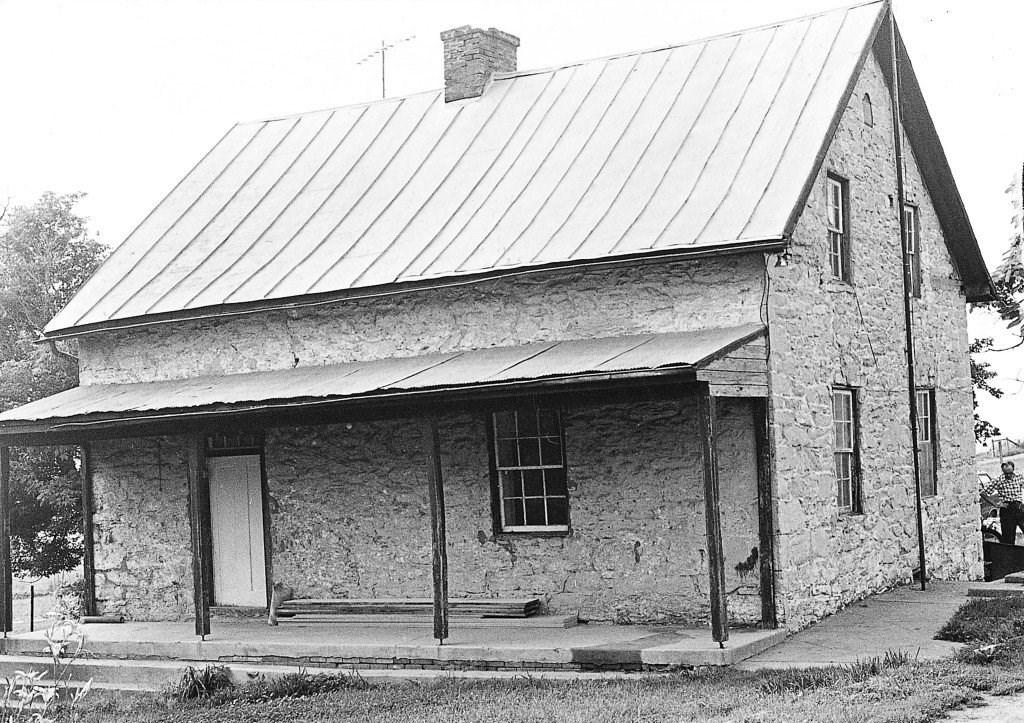
1730 to 1760
• Stone, log, or log-encased clapboard over a rough-stone foundation
• Constructed over a spring
• 1 to 1 ½ or 2 stories
• Steeply pitched roofs
• Large central chimneys
• Very small window openings
• Batten doors
• Puncheon logs and rocks as insulation between the basement and first floor
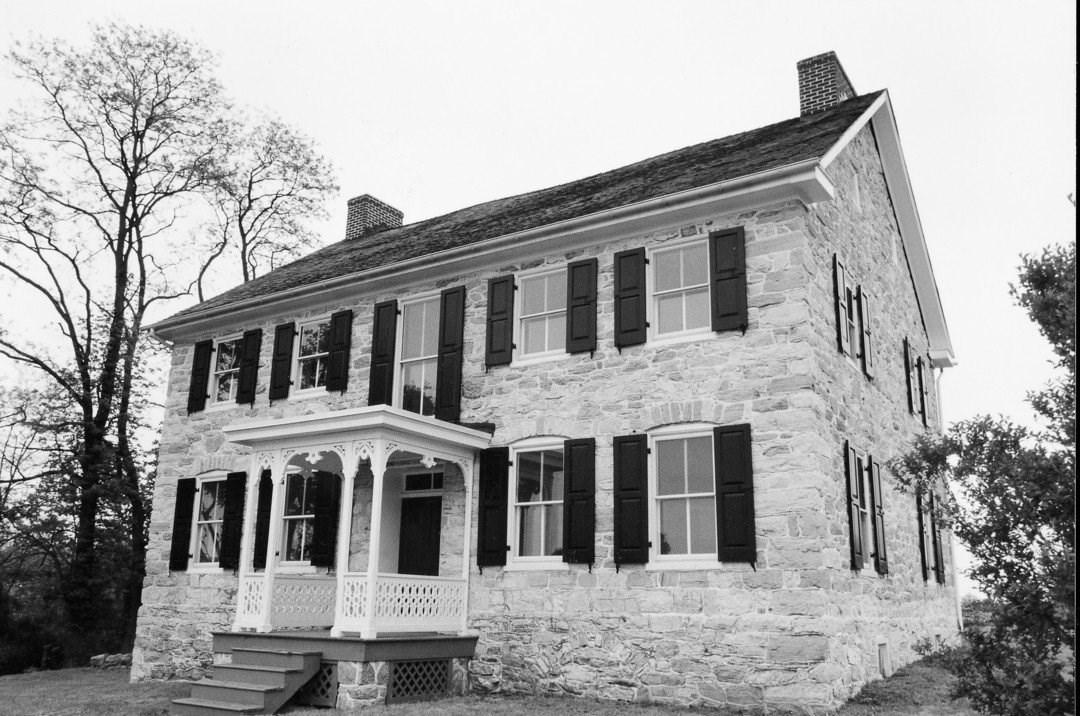
1760 to 1790
• Stone, log, or log-encased clapboard over a stone foundation
• Usually 2 stories
• Jack arches over windows
• Gable-end chimneys
• More refined cut stones, quoined corners
• Mid-century structures reflect a variety of styles, dependent on the ethnicity of the builder
22 Historic Structures
Kammerer House, WA-I-013
David’s Friendship, WA-I-388
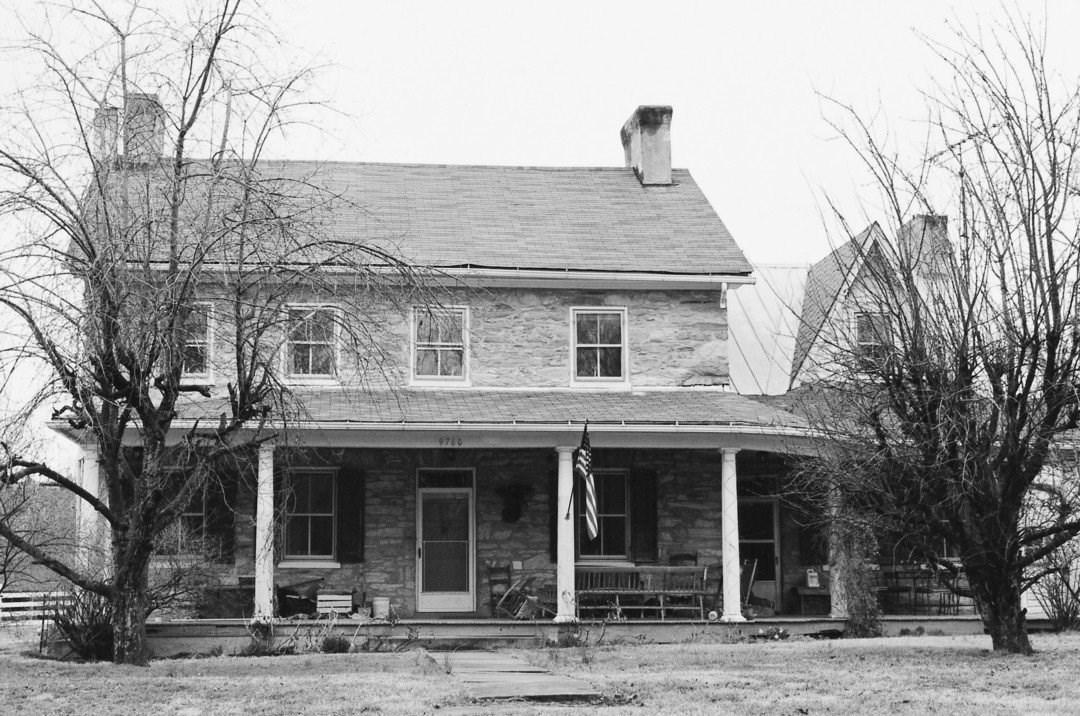
1790 to 1820
• Stone, brick, clapboard
• One to two stories
• Often with two front doors
• Segmented arches above windows
• Gable-end chimneys

1820 to 1860
• Stone, brick, clapboard
• One to two stories
• Plain lintel above windows
Design Guidelines 23
Scratch Ankle Farm, WA-II-084
Brightwood, WA-I-216
Photo Credits: WCHT and Maryland Inventory of Historic Properties (MIHP), Maryland Historical Trust
Georgian – 1720 to 1840
Georgian architecture developed in England out of the Classical Revival which dominated Europe during the Renaissance and Enlightenment. The Georgian style’s name comes from the successive rulers of Great Britain, King George I through King George IV, who ruled England while Georgian architecture was popular. Georgian architecture became unpopular in the United States at the time of the Revolutionary War as American architects wished to separate their style from British influence.
• Simple 1-2 story box, 2 rooms deep, using strict symmetrical arrangements
• Panel front door centered, topped with rectangular windows (in door or as a transom) and capped with an elaborate crown/entablature supported by decorative pilasters
• Cornice embellished with decorative moldings, usually dentil work
• Multi-pane windows are never paired, and fenestrations are arranged symmetrically (whether vertical or horizontal), usually 5 across
• Roof: 40% are side gabled; 25% gambrel; 25% hipped
• Chimneys on both sides of the home
• A portico in the middle of the roof with a window in the middle is more common with postGeorgian styles
• Small 6-paned sash windows and/or dormer windows in the upper floors, primarily used for servants’ quarters.
• Larger windows with 9 or 12 panes on the main floors
24 Historic Structures
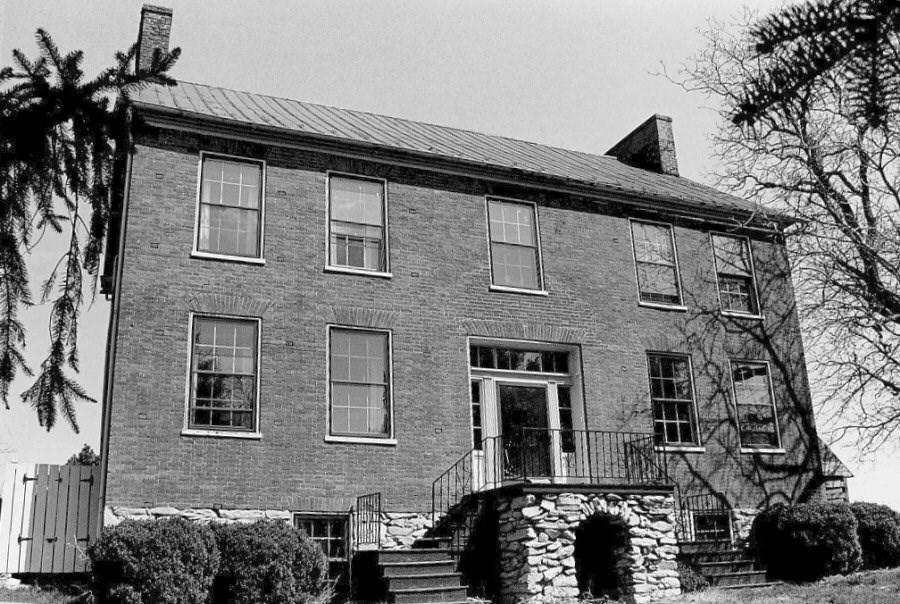

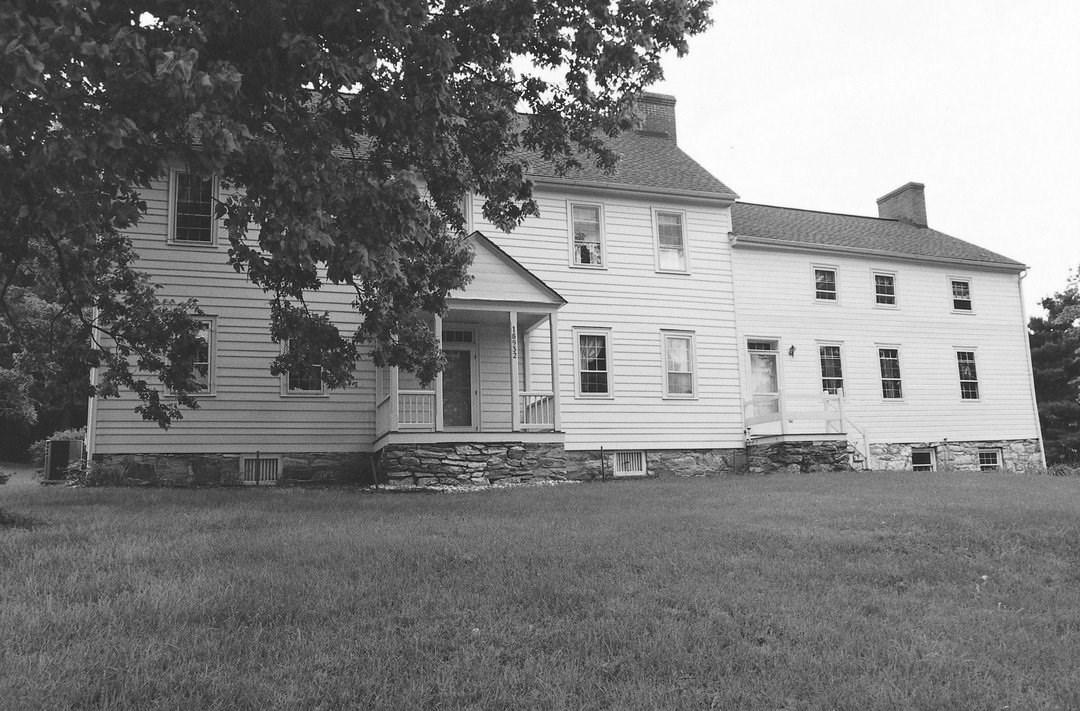
Design Guidelines 25
Daniel Donnelly House, WA-II-417
Photo Credit: Paula Stoner Dickey, MIHP
Ditto Knolls, WA-II-093
Photo Credit: WCHT
Hitt-Cost House, WA-II-252
Photo Credit: WCHT


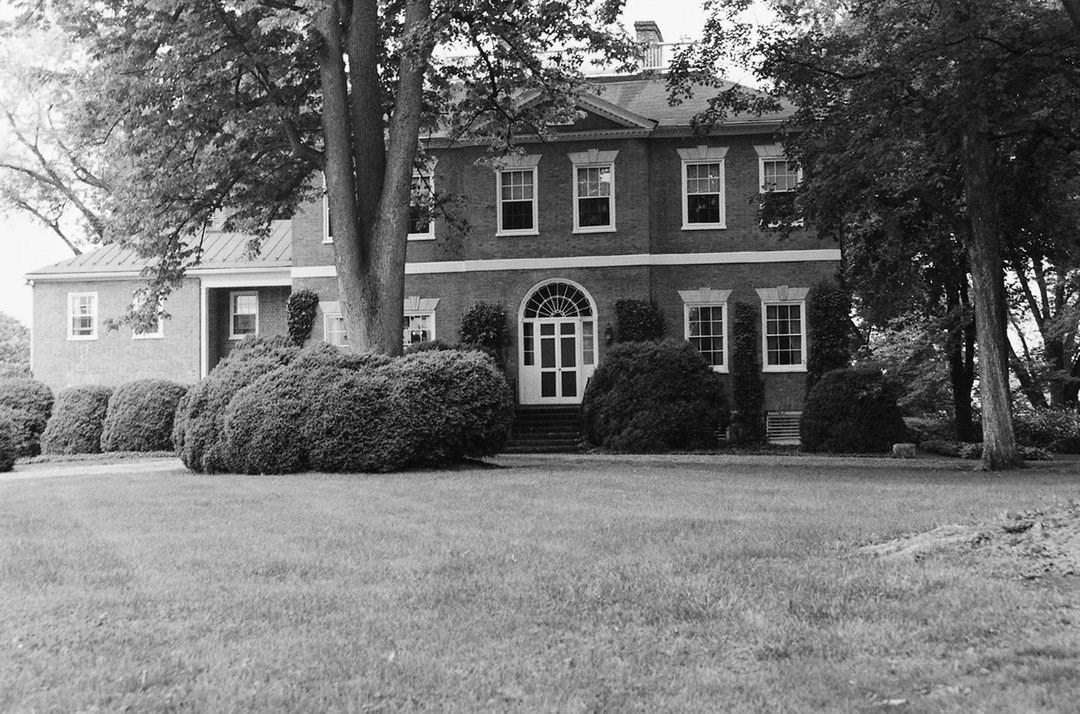
Federal – 1780 to 1840
Houses of the Federal period, constructed during the first years of the new republic, retained the general form of their Georgian predecessors, but were characterized by more delicate decorative detailing that often incorporated elements derived from early Greek and Roman design.
• Fanlight over door (almost always rounded, rarely squared), sidelights
• Classical/Greek detailing of entryway, Palladian windows, balustrades, oval/ circular
• Rooms in some high-style examples
• Fenestration is symmetrical as Georgian style.
• Double-hung sash windows for first time (Georgian also)
26 Historic Structures
Woburn Manor, WA-II-458
Ferry Hill, WA-II-035
Rose Hill, WA-I-374
Photo Credits: WCHT
Greek Revival – circa
1830 to 1860
The Greek Revival style spread rapidly across America between 1830 and 1850. Two factors helped increase the style’s popularity. Archaeological excavations during this period increased public awareness of ancient Greece, and citizens of the new American republic sympathized with modern Greece’ s involvement in its war for independence (1821-30).
• Low-pitched gable, hipped or shed roof; gable may face front
• Portico or recessed entrance; pilasters, square posts, or classical columns
• Entrance with transom and sidelights
• Broad frieze below cornice, sometimes with rectangular attic windows
• Trim incorporates geometrical forms, “bull’ s eye” and foliated motifs

Design Guidelines 27
Plumb Grove Mansion, WA-V-015

Italianate/Italian
Villa – circa 1830 to 1880
The Italianate style developed as part of the Picturesque movement which was a reaction against classical formality. The style has two basic forms. Italianate buildings based on Renaissance models are rectangular in plan with symmetrical façades, whereas the “Italian Village” type is based on the designs of rural farmhouses in Italy and are characterized by an asymmetrical L-shaped or T-shaped floor plan with a tall tower.
• Low-pitched gable or hipped roof (attached buildings may have shed roofs)
• Eave cornice with decorative brackets
• Walls are given a smooth finish; finely coursed brickwork with narrow mortar joints is typical; cut stone and stucco were also used
• Enriched detailing such as string courses and quoins
• Tall, narrow windows, often with roundarched heads
• Windows may have elaborate frames, hoods, bracketed lintels, or pediments
• Porch or arcade may span the façade, or a small portico may define the entrance
28 Historic Structures
Streetscape in Williamsport, WA-WIL-025, WA-WIL-026 & WA-WIL-027
Second Empire – circa
1860 to 1890
The Second Empire style is most readily recognized by the characteristic mansard roof; a hipped roof of double pitch. The lower slopes of the roof, just above the building walls, are steeply pitched to create a usable upper story lighted by dormer windows. This roof form is named for the seventeenth-century French architect François Mansart. The style became popular in France during the Second Empire (185270) and spread to the United States in the 1860’s.
• Generally symmetrical, rectangular in plan and 2 ½ stories high
• May have a projecting entrance mansard roof, usually covered in slate; sometimes slates of various shapes and colors are used to create intricate patterns
• Lower slopes of roof may be straight, convex, or concave; windows may be topped with semicircular or segmental arches and often have bold molded heads
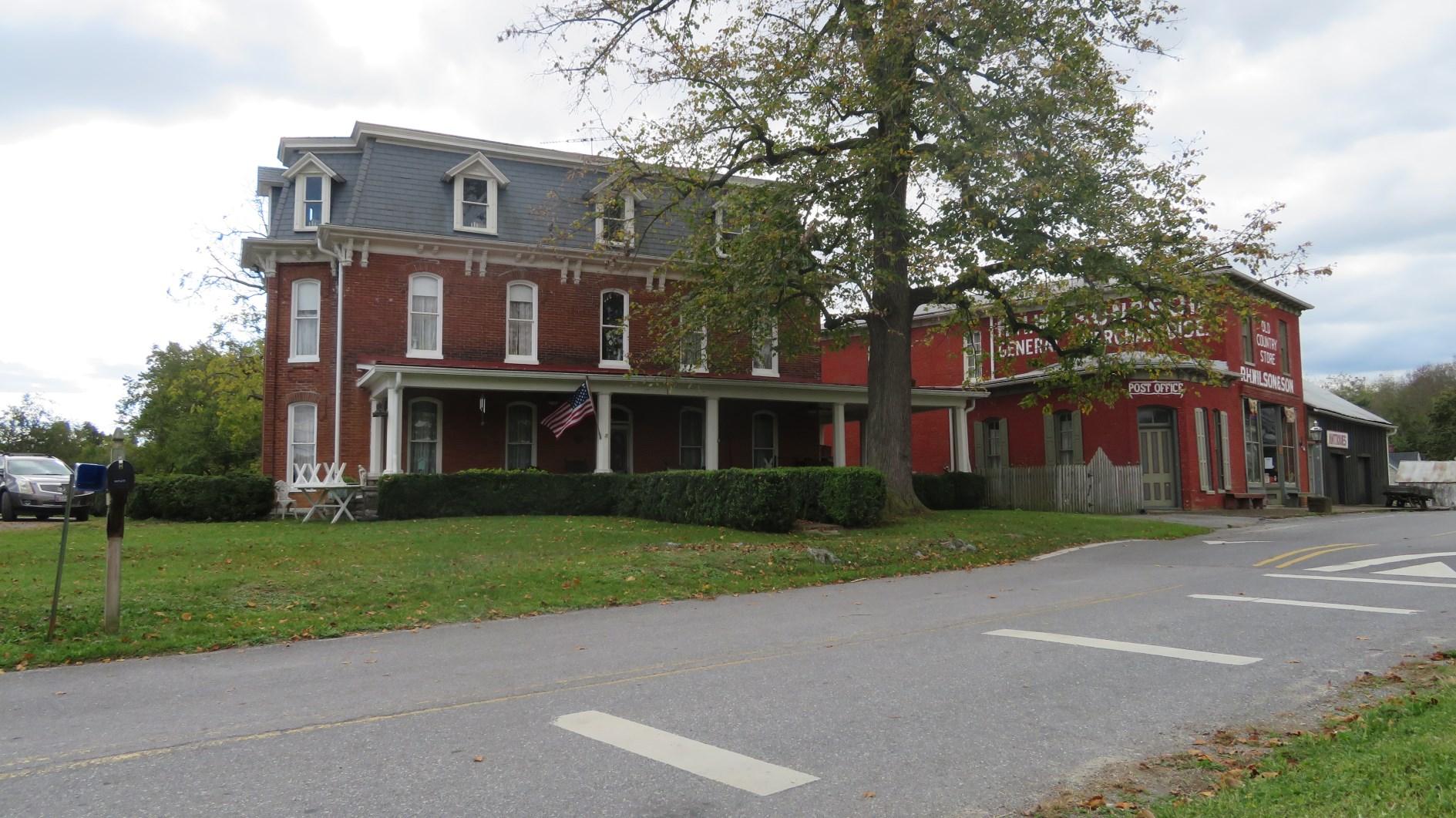
Design Guidelines 29
Rufus Wilson Complex, WA-V-074
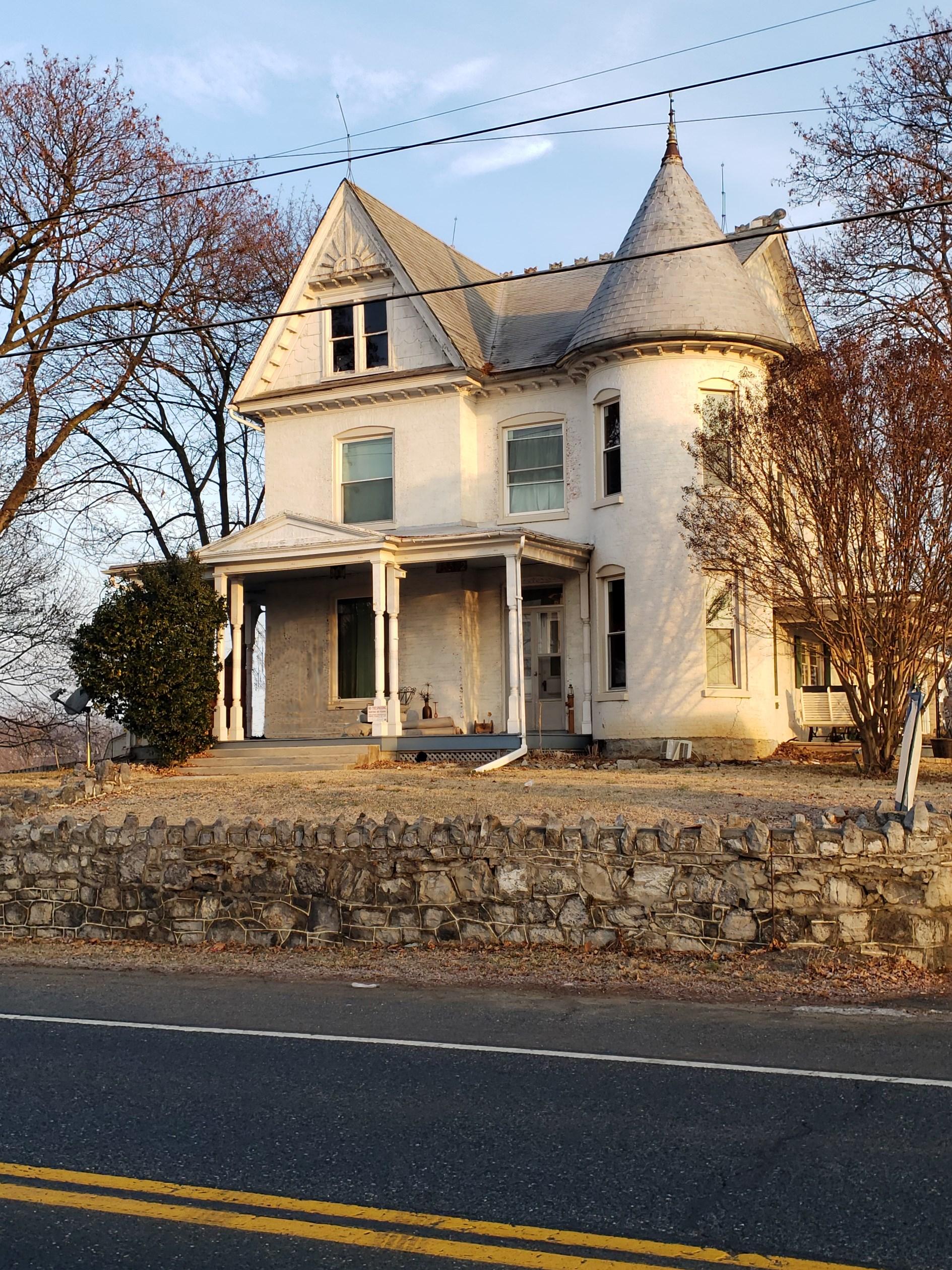
Queen Anne and other Victorian Styles – circa 18801910
The Queen Anne style is derived from medieval English architectural forms.
• Asymmetrical plan and massing
• Variety of surface treatments, textures, and colors
• Elaborate decorative trim, shingles and brickwork
• Irregular roof line with multiple steep gables
• Conical-roofed tower at corner
• Façade may have various projecting bays
• Row houses often have second-story oriel windows
• Porch may span façade, sometimes wraps around corner of building
• Double-hung windows often have multiple small lights in upper sash; sometimes forming a border around a single large pane. These small lights may be either clear or include colored stainedglass windows and transoms
Historic Structures
Eby House, WA-I-328
Colonial Revival – circa 1876-1920
The American Centennial of 1876 prompted a revival of interest in the nation’s heritage. As a result, architects began to study the building forms and detailing of the Colonial period. The return to these historical precedents was partly a reaction against the unrestrained exuberance that characterized Victorian era design. Colonial Revival buildings often combine turn-of-the century building forms with decorative elements derived from eighteenth-century architecture. This detailing is often over-scaled and sometimes incorporates features of the Queen Anne style, whose period of popularity overlapped that of the Colonial Revival.
• Generally symmetrical façade, 2 or 2-1/2 story height
• Gabled, hipped or gambrel roof form
• Masonry or frame construction
• Brick may be laid in Flemish bond pattern
• Frame buildings covered with wood siding in bevel profile, or with wood shingles
• Multi-pane sash windows
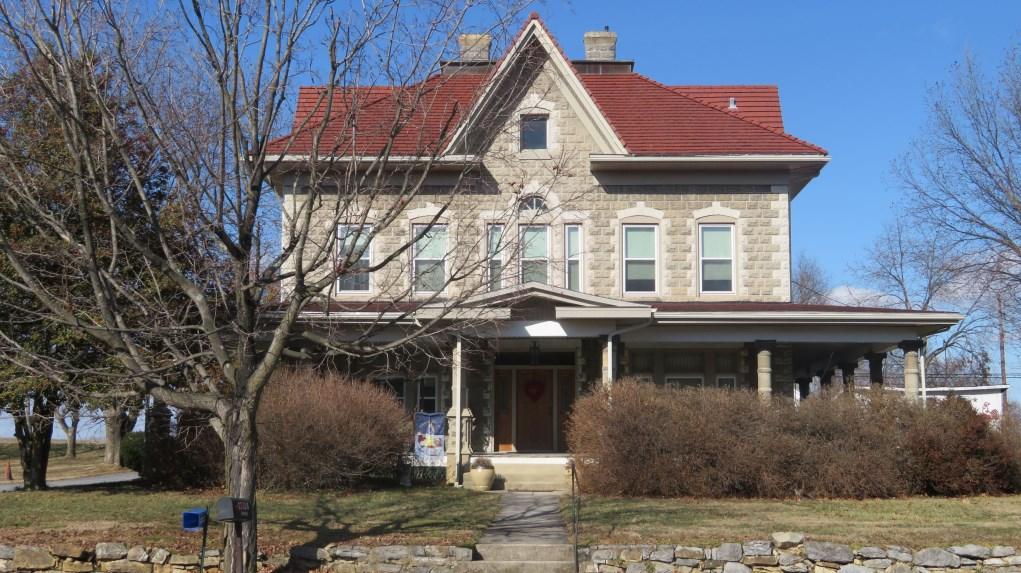
• Porches may have heavy tapered columns and balustrades with square or turned balusters
• Entrance located in the center of the façade, with transom and sidelights
Classical Revival – circa 1900-1920
Developed in America in the first quarter of the twentieth century, this style was popular for public and commercial buildings; its monumentality was frequently used in the construction of bank buildings. The Neoclassical Revival employed features from Greek antiquity such as Ionic and Corinthian columns and pedimented porticoes to embellish balanced, regular compositions. Wall surfaces were smooth and often were finished in fine materials such as marble.
• Classical Greek and Roman architectural elements: columns, round arches, heavy entablatures, often with elaborate detail
• Symmetry in plans, use of wings or corner pavilions
• Used for government and civic buildings; common for banks

Design Guidelines 31
WA-II-385, Shepherdstown Pike, Sharpsburg
WA-HAN-055, West Main St., Hancock
Twentieth Century 1900-1950
The modern styles of architecture are a result of America’s efforts to design inexpensive housing that was eye-pleasing and functional, but could be built quickly to keep up with the fast-paced effects of the industrial revolution. Builders stopped constructing elaborate Victorian styles in favor of homes that were compact, economical, and informal.
A predominant architectural style of Washington County in the twentieth century, the American Foursquare, is known by a variety of terms. These include box house, a cube, a double cube, or a square type American house. The style first appeared about 1890 and remained popular well into the 1930s. The American Foursquare lent itself to endless variations and finish details by individual buyers.
Bungalows, often associated with the Craftsman Style, are characteristically smaller houses. These structures were predominantly built after 1905. Construction of the style began in California, the state where the architects most associated with the Craftsman style, Greene and Green, were based. This style of house was frequently found in pattern books for purchase. Some were even offered as complete packages including materials to be built on site.
Ranch style houses, also known as the American ranch, California ranch, rambler, or rancher, is another of the domestic architectural styles that has now aged sufficiently to have become of interest. First built in the 1920s, the ranch style was extremely popular among the booming post-war middle class of the 1940s to 1970s. The ranch house is noted for its long, close-tothe-ground profile, and minimal use of exterior and interior decoration.
32 Historic Structures
Foursquare
• Simple floor plan
• Boxy, cubic shape
• Full width front porch with columnar supports and wide stairs
• Offset front entry in an otherwise symmetrical façade
• 2 to 2 ½ stories
• Pyramidal, hipped roof, often with wide eaves
• Large central dormer
• Large single light windows in front, otherwise double hung
• Incorporated design elements from other contemporaneous styles, but usually in simple applications

Bungalow
• Low-pitched, gabled roof (front, side or cross gabled roof)
• Wide overhanging eaves
• Exposed rafters under eaves
• Decorative brackets (knee braces or corbels)
• Front corner porches under roofline
• Tapered or squared columns supporting roof or porch
• 4 over 1 or 6 over 1 sash windows
• Hand-crafted stone or woodwork
Ranch Style
• Single story
• Horizontal, rambling layout: long, narrow and low to the ground
• Rectangular, L-shaped or U-shaped design
• Open floor plans
• Low pitched rooflines with wide eaves, often hipped or gabled
• Attached garage or carports
• Large windows and sliding glass doors


Design Guidelines 33
Maugansville, WA-I-804
Bungalow, 1400 Block of Sharpsburg Pike, Hagerstown
Ranch, Benny Drive, Hagerstown
Mill Complexes
Washington County has a rich history in agriculture and forestry. These industries required local mills to process timber and grain products into commodities for locals. Many larger creeks in the County, such as Beaver Creek and Antietam Creek, provided the water power necessary for locals to construct the dams, races, and sluice boxes that ensured those waters were harnessed effectively. There are mills scattered along waterways throughout the County. Early mills were of log construction. Remaining mills are predominantly limestone construction. The mills contain additional features such as water wheels and milling machinery including millstones. Support buildings associated with storage of the raw or processed materials are common. The homes of the operators or owners are also part of the complex. Communities frequently sprang up directly adjacent to these complexes. Many mills are associated with early large landowners of the County. There are approximately 50 sites associated with mills on the Maryland Inventory of Historic Properties in the County.
• Masonry exterior
• 2-4 stories
• Built into the bank of water source
• Rectangular shape for Mill
• Gable roof
• Wood shingle or metal roof
• Windows along all façades of varying fenestration
• Support buildings
• Stream engineering including races, sluices and dams
34 Historic Structures


Design Guidelines 35
Doub’s Mill; Newcomer’s Mill, WA-II-090
Photo Credit: WCHT
Rose’s Mill, Pleasant Grove Mills, WA-I-413
Common Accessory Structures—Pre 1930
Many structures within the County are part of a complex of buildings, all of which contribute to the history of the County and site. These structures create a historic landscape. They are often of similar construction to the main structure on the property, but they could have been built before or after the main structure depending on the development of the complex.
Bank Barn
These 2-story structures are built into a hill or bank with the lower level being equipped for housing animals while the upper levels are used for storage. The second floor is often extended, or cantilevered, over the first providing shelter for animals. Columns or posts may support the overhangs. Barns can be constructed of masonry or wood. The narrow-end side walls are frequently brick or stone with openings for ventilation. The openings form a decorative pattern. In some cases the barn may include distinctive paint colors such as red or white. Sign painters used the large exterior wall spaces for design advertisements. Cupolas and weather vanes are often present in varying number and configurations.
Spring House
These structures are typically single story or two story masonry construction. They are varying sizes in the County from small 1-room buildings to larger multi room buildings. They were built over a spring on the farm complex and were used for the protection of the water source and for refrigeration. Location of the house and barn in relation to the spring would be an important component in the landscape of the complex. They were often distanced from animal husbandry buildings to protect the water source.


36 Historic Structures
Bank Barn at WA-II-286
-IV-004
Mong-Linger Farm, Spring House, WA
Summer Kitchen
These single-story structures were usually built directly behind a main house in a building complex. They were constructed of various materials including log and stone, but generally had a large stone fireplace on the narrow-end side wall. They had 1 to 2 bays of windows with a single entry door. Summer kitchens were for cooking and canning during the summer months to keep the heat from the fireplace out of the main house. In some cases these structures are now attached to the main structure of the complex through enclosure or breezeways.
Smokehouse
These were typically single-story structures of masonry (stone or brick). Structures could also be made from frame, log or a combination. Gabled roofs were predominant, but there are examples of pyramidal roofs in the County. These were used for the preparation and preservation of food. To contain the smoke being used for preservation, they would typically have a single door with no chimney or windows . Hardware for hanging or laying meats to dry may still be present in the structures. They were usually sited near the house and may have been close to the summer kitchen.
Stone wall and Stone Fence - 1750-1850
Stone walls in the County are typically cut stone laid with mortar and topped with either angular or flat stone. These are prominent features around ecclesiastical sites. Often visible from the right-of-way and adding to the rural landscape are stone fences, which are fieldstone, typically flat, laid without mortar. They are frequently found along property lines or dividing pasture and croplands in the rural areas. Each of these are often several courses in height making them at least 3 feet high.
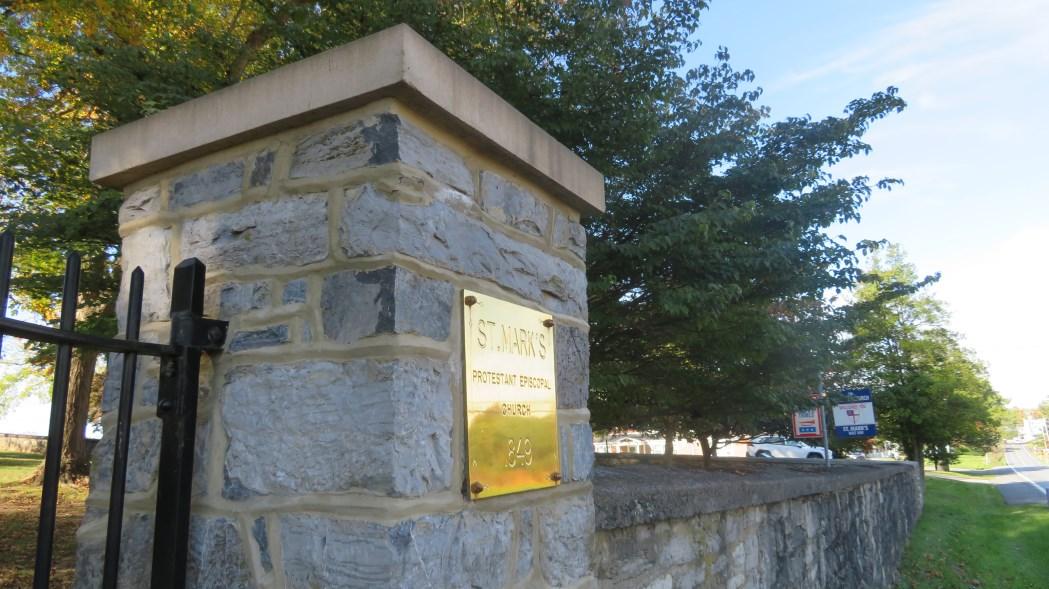


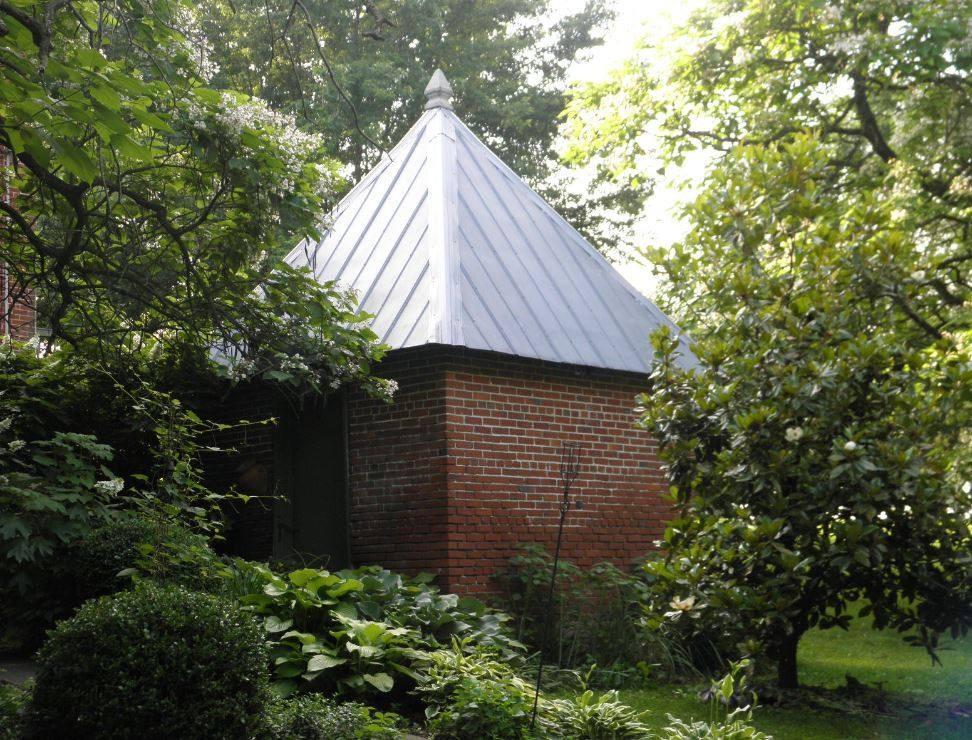
Design Guidelines 37
Stone Fence along Dam #4 Rd, WA
-II-275
Stone Walls at St Marks , WA-II-024
Summer Kitchen-Plumb Grove, WA-V-015
Photo Credit: CSHA
Smokehouse, Oak Springs Farm, WA-V-093
Photo Credit: CSHA
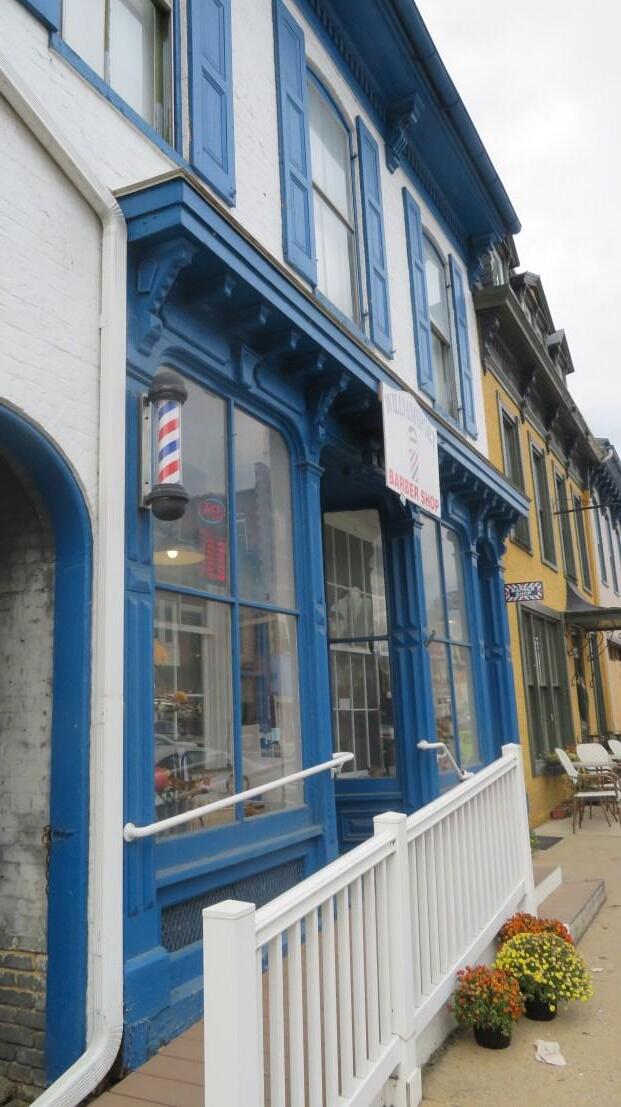

Commercial Buildings – 1890 to 1930
Commercial buildings dating from 1890 to 1930 are distinguished by large windows arranged in groups on their façades. Developed in Chicago in the 1890s, this style drew upon the structural innovation of steel-frame construction, which enabled much larger window openings than were possible with traditional bearing wall masonry. Beginning in the 1870s, molded, glazed terra cotta became a popular substitute for carved stone. It was used extensively to finish commercial building façades in the early twentieth century. Terra cotta was popular at this time because it could be used to mimic much costlier stone such as marble and granite.
• Vertical emphasis, typically 2-4 stories in height
• Flat roofs
• Masonry wall surfaces
• Three-part windows or projecting bay windows
• Decorative cornices
• Steel and beam construction
• Ground floor storefronts
Commercial Buildings – Post 1930
Art deco
• Sharp edge, linear appearance
• Smooth wall surface usually stucco
• Geometric forms, zigzags and chevrons or stylized motifs on the façade
• Low relief decorative panels
• Towers and vertical elements
• Strips of windows with decorative panels
• Stepped or set back front façade
• Fluting around doors and windows
38 Historic Structures
Williamsport Barbershop, WA-WIL-020
Professional Arts Building
WA-HAG-057
Gas Stations—Post
1910
• Varied exterior materials including frame, rusticated concrete block, and stucco
• Historicized roofs, matching borrowed architectural style or flat roofs with very low slope
• Borrowed architectural styles to blend to surrounding neighborhood
• Box-Type Stations, which can be in the Art Moderne style
• Multi-use, structures that can include convenience store, restaurants or car repair garages attached
• Service bays
• Attached or detached canopies being flat or stylized
• Gas pumps that could be covered by canopies directly adjacent to structure or very close to a road right-of-way
• Signage indicating name or services
• Associated outbuildings (e.g., car washes, garages, storage sheds)
Additional Resources
Preservation Brief #46 The Preservation and Reuse of Historic Gas Stations


Design Guidelines 39
Himes General Store, Weverton Road, WA-III-031
Gas Station, Southeast corner of Wilson Blvd. and S. Potomac St., Hagerstown


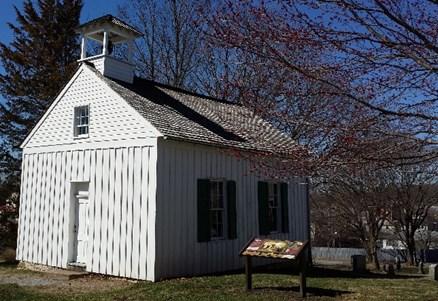

Ecclesiastical Architecture
Ecclesiastical architecture was dramatically influenced by English architect James Barr’ s Anglican Church Architecture. It was first published in 1842 and was dedicated to the Oxford Society for Promoting the Study of Gothic Architecture. A second edition followed in 1843, and a third, in 1846
• Simple one storied, gable roofed structures
• Masonry structure walls
• Gothic or Romanesque revival architectural characteristics including pointed arch windows, which may include tracery and doors with transoms
• Single or double entrance doors
• Steeples, towers with bells
• Varied sash configurations but may include decorative stained glass in multiple bays
• Outbuildings, adjacent cemeteries, and structures such as stone walls may contribute to landscape and be similarly styled
40 Historic Structures
Tolson’s Chapel, WA-II-202
Church of the Brethren, WA-II170
St. Luke’s Episcopal Church, WA-III-012 Manor
Schoolhouses
Early twentieth century schoolhouses in Washington County tended to be one room, single-story structures. The exterior materials of the school houses varied with wood, brick and stone being common. The building shape is usually rectangular or square and often includes a gable end roof with prominent front entrances. Several bays of windows allowed adequate lighting of the classroom. The buildings may also include a bell or belfry top. There are many surviving school houses in the County that have been repurposed into uses such as community buildings, museums, or commercial businesses.
Historic Markers
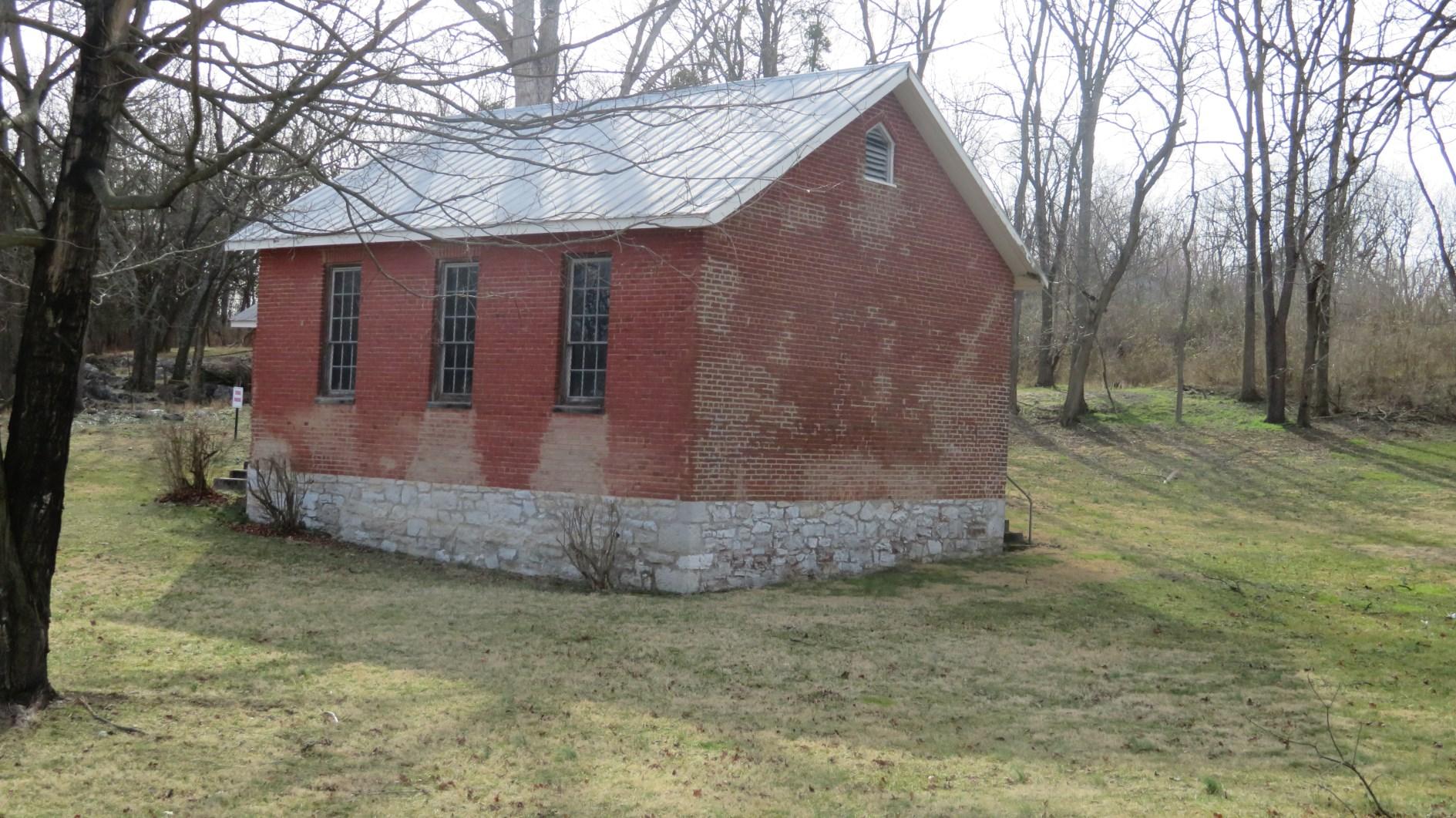
Washington County is bordered on the north by one of the most famous boundaries in the United States, the Mason-Dixon Line. Settling a property dispute between the Penns of Pennsylvania and the Calverts of Maryland, these mile markers were decorated and placed at one mile intervals along what is now the northern State Line of Maryland. These markers are large blocks of limestone with engravings on each State’s side. The historical significance of these mile markers and the line they mark spans from colonial times through the Civil War.
The National Road, or Old National Pike as it’s also known, has historical markers along the north side of its length. The State of Maryland owns the stones as they reside in the right-ofway. The first stone was placed at the Baltimore Courthouse; they continue along the route throughout the County at one mile intervals. These are much smaller than the Mason-Dixon markers. They are engraved on the side facing the road indicating the distance to “B” or Baltimore. These stones are also varying in their material. Some are limestone; some are quartzite. These stones and other historic markers are often on the National Register and should never be moved, stabilized, or otherwise altered without the express consent and supervision of the Maryland Historical Trust.
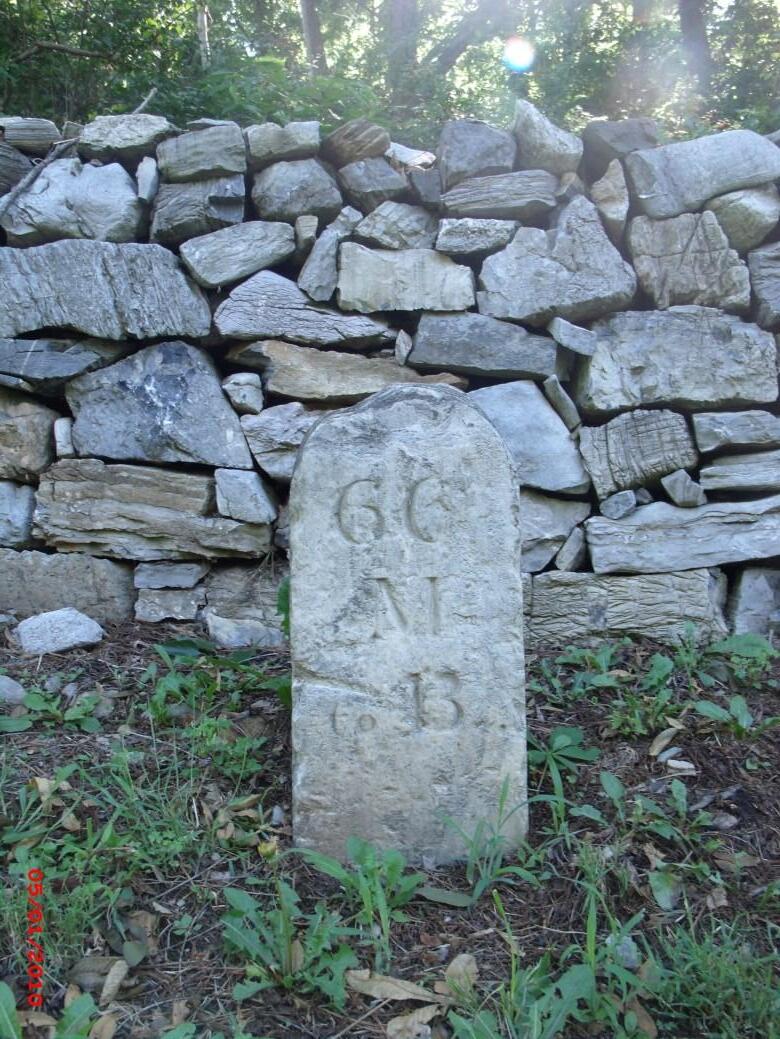
Design Guidelines 41
Wilson School, WA-V-007
National Road Mile Marker, WA-II-728
This page is intentionally left blank
42 Historic Structures
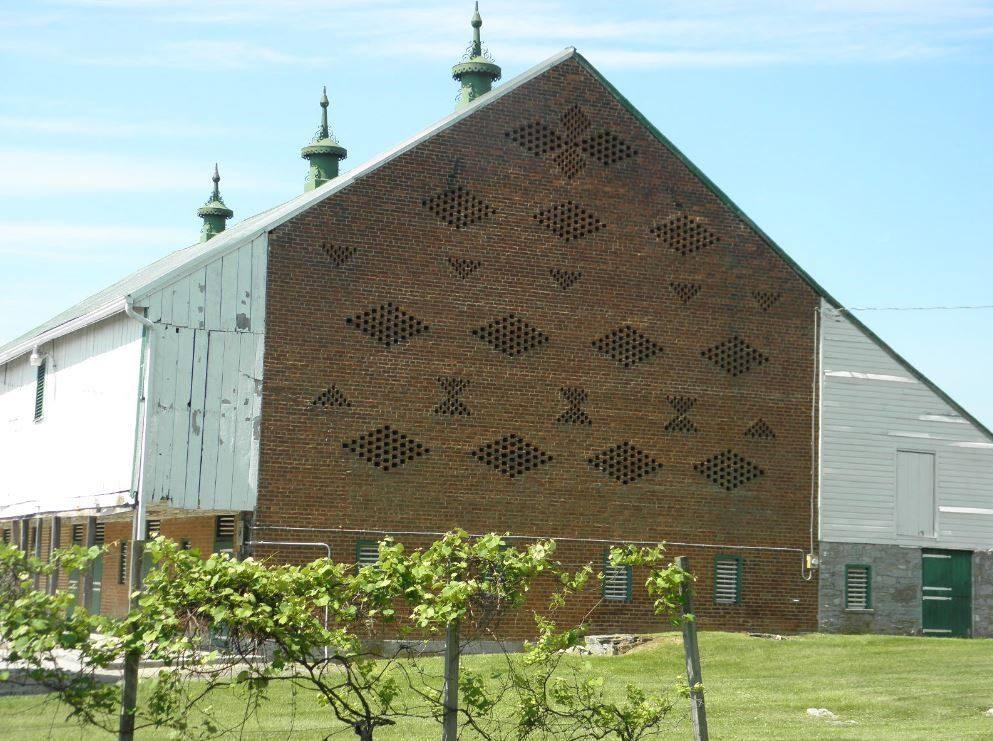
Standards for Review
Secretary of the Interior’s Standards for the Treatment of Historic Properties with Guidelines for Preserving, Rehabilitating, Restoring & Reconstructing Historic Buildings provides an explanation of treatments for historic properties and their respective standards and guidelines. The Standards were originally developed in 1976 and have had subsequent updates. The HDC will use the most recent edition published by the National Park Service in conjunction with the Washington County Historic Guidelines for review. The Standards were originally developed to ensure that properties receiving federal funding or federal tax benefits have a consistent review. They are written to apply to a wide variety of resource types and have found wide use at the Federal, State and Local levels as a basis for design guidelines.
Design Guidelines 43
Barn at the Dennis Farm, WA-V-025
Photo Credit: CSHA
Four treatment types are described in the Secretary of Interiors (SOI) Standards: Preservation, Restoration, Reconstruction, and Rehabilitation.
Preservation is the maintenance and repair of existing historic materials or preservation of the structure in its current form with little or no replacement or new addition.
Restoration aims to return a building to a specific time period, acknowledging the need to remove changes since that time and recreate previous aspects that have been removed.
Reconstruction re-creates vanished or non-surviving portions of a property for interpretive purposes.
While these three treatments may be applied at the owner’s request during HDC review, The Secretary of the Interior’s Standards for Rehabilitation are the basis of the Washington County Historic Design Guidelines.
Standards for Rehabilitation
Rehabilitation is defined by the SOI as the act or process of making possible an efficient compatible use for a property through repair, alterations, and additions, while preserving those portions or features that convey its historical, cultural, or architectural values (36 CFR 68.2(b)). The Standards are as follows:
1. A property will be used as it was historically or be given a new use that requires minimal change to its distinctive materials, features, spaces, and spatial relationships.
2. The historic character of a property will be retained and preserved. The removal of distinctive materials or alteration of features, spaces, and spatial relationships that characterize a property will be avoided.
3. Each property will be recognized as a physical record of its time, place, and use. Changes that create a false sense of historical development, such as adding conjectural features or elements from other historic properties, will not be undertaken.
4. Changes to a property that have acquired historic significance in their own right will be retained and preserved.
5. Distinctive materials, features, finishes, and construction techniques or examples of craftsmanship that characterize a property will be preserved.
44 Historic Structures
6. Deteriorated historic features will be repaired rather than replaced. Where the severity of deterioration requires replacement of a distinctive feature, the new feature will match the old in design, color, texture and, where possible, materials. Replacement of missing features will be substantiated by documentary and physical evidence.
7. Chemical or physical treatments, if appropriate, will be undertaken using the gentlest means possible. Treatments that cause damage to historic materials will not be used.
8. Archeological resources will be protected and preserved in place. If such resources must be disturbed, mitigation measures will be undertaken.
9. New additions, exterior alterations, or related new construction will not destroy historic materials, features, and spatial relationships that characterize the property. The new work will be differentiated from the old and will be compatible with the historic materials, features, size, scale and proportion, and massing to protect the integrity of the property and its environment.
10.New additions and adjacent or related new construction will be undertaken in such a manner that, if removed in the future, the essential form and integrity of the historic property and its environment would be unimpaired.
These Standards are the underlying basis of the SOI guidelines which provide explanations that are applicable to a wide range of projects. The County’s Design Guidelines are meant to supplement and further provide local examples.
Design Guidelines 45
This page is intentionally left blank
46 Historic Structures
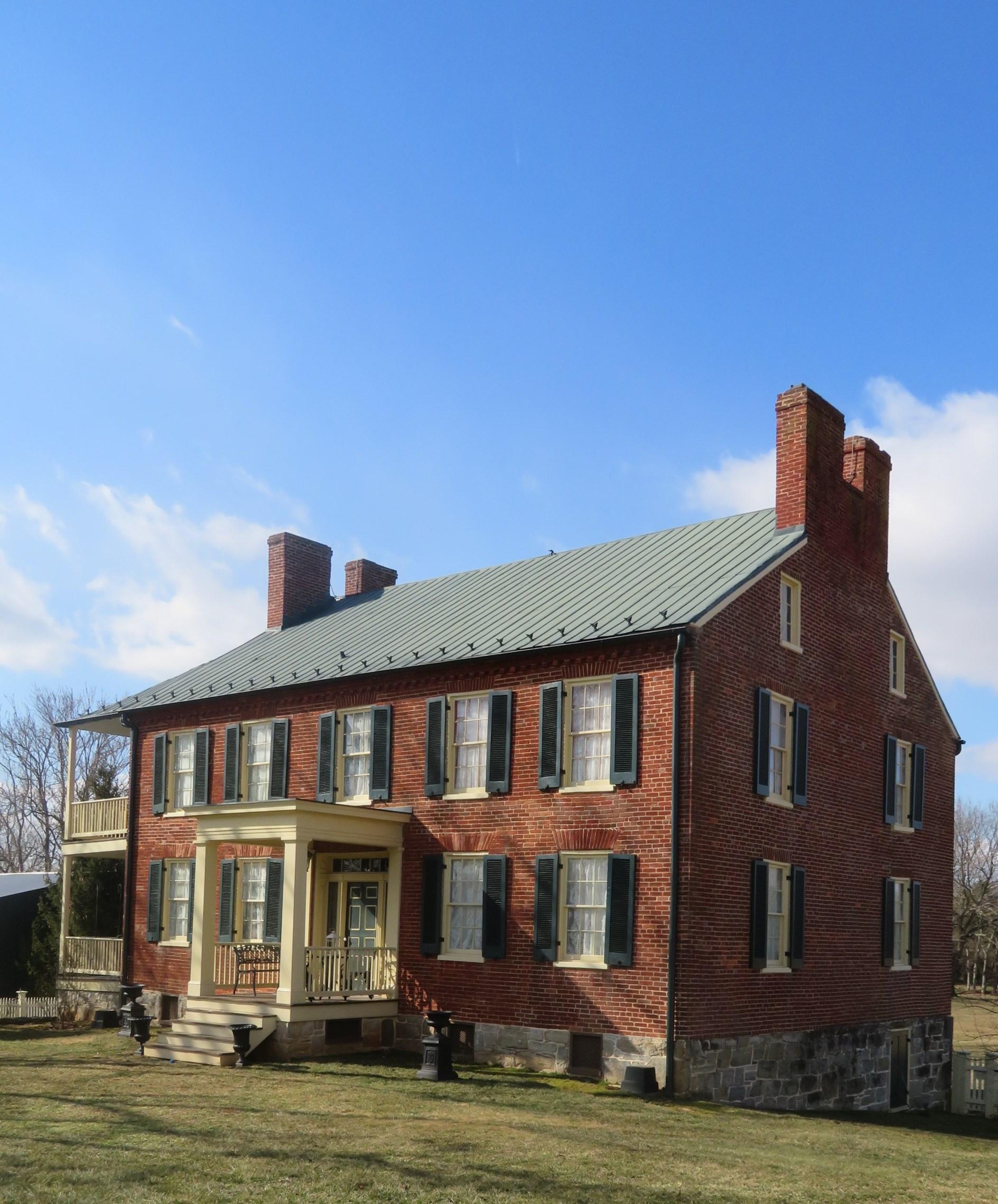
These Design Guidelines are made available to assist owners of historic buildings in understanding how historic preservation policies affect their plans to maintain, preserve, or enhance their properties. The information provided is intended to assist with planning and implementing projects in a way that is mindful of the historic nature of both the property being reviewed and its surroundings.
If appropriate, the Historic District Commission may reference specific treatment guidelines from The Secretary of the Interior’s Standards for Rehabilitation that may not be listed in this document either due to summarization or update to the Secretary’ s documentation. References to appropriate documentation will be made in any Certificate of Appropriateness that is issued. It is recommended that the Guidelines included be consulted before application with the appropriate County agency or before applying for a Certificate of Appropriateness with the Historic District Commission.
Design Guidelines 47 Guidelines
Gum Tree Farm, WA-II-371
These guidelines acknowledge that buildings have been and will be altered over time. They are not meant to discourage change but rather to encourage compatible and sensitive change to the site and existing buildings. It is important to note that the Commission is first and foremost a resource and can provide consultation regarding proposed changes before work has begun or applications for permits have been made. In fact, this is preferred, especially in cases where Local, State, or Federal tax credits may be sought.
Several key themes to the guidelines should be considered no matter the topic discussed. They include:
1. Identify, retain, and preserve features that are important in defining the overall historic character of the building or site. If repair or replacement is necessary, use materials that match the original as closely as possible. The Commission can help to identify key site and building features, which is the first priority before standards and guidelines can be applied.
2. Protect and Maintain features by practicing routine maintenance and ensuring site protection through documentation of the resource and consideration of resource details such as proper drainage around the site and its resources.
3. Repair or replace damaged or missing units using materials that match the original as closely as possible. If a feature is missing, it should be replaced based on documentary or photographic evidence. If no evidence of the design of the feature exists, a new design compatible with similar details existing on the building or site as well as the overall character of the building or site should be used.
Setting and Site
One of the seven considerations for resource integrity for National Register consideration is setting. Setting is the large scale physical environment of a historic property. The setting extends beyond the features directly on a parcel and can involve the greater surrounding landscape. The relationship of buildings to each other, setbacks, fence patterns, views, circulation systems, and landscaping all contribute to the setting. The building site consists of a historic building or buildings, structures, and associated landscape features and their relationship within a designed or legally-defined parcel of land. A site may be significant in its own right or because of its association with the historic building or buildings. The Zoning Ordinance has an additional definition for the term site, which includes the physical as well as the visual elements. (Washington County, Maryland, 2021, p. 190)
48 Historic Structures Themes: Identify Retain Preserve
Viewsheds
The views to and from historic resources, districts, or rural communities contribute significantly to their character. Viewsheds can be large in scale, such as the viewshed around the Antietam National Battlefield or smaller such as the view from a window or fixed point around a historic structure. The Zoning Ordinance has measures in place, such as the Antietam Overlay and Historic Preservation Overlay, which offer protection to viewsheds around identified resources. But it’s important to acknowledge the varying scale of viewsheds and impact their integrity can have on the context of the resources in the County.
Site and Landscape Design Features
Landforms, Plantings, and Landscapes
Landforms include, but are not limited to, terraces, berms, and grading on a site. Trees, hedgerows, shrubs, cultivated fields, and formal and informal gardens are among the historic plantings and landscapes that are important historic features in Washington County. Along with landforms and features, they provide some of the greatest impact on the setting for many of the historic resources in the County. Unlike most materials used in historic buildings and structures, plantings and landscapes are subject to change from season to season and from year to year. Mature plantings often set the context of both public and private spaces in historic structures.
Fences and Walls
Throughout the County a variety of fences and walls mark property boundaries, confining livestock, protecting crop fields, and providing security and privacy. The materials and construction range from metal to stone to wood; however, stacked or mortared limestone or wood are the most common. Stylistically, the design of fences and walls is often related to the principal structures on the property. Distinctive gates and corner posts are also distinguishing features of many historic fences and walls.
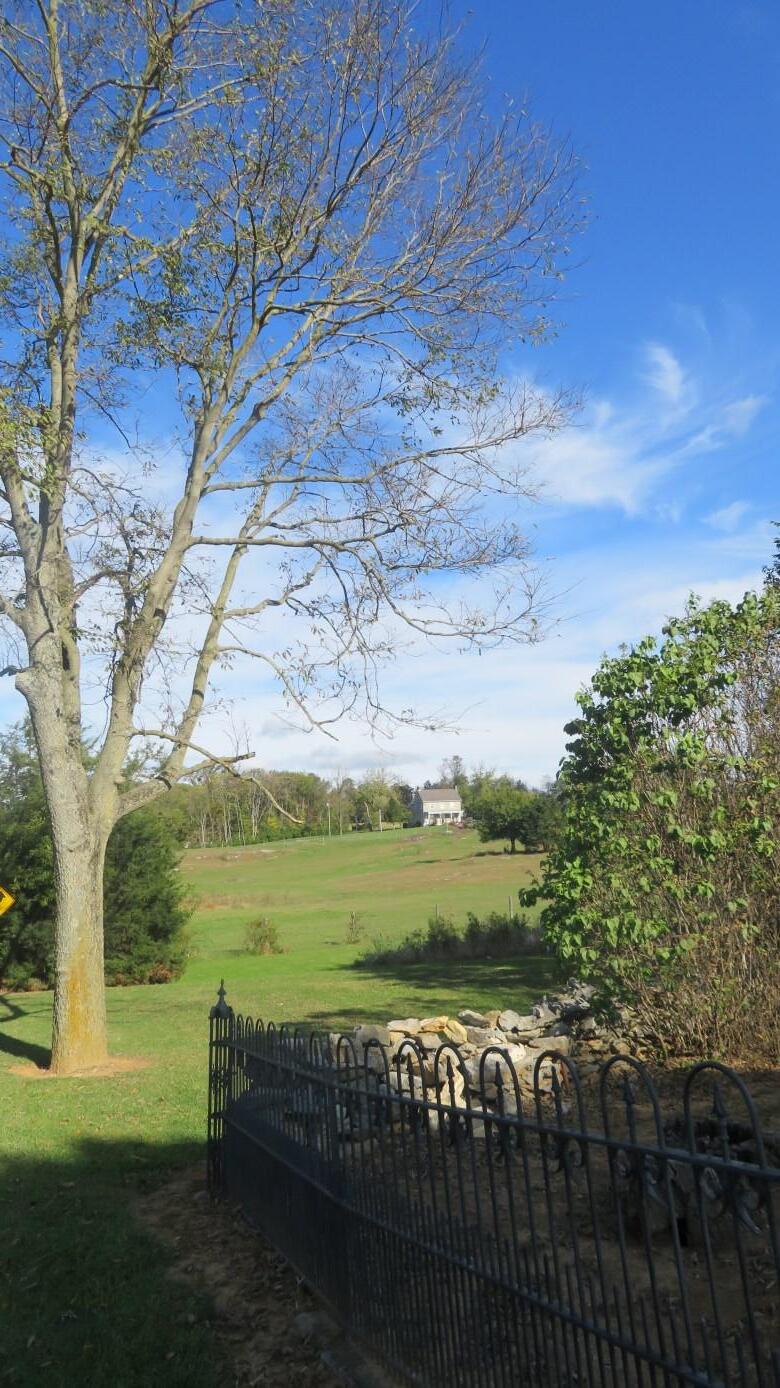
Design Guidelines 49 Protect Maintain Repair Replace
-II-170 Looking North toward WA-II-184
Manor Church of the Brethren, WA
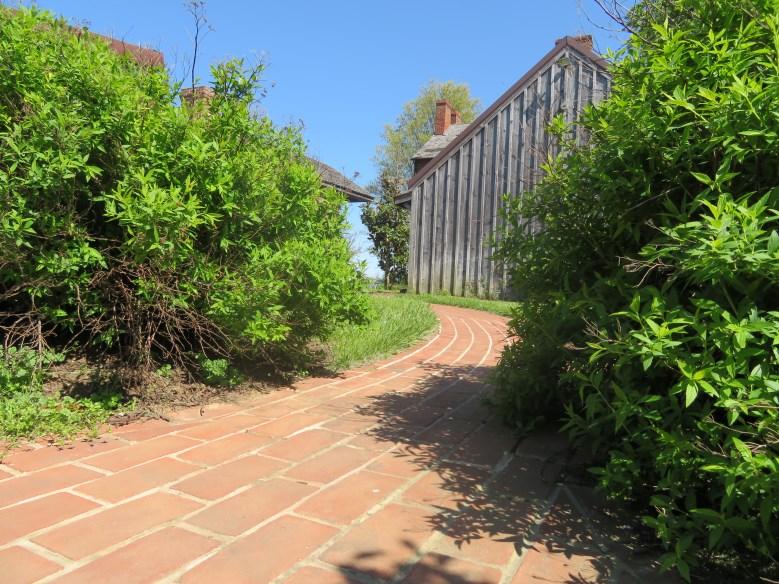
Circulation Systems (Driveways, Walkways, and Parking Areas)
Circulation systems serve the purpose of allowing movement of pedestrians and vehicles into and around historic resources. The materials, extent, and pattern of these systems can vary dramatically between urban, suburban, and rural settings. More urban or suburban settings tend to include short, straight, paved concrete or asphalt driveways. Sidewalks and walkways are variable in material, as well, but usually parallel the streets and are separated from private walks by a step or change in grade. Buildings in these areas are typically facing the street. Parking areas are either on-street or in asphalt parking lots. The more rural systems tend to include long, curved driveways with a gravel base. The rural systems also sometimes include gateposts flanking the entry to the drive and trees to either side of the driveway. Walkways constructed of gravel, concrete, brick, or stone are still found in the rural area often linking formal or informal parking areas, gardens, or entrances to the building.
Guidelines For Existing Setting and Site
1. Features should not be moved or relocated, nor should circulation routes be interrupted.
2. Spatial relationships between buildings on sites should be maintained.
3. If possible, intrusions into viewsheds should be removed or masked with appropriate vegetation.
4. Existing plantings should be maintained by fertilizing, pruning, treating for disease, or in other appropriate ways. If replacement due to deterioration or disease is necessary, it should be a plant of similar size and texture. Use of native species of plants is encouraged when appropriate. Invasive species should be avoided or removed if possible. The Commission recommends referencing the Maryland Department of Natural Resources (MDDNR) or United States Department of Agriculture’s (USDA) invasive species information when considering changes to plants.
5. Maintain major patterns of vegetation in working landscapes.
6. Any changes made to features surrounding a historic resource should be compatible with the existing. An archaeological assessment should be done before making any changes.
7. Disturbance to the earth and terrain should be minimized, especially around building foundations.
8. Maintain proper site drainage to prevent water damage.
9. See also Key Themes. (p.48)
50 Historic Structures Themes: Identify Retain Preserve
Walkway, Plumb Grove, WA-V-015
Guidelines for Proposed Setting and Site
The guidelines for existing site details should be consulted in addition to those below.
1. Select new plantings and design changes to landscapes adjacent to historic properties to be compatible with the existing. Locate new plantings so that they maintain or enhance the property’s historic character and its context.
2. Consideration as to whether, at maturity, plantings will affect building systems, such as gutters, foundations, should be given in design.
3. The location of new site features, including fences, walls, parking, should be compatible with the overall character of the historic resource and its landscape. Review of the proposed design will include materials, height, configuration, scale, and details.
4. Consider screening parking areas or other added site features when appropriate and feasible.
5. Existing historic circulation patterns should be considered foremost in the design and the location of new parking areas. They should not be within the primary viewshed of a historic resource or landscape.
6. Access points for vehicles or pedestrians to parking areas should minimize impacts on the historic landscape and its rhythm through use of rear parking and alley access where feasible.
7. See also Key Themes. (p.48)
Additional Resources:
Preservation Brief #36 Protecting Cultural Landscapes: Planning, Treatment and Management of Historic Landscapes
Secretary of the Interior’s Standards for the Treatment of Historic Properties and Guidelines for the Treatment of Cultural Landscapes
MD DNR Invasive Species Information https://dnr.maryland.gov/Invasives
USDA Invasive Species Information https://www.invasivespeciesinfo.gov/
Design Guidelines 51 Protect Maintain Repair Replace

Patios, Decks, and Other Site Features
Patios, decks, and other site features such as pools or ponds are a common feature on many historic properties throughout the County, although they may not be historic in nature. In many cases, patios, paved outdoor areas adjoining the structure, are more appropriate for historic structures than a deck. Decks, horizontal wood plank construction adjoining the structure, are more appropriate and common in the County on late-twentieth-century historic structures. Many of the County’s identified resources are nineteenth century or earlier making decks less appropriate. These site features are also often tied to the circulation network of the overall site. Water features such as pools or ponds may contribute to the historic setting of the site or have been added to extend the living space on the property.
Guidelines for Patios, Decks and Other Site Features
1. Damage to the principal structure and/or obstruction of its character-defining features by the change or addition of site features should be minimized.
2. New features should be sited to avoid demolition of contributing structures.
3. Changes to the existing design or the design of new patios, decks, and other site features should be compatible with the form, scale, proportions, materials, and details of the principal building.
4. Locate new patios, decks, and other new site features so that the existing significant visual and spatial characteristics of the historic resource are maintained. This guideline often means avoiding siting of these features on the primary façade.
5. Locate new patios, decks, and other site features so that significant viewsheds are maintained or enhanced. Screening should be used to minimize impacts to the landscape.
6. See also Key Themes. (p.48)
52 Historic Structures Themes: Identify Retain Preserve
Deck, Oak Springs Farm, WA-V-093
Photo Credit: CSHA
Archaeological Resources
It is common for the County to have sites that are solely archaeological in nature, but most historic sites also have some information that can be gathered through archaeological investigations. Archaeology is the study of human life in the past through the analysis of material remains. Study areas may be at varying levels of visibility on a site. The artifacts could be anything from tools to decorative pieces. Archaeological resources help to bridge a knowledge gap about the use of a property that can occur between written and oral history.
Archaeological assessments can have several phases. Phase I typically involves examining site records, interviewing local historians as well as maps, aerial photography, or deeds. Shovel tests or sampling may occur. The main goal of this phase is to determine if resources are present. Phase II involves subsurface site work through test areas to further identify the extent and gather sufficient information to determine if the site is National Register eligible. More extensive research will also occur at this phase. Phase III involves recovery and mitigation of the resources. Phases I and II should provide areas to avoid so that Phase III would be limited if even necessary.
Guidelines for Archaeological Resources
1. Professional archaeological assessments should be made before any ground disturbing projects take place. Projects that exceed twenty thousand square feet of disturbance are especially encouraged to complete a Phase I assessment. This area of disturbance coincides with other required County reviews such as grading and forest mitigation. Assessments are recommended early in the design process.
2. To the extent feasible with other state and local regulations, ground disturbance should be minimized for areas that have not had full archaeological assessments completed.
3. Locate new construction so that archaeological resources are not disturbed.
4. If protecting archaeological resources during construction is not feasible, conduct archaeology and recordation using best practices before construction begins.
5. If locating the new construction so that archaeological resources are not disturbed is not feasible, protect the resources during construction using best practices.
6. See also Key Themes. (p.48)
Additional Resources:
Standards and Guidelines for Archeological Investigations in Maryland– MHT
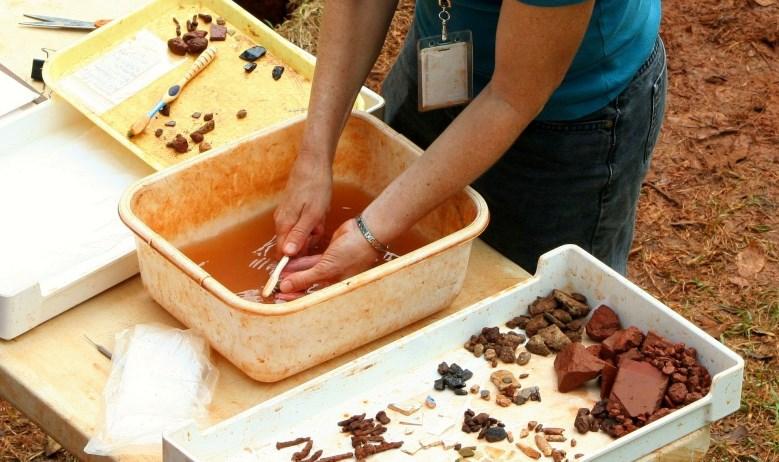

Design Guidelines 53 Protect Maintain Repair Replace
Investigations at the Saylor House, WA-I-132
Photo Credit: WCHT Artifact cleaning
Photo Credit: Pixabay, JamesDeMers

Cemeteries
Cemeteries are also important sources of information about the history of Washington County. Family plots on private rural properties are not uncommon. Larger cemeteries, such as those associated with churches or private entities, are also prevalent. Regardless of the scale, these cemeteries are sites containing features that contribute to the cultural landscape, and they should be preserved. The State of Maryland has protections in place for the disturbance of human remains that extends to the burial grounds of the remains. Should human remains be discovered accidentally, the law requires notifying the County States Attorney. Features of importance in the cemetery may include the gravestones, fences, gates, circulation paths, and landscaping.
If cleaning or repairs to markers, gravestones, or memorials are needed, the material should first be identified, and conditions should be documented. Some surfaces may be too delicate for cleaning. Cleaning should be performed using the gentlest means possible, and chemical cleaners should not be used before consulting a masonry conservator.
If a citizen is unsure of the status of a cemetery within the County’s records, the Department of Planning & Zoning should be contacted to determine if it is identified for planning purposes.
Guidelines for Cemeteries
1. Gravestones, fences, gateways, and other significant features of cemeteries should be retained and preserved.
2. Leaning, loose, or toppled gravestones should be stabilized, righted, and re-anchored using techniques and tools appropriate to the type of historic stone comprising the marker.
Washington County Cemeteries Story Map Washington County GIS Page Cemetery, Manor Church of the Brethren, WA-II-170
3. Deteriorated fences, gateways, and other significant features of cemeteries should be repaired using the same materials or materials that are like the original in scale, texture, design, and color.
4. Weeds and overgrown landscape materials should be controlled.
5. Fertilizers, biocides, and heavy landscaping equipment that may damage markers, headstones and memorials should be avoided.
6. See also Key Themes. (p.48)
Additional Resources:
Preservation Brief #48 Preserving Grave Markers in Historic Cemeteries
54 Historic Structures Themes: Identify Retain Preserve
Existing Accessory Buildings
Accessory buildings are those that support the use of the main building on the same parcel of land. In rural areas, the buildings had a variety of domestic and agricultural uses. Storage sheds, garages, kitchens, wells, and privies were located near the main house. Barns and other agricultural structures were distanced from the residential uses, but remained grouped for agricultural production. Many accessory buildings are significant or contribute to the overall building site due to their own unique characteristics. Agricultural buildings as defined in the zoning ordinance are not reviewed by the Commission. Other accessory buildings in more urban settings may include those listed above with the addition of more mixed uses such as a commercial gas station sharing the property with a single family home. Often the structures are located to the rear of the primary building and may not be visible from a right-of-way but they still contribute to the overall site.
Guidelines for Existing Accessory Buildings
1. Accessory buildings that significantly contribute to the principal structure or are significant should be retained, well-maintained, and preserved, including their siting, orientation, design, scale, materials of construction, and detailing. Adaptive reuse of these structures to enable continued utility of the structure is encouraged when necessary.
2. Deteriorated accessory buildings, and their distinctive features and details, should be repaired if necessary, using the same materials or ones that are similar in scale, form, texture, and color. Ordinary maintenance is encouraged.
3. Those that are deteriorated beyond repair may be replaced with new ones that should resemble the original in siting, scale, proportion, fenestration, materials, and color as closely as possible.
4. Fading, painted, historic mural signs –“ghost signs” – on the exterior of the structure should be left as found.
5. See also Key Themes. (p.48)
Additional Resources
Preservation Brief #20 The Preservation of Historic Barns


Design Guidelines 55 Protect Maintain Repair Replace
Outbuilding, WA,-III-020
Smokehouse, Oak Springs Farm, WA-V-093
Photo Credit: CSHA
Rehabilitation of Existing Buildings
As mentioned previously, rehabilitation is defined by the Secretary of the Interior (SOI) as the act or process of making possible an efficient compatible use for a property through repair, alterations, and additions, while preserving those portions or features that convey its historical, cultural, or architectural values (36 CFR 68.2(b)). This standard treatment is the most widely applicable in the County and, therefore, the accepted reference for the Commission.
At this time the Commission is tasked only with reviewing the exterior of existing buildings, additions, or new construction within areas of review. The SOI Standards and Guidelines also address building interiors, and the Commission encourages their use. The focus of the following sections will be exterior elements of historic structures, or those elements contributing to the character of the site.
Building Exteriors
Building exteriors are comprised of the walls, roofs, windows, doors, projections, porches, and foundations. These elements include additional features that can have both functional and decorative details. Many buildings in the County combine materials for the exterior walls or are constructed with decorative façades. The combination can be a design choice or relate the story of the building’s changes over time. These variations also mean that many of the structures do not fall into a single architectural style. For that reason, architectural style should not be the only consideration in applying a treatment and guidelines to a property. It is important also to identify and document a historic building through its use of design principles:
1. Massing refers to the general shape of a building in terms of its depth, width, and height.
“A building’s massing is derived from the articulation of its façade through the use of dormers, towers, bays, porches, steps and other projections. These projections significantly contribute to the character of the building and, in town, the character of a street.” (Calvert County, 2001)
2. Scale refers to the size of the building in relation to adjacent structures or of individual elements to each other and often in relation to an average-sized human being. Most buildings in the rural area of the County are human scaled meaning they are designed to be comfortable for an average person. There are more monumental buildings of a grander scale in the County, such as the Courthouse.
56 Historic Structures Themes: Identify Retain Preserve
3. “Proportion is the relative dimension of elements of a building to each other and to its overall façade. Often proportions are expressed as mathematical ratios, drawn from the architectural theories of ancient Greece and Renaissance Italy. For example, many historic buildings designed in the Classical Revival style use mathematical proportions to locate and size windows, doors, columns, cornices and other building elements.” (Calvert County, 2001)
4. Rhythm is “the spacing and repetition of building façade elements, such as windows, doors, belt courses and the like. The space between freestanding buildings in towns, setbacks from roadways, as well as the height of roofs, cornices, towers and other roof projections establishes the rhythm of a street.” (Calvert County, 2001)
Several key themes to the guidelines should be considered no matter the topic discussed and they include:
1. Identify, retain, and preserve features that are important in defining the overall historic character of the building or site. If repair or replacement is necessary, use materials that match the original as closely as possible. The HDC can help to identify key site and building features. This step is the first priority before standards and guidelines can be applied.
2. Protect and maintain features by practicing routine maintenance and ensuring site protection through documentation of the resource and consideration of details such as proper drainage around the site and its resources.
3. Repair or replace damaged or missing units using materials that match the original as closely as possible. If a feature is missing, it should be replaced based on documentary or photographic evidence. If no evidence of the feature’s design exists, a new design compatible with similar details existing on the building or site as well as the overall character of the building or site should be used.
Additional Resources:
Preservation Brief #16: The Use of Substitute Materials on Historic Building Exteriors
Preservation Brief #17: Architectural Character Identifying the Visual Aspects of Historic Buildings as an Aid to Preserving their Character
Preservation Brief #32: Making Historic Properties Accessible
Preservation Brief #37: Appropriate Methods for Reducing Lead-Paint Hazards in Historic Housing
Preservation Brief #47: Maintaining the Exterior of Small and Medium Size Historic Buildings
Design Guidelines 57 Protect Maintain Repair Replace
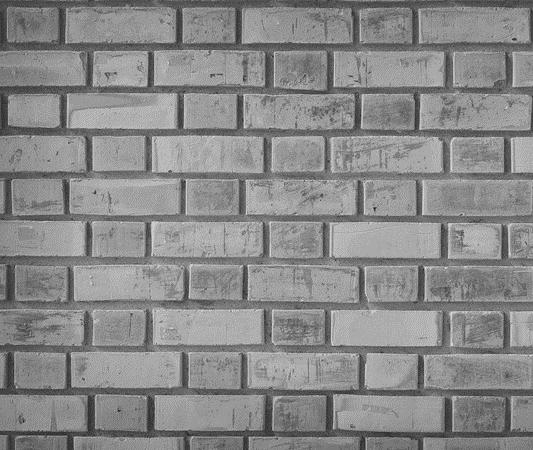
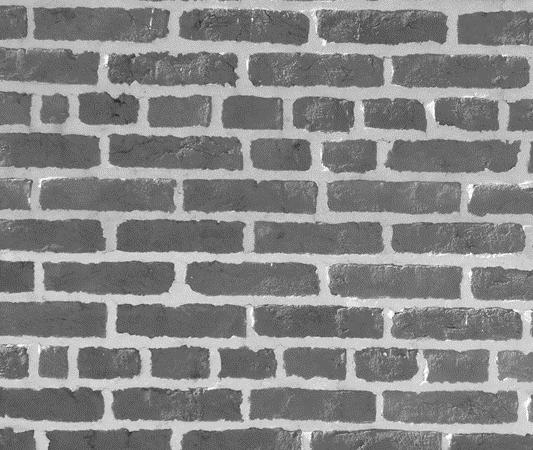

Masonry Exteriors
Brick, concrete block, and stone are common building materials for historic buildings in Washington County, either for entire walls and chimneys or for foundations. Masonry can also be found in brackets, railings, cornices, window architraves, door pediments, steps, and columns. Aside from the masonry itself, the tooling, bonding patterns, coatings, and color are all important to defining the building.
Bricks either handmade or machine made have varying degrees of durability. Brick is used in the construction of structural walls through a process of laying courses of brick in a pattern to achieve a bond. Running bond, Common bond, English bond, and Flemish bond are all found in structures in Washington County. The name of the bond describes the header (short end of the brick) and the stretcher (long end of brick) pattern.
Concrete block was being produced by the early twentieth century. It was an inexpensive building material that could be molded into shapes that resembled more traditional materials. Concrete block was used for building foundations and other utilitarian structures such as barns, milk houses, and garages. Rusticated concrete block structures are also prevalent. (Murphy & Dittenhafer Architects for Frederick County, 2021)
Stone is a very common construction material in the County. Many structures utilize fieldstone or rubble which has routed edges or an irregular shape. Quarried stone is used in structures that tend to have cut straight edges and may be referred to as Ashlar.
Guidelines for Masonry Exteriors
1. If a masonry wall has historically been painted, it should continue to be painted, ideally in colors that are sympathetic to its historic color scheme. Remove paint from historically painted walls only in preparation for repainting. Avoid painting historically unpainted masonry walls.
2. If cleaning a masonry wall is appropriate, it should be undertaken with the gentlest means possible. Typically, this means using water, detergent, and brushes. Power washing, chemical cleaning, or more aggressive methods should be used only if the gentlest means does not work.

58 Historic Structures Themes: Identify Retain Preserve
Flemish Common/American Stretcher Header
Stretcher
3. Re-pointed mortar joints should match the original in size, depth, profile, color, composition, and finishing detail. The type of mortar joint used contributes to the character of a masonry wall. Examples of mortar joints include struck, concave, weathered, raked, flush, vee, or extruded. Avoid the use of incompatible mortar and retain material and composition when possible. “Mortars for repointing should be softer or more permeable than the masonry units and no harder or more impermeable than the historic mortar to prevent damage to the masonry units.” (Preservation Brief #2: Re-pointing Mortar Joints in Historic Masonry Buildings)
4. Applying waterproof coatings to masonry walls can cause moisture to be trapped inside a masonry cavity. Waterproof coatings should be applied only after careful consideration and professional consultation.
5. See also Key Themes. (p.57)
Additional Resources:
Preservation Brief #1: Assessing Cleaning and Water-Repellent Treatments for Historic Masonry Buildings
Preservation Brief #2: Re-pointing Mortar Joints in Historic Masonry Buildings
Preservation Brief #6: Dangers of Abrasive Cleaning to Historic Buildings
Preservation Brief #7: The Preservation of Historic Glazed Terra-cotta
Preservation Brief #38: Removing Graffiti from Historic Masonry
7.
Mortar Joint Types

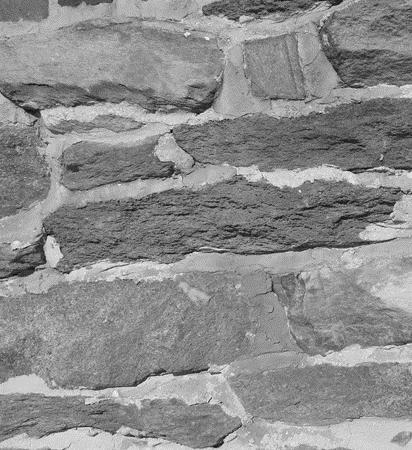

Design Guidelines 59 Protect Maintain Repair Replace
Rubble
Cut (Ashlar)
1. Struck 2. Concave 3. Weathered 4. Raked 5. Flush 6. Vee
Extruded

Wood Exteriors
Aside from being used as structural elements in the form of a log or frame walls in dwellings, wood is also the most common exterior wall treatment of historic buildings. Cornices, brackets, entablatures, shutters, columns, window architraves, doorway pediments, and balustrades are just some of the wood exterior character-defining features. The types of wood siding over the different structural bases in the County includes drop siding, clapboard, shingle, and vgroove. The material thickness and reveal should also be considered for sidings.
Guidelines For Wood Exteriors
1. Removal of exterior siding on a log structure for maintenance should be minimized. Log structures that were previously sided should be resided with an appropriate siding to avoid deterioration.
2. Remove paint only when there is surface deterioration; inspect painted surfaces regularly to ensure wood or paint is not damaged.
3. Remove paint only to the next sound layer using the gentlest means possible and do not leave surfaces exposed. Properly prepare painted surfaces to receive a new coat of paint that is compatible.
4. Repair minor deterioration using an appropriate wood consolidant. If the deterioration is severe, replace only the affected areas with wood that matches the original in size and profile.
5. See also Key Themes. (p. 57)
Additional Resources:
Preservation Brief #8 - Aluminum and Vinyl Siding on Historic Buildings: The Appropriateness of Substitute Materials for Resurfacing Historic Wood Frame Buildings (rescinded) See PB #16
Preservation Brief #10 – Exterior Paint Problems on Historic Woodwork
Preservation Brief #26 - The Preservation and Repair of Historic Log Buildings
60 Historic Structures Themes: Identify Retain Preserve
Siding Profile 1. V-Groove 2. Clapboard 3. Drop (German) 4. Shingle 5. Board and Batten

Siding Photos
1. V-Groove
2. Clapboard
3. Drop (German)
4. Shingle
5. Board and Batten
Design Guidelines 61 Protect Maintain Repair Replace
Photo Credit: David Angel on Unsplash
Photo Credit: Bruno Mira on Unsplash
Photo Credit :Alejandro Molina García on Unsplash
Photo Credit: Wokandapix on Pixabay
Rufus Wilson Store, WA-V-074
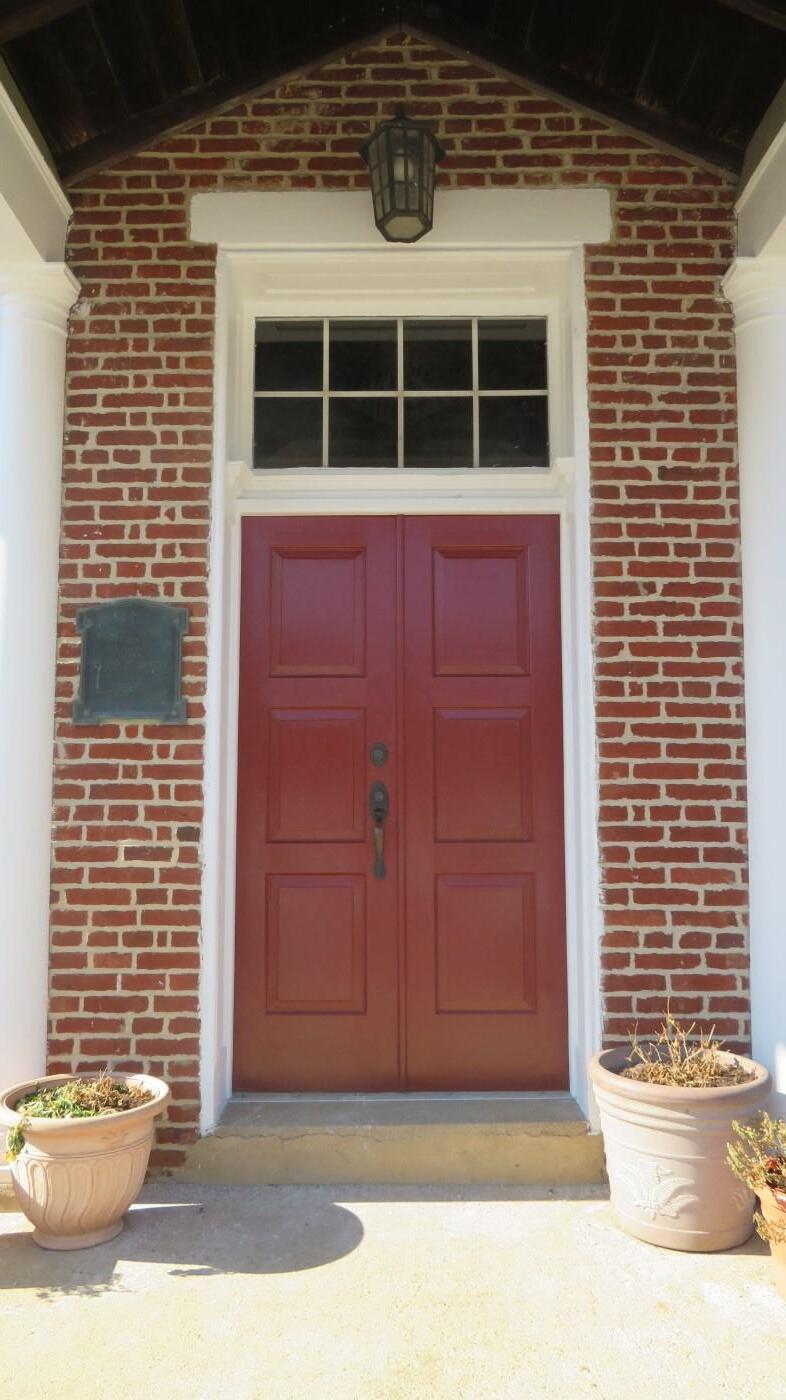
Entrances
The variation in architectural styles in the County, within both commercial and residential buildings, means there is an equal variety of entrances and entrance locations on the façades. Entrances are often the focal point of the primary façade on a building, and the location of that entrance is key to a building’s character. Some historic homes originally housing a single family, may also have 2 entrances on the primary façade. This double entrance has led to some of these structures being converted to 2-family dwellings. Aside from the actual door, which is typically of wood or metal construction, the entrance to a structure has many other components that are equally important. Surrounds, frames, sills, transoms, fanlights, and sidelights of doors are all key elements of an entrance.
Guidelines for Entrances
1. It is not recommended that secondary façades have entrance changes in size, shape or location if such changes detract or confuse the primary entrance of the structure.
2. If a new opening is required, it should be on a secondary façade and not visible from the public right-of-way.
3. Weatherstripping and caulking to improve energy efficiency are acceptable.
4. Screen doors are usually appropriate on residential and sometimes appropriate on commercial buildings. On primary façades, screen doors should be constructed of wood or a material that is appropriate for the building and should not detract or fully cover the entry door. Secondary façades may have metal screen/storm doors, but use of careful installation should ensure minimized damage to the opening.
5. See also Key Themes. (p.57)
62 Historic Structures Themes: Identify Retain Preserve
St. Luke’s Episcopal Church, WA-III-012
Windows
While windows can be decorative focal points in the exterior of historic structures, a majority serve additional functional purposes. Windows provide a source of light to building interiors as well as a method of ventilation. These openings weigh heavily into the design principles discussed earlier, and changes to the configuration of windows individually or within the façade can drastically affect the integrity of the historic structure. Typical window casing and sash materials include either wood or metal. The shape of the windows varies across the many architectural styles represented in the County and the function of the window or building. Residential structures typically have wood windows; commercial structures may have either metal or wood windows.
The portion of a window that is most noticeable is often the sash. This includes the frame, any muntins, and the variable glazing (glass) configuration. Windows can have fixed, double or single hung, Jalousie, or casement functionality to the sashes to name a few. Historic windows are often described by referring to the number of panes in each portion of the sash. For example a window may be six over six double hung. This means there are 6 individual panes of glass separated by muntins, or other material, in both the upper sash and lower sash. It also means that both sashes can be opened independently.
Historically the technique for glass making allowed only for smaller pieces of glass, which were very expensive or highly taxed. If a historic wood window includes a larger number of smaller glass panes this could be an indication that the window is older than a window with a lower number of larger panes. Likewise some older vernacular structures may have smaller window openings allowing for less cost in glazing.

Aside from the openings themselves, there can be associated elements such as shutters, awnings, or storm windows. Shutters would be functional, providing privacy, protection from light, and airflow. They often have associated hardware, such as shutter dogs, which are both integral to function as well as being a decorative element. Storm windows and screens may exist as part of the design of a historic structure depending on the age, use, and architectural style of the building.
Many wood cased windows in historic homes can be repaired and weatherized to perform equal to or better than alternative material replacement windows such as vinyl double pane windows. It is important to remember that many historic windows have been in use for over 100 years in some of the County’s historic structures, while the life expectancy of a modern replacement window is only a quarter of that time.
Design Guidelines 63 Protect Maintain Repair Replace
Fanlight window
Rose Hill Entrance, WA-I-374
Photo Credit: WCHT

Guidelines for Windows
1. Preserve the position, number, and arrangement of historic windows in a building wall.
2. Openings should not be resized or enclosed on primary façades.
3. Wood windows on primary façades should not be replaced with windows constructed of alternative materials such as metal or vinyl. When replacing windows on a secondary façade, the HDC should be consulted to determine the appropriate design and material of the replacements.
4. Inappropriately designed, non-original windows should be replaced with appropriately designed ones based on documentary or photographic evidence. If no such evidence exists, the design of the replacement should be compatible with the character of the façade in which it is located.
5. Shutters and their hardware should not be replaced with new materials. Whether operational or not, they should be sized to appear to cover the window if closed.
6. Existing or replacement storm windows and screens should match as closely as possible the historic windows in size, profiles of sash and frame, color, and other character-defining features. In cases where exterior storm windows were not used historically, interior storm windows may be considered. Clear glass should be used for glazing all storm windows.
7. See also Key Themes. (p.57)
Additional Resources
Preservation Brief #9: The Repair of Historic Wooden Windows
Preservation Brief #13: The Repair and Thermal Upgrading of Historic Steel Windows
City of Hagerstown | YouTube | How to Repair a Historic Window Part I
City of Hagerstown | YouTube| How to Repair a Historic Window Part II
Historic Windows and Energy Efficiency by Sarah Donahue Wolff, Preservation North Carolina
64 Historic Structures Themes: Identify Retain Preserve
Fixed Pane
Single Hung
Casement
Double Hung
Jalousie






Design Guidelines 65 Protect Maintain Repair Replace 1.Glazing 2.Muntin 3.Sash 4.Sill 5.Stile 6.Rail 7.Trim 8.Jamb 9.Apron/Trim
Window Pane Configuration
4
2
5.
1. 2. 3. 4. 5.
10. Lintel and Keystone 11. Shutter 12. Shutter Dog
1. 9 over 6 2. 6 over 6 3.
over 4 4.
over 2
2 over 1






Roofs
A structure’s roof is one of the principal components of construction design. A roof can be considered a system comprised of framing, roofing material, flashing, and drainage components such as gutters and downspouts. The roof shape is a defining characteristic and typically falls into one of three categories: gabled, hipped, or flat. The roof shape is then further delineated by its slope, which can be low (less than 30 degrees) or steep (greater than 45 degrees). Architectural styles often have pronounced differences in the roof shape and pitch and can have their own subtype of roof such as the Mansard roof for a Second Empire building. Framing of the roof is typically wood construction and can vary in configuration based on the roof shape.
Roofing materials provide more than just a watertight covering. They add color and texture to a roof, which over time can become character-defining features. Four main material types are found in roofing throughout the County: organic material such as wood shingles; mineral, such as slate/stone and tile; metals such as sheeting or corrugated paneling; and tar/asphalt.
The junction where the roof meets the wall may have some defining architectural features as well, including cornice, eaves, decorative brackets, fascia details, are bargeboards. Roofs may be interrupted by dormers or chimneys whose material and shape can vary based on age of the structure and the architectural style. Features such as weather vanes, cupolas, cresting, parapets, balustrades, finials, and many other style-specific details occur on roofs and contribute to the architectural style of the structures.
Gutters and downspouts are common but historically were not always used. For many structures they are essential to ensure a lasting roof and foundation. Half-round gutters, typically steel or copper, are more common and appropriate on Pre-1950s structures. Downspouts of a similar material and rounded shape are also more appropriate for those eras. Modern gutter designs such as the K-style gutter can be detrimental both in function and the way they are attached to historic structures, which were not designed with that shape in mind. Ribbed downspouts often placed in conjunction with K-Style gutter are more appropriate and predominant on Post-1950s architecture.
All components of the roof should be regularly inspected to ensure a functional system.
66 Historic Structures Themes: Identify Retain Preserve
Gabled
Hipped
Gambrel
Flat Shed
Mansard
Guidelines For Roofs
1. Avoid altering the roof pitch and shape.
2. Exposed roof rafters and soffits should not be cut back.
3. The size, color, reflectivity, reveal, and material of roofing and flashing should be maintained through repair. If replacement is necessary, roofing materials should have similar characteristics.
4. Missing or severely damaged towers, dormers, finials, cresting, chimneys and other character-defining roof elements should be replaced based on documentary or photographic evidence. If no evidence of the appearance of the element exists, a new element should be designed to be compatible with the overall character of the building.
5. New skylights, mechanical and service-related equipment or pipes, chimneys or other projections, including solar panels should be located so that they are not visible from a public right-of-way. If able, roof mounting of mechanical equipment and solar panels should be avoided. If ground mounted these systems should still not be visible from the public right-of-way.
6. Existing dormers should not be resized or have architectural features diminished.
7. See also Key Themes. (p.57)
Additional Resources
Preservation Brief #4 – Roofing for Historic Buildings
Preservation Brief #19 - The Repair and Replacement of Historic Wooden Shingle Roofs
Preservation Brief #29 - The Repair, Replacement, and Maintenance of Historic Slate Roofs
Preservation Brief #30 - The Preservation and Repair of Historic Clay Tile Roofs
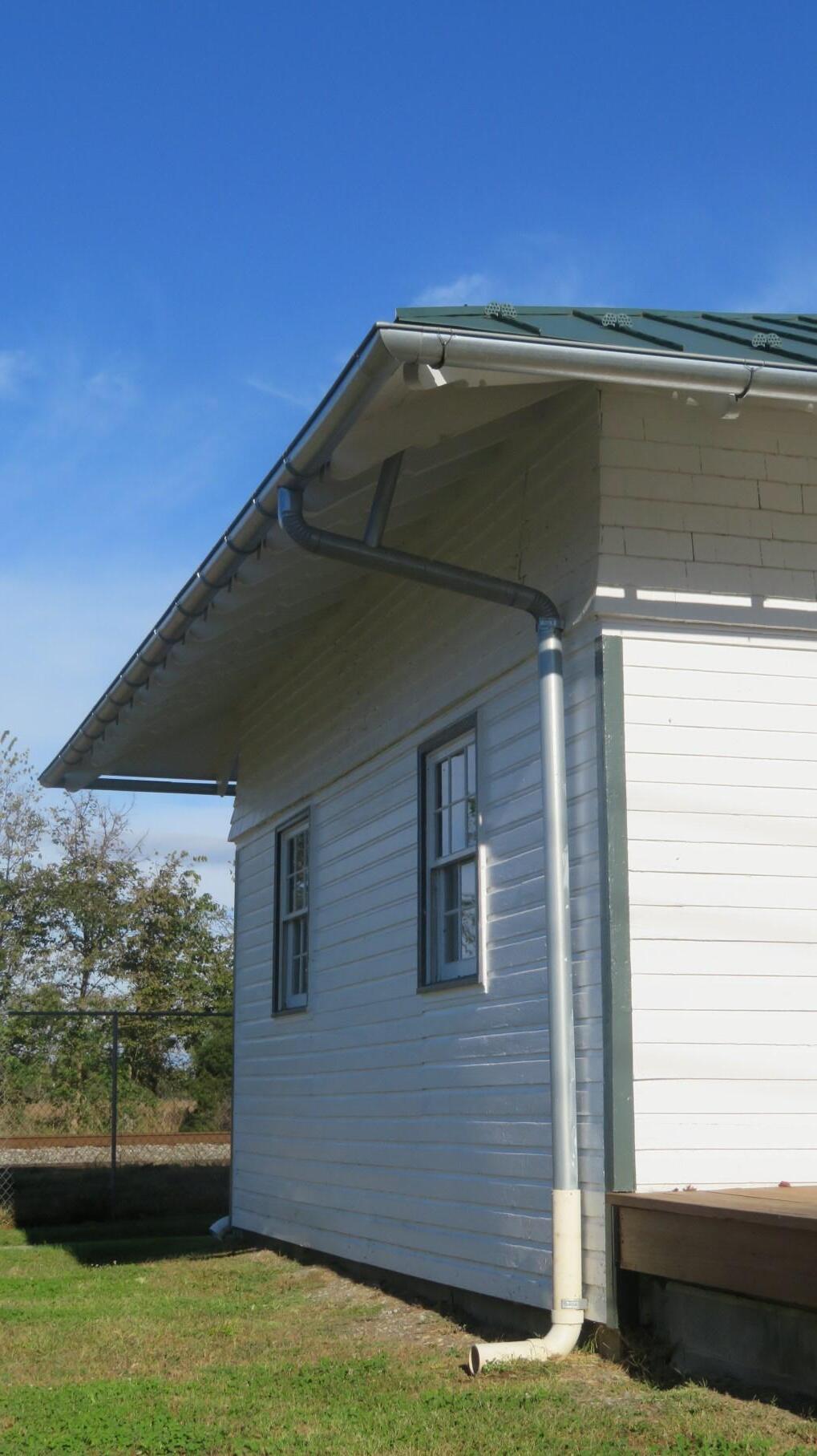
Antietam (Sharpsburg) Train Station, WA-II-378


Design Guidelines 67 Protect Maintain Repair Replace
K-style Gutter Profile Half
round Gutter Profile
-
Porches
Aside from their aesthetics across the many architectural styles, porches also offer several functional benefits to a historic structure and its occupants. Porches serve as extensions to living spaces, protect the entrance from weather, and shade the windows to allow cooling of the structure. The location of porches can be on any façade of the building and typically are covered with a roof. They may exist only in the area directly around the entrance or extend the entire length of a façade, at times wrapping around to secondary façades, depending on the architectural style of the home. Those along a primary façade may be more elaborate in their character-defining details. Two-story porches occur frequently along the secondary façades with a few examples along primary façades mainly in municipalities. Porches in the County are typically constructed of wood with structural systems of brick or stone. Porches can be original to the structure or can be additions later and still have equal importance to the character of the building. The design principles discussed earlier, such as scale, weigh heavily into the construction of the porch and its defining features. Aside from those elements, the other character-defining features of a porch can include, structural components of the deck and roof, roof railing, balustrade, entablature, decking, steps, and columns.
Porches should be regularly cleaned of debris, such as leaves, that can cause water to sit against the surface and cause decay. Also if the horizontal space of a porch is used for decorative displays or storage, it is important that the surface has airflow to avoid condensation or water sitting on the wood surfaces.
Guidelines For Porches
1. Porch support structures should be inspected regularly to ensure they are not sagging, crumbling or separating from the structure or the rest of the porch. If necessary, stabilization and repair should be undertaken to ensure that the rest of the structure remains intact.
2. Carpet can trap water on wood porches causing decay of painted surfaces or rot of wood, and carpet should not be installed
3. Avoid enclosing a porch. If the porch is not visible from a public right-of-way, it may be enclosed if the change does not significantly alter the original character of the porch.
4. See also Wood Exteriors (p.60) for more guidelines and the Key Themes (p.57)
Additional Resources
Preservation Brief #45 – Preserving Historic Wooden Porches
68 Historic Structures Themes: Identify Retain Preserve



Design Guidelines 69 Protect Maintain Repair Replace
Brick Farmstead, Yavener, WA-III-020
Photo Credit: Lloyd Yavener
Main St., Rohrersville, WA-III-143
Early 20th Century Farmhouse, WA-II-410
Additions to Historic Buildings
When a proposed new use of a historic building cannot be fully met by altering the existing interior space, an addition to a historic building may be required. Additions must carefully consider the previously discussed design principles of Massing, Scale, Proportion, and Rhythm involved with the existing historic building and/or its historic landscape. In regard to these principles, the addition’s impact on the historic building itself, the adjacent contributing properties or buildings, and, if applicable, the impact on the historic landscape will all be considerations during review.
Guidelines for Additions
1. Damage to the original structure and/or obstruction of its character-defining features by an addition should be minimized.
2. Additions should be designed in a way that new construction is differentiated from the existing historic building but should respect the design and character-defining features of the existing historic structure. Additions should also be sited to avoid demolition of contributing structures.
3. New additions should be located on a non-primary façade with minimal visibility from the public right-of-way and should be subordinate to the historic structure.
4. The roof shape of an addition should be compatible with that of the historic building to which it is attached.
5. Existing setbacks, landscaping, or site grading should be preserved when siting an addition if those characteristics contribute to the historic building or its landscape.
6. Rooftop additions should generally be avoided on buildings less than three stories and should be minimally visible from the streetscape by being setback from the primary elevation. Rooftop additions of more than one story should be avoided where feasible.
7. The addition of dormers to historic structures should occur only on secondary façades and not be visible from the public right-of-way when feasible. The dormer addition should be subordinate to the existing roof form.
8. See also Archaeological Resources Setting and Site (p.50) and Key Themes. (p.57)
Additional Resources
Section 5D.5 – Architectural Review – Washington County Zoning Ordinance
Preservation Brief #14 – New Exterior Additions to Historic Buildings: Preservation Concerns
70 Historic Structures Themes: Identify Retain Preserve
New Construction and Accessory Buildings
In some cases, it may be appropriate for new construction adjacent to an existing historic structure or within a historic landscape such as a Historic Rural Village. New construction must carefully consider the previously discussed design principles of Massing, Scale, Proportion and Rhythm involved between it and existing historic buildings or landscapes. In regard to these principles, the new construction’s impact on the adjacent contributing properties or buildings and the impact on the historic landscape will all be considerations during review. The new construction should enhance or aid in the protection, preservation and public/private utilization of the property. The Zoning Ordinance states “the Commission shall be lenient in its judgement of plans involving new construction, unless such plans would seriously impair the historic or architectural value of surrounding structures or the surrounding area. (Washington County, Maryland, 2021)” Maryland Inventory of Historic Properties documentation for properties and landscapes in review areas will be consulted to ensure new construction and accessory buildings are compatible.
Guidelines for New Construction and Accessory Buildings
1. New construction should be sited to avoid demolition of contributing structures.
2. The design of new construction or new accessory buildings should be compatible with the form, height, scale, proportions, materials and details of the adjacent contributing structures or landscapes.
3. Consideration of the ratio of built versus open space of the site or the adjacent landscape should be given.
4. Existing setbacks, landscaping or site grading of adjacent historic resources should be preserved when siting new construction if those characteristics contribute to the historic site or its landscape. This includes circulation routes, fences, walls, and yards, etc.
5. Locate new construction and new accessory buildings so that the existing significant visual and special characteristics of the property are maintained.
6. Locate new construction and new accessory buildings so that significant viewsheds are maintained or enhanced.
7. See also Key Themes. (p. 57)
Design Guidelines 71 Protect Maintain Repair Replace
Site and Building Lights
Found on both commercial and residential sites and buildings, historic exterior lighting fixtures can vary greatly in the County. Some fixtures can be found attached to the structure, whereas others may be freestanding poles or site lights. Although lighting is regulated in the County’ s Zoning Ordinance in Division X Section 22, this regulation should not be interpreted to mean fixtures contributing to the historic character of the building cannot be retained or repurposed. In cases where new lighting is proposed in areas of Commission review, the lighting regulations as well as the character of lighting in the site or historic landscape will be considered.
Guidelines for Site and Building Lights
1. Limit the level of illumination to be sufficient to perform the needed lighting task or to meet ordinance requirements.
2. If additional lighting is needed, supplemental lighting, rather than removal of the original fixture is recommended. That lighting should be subordinate to the historic lighting in placement, scale, design, and illumination.
3. Meeting glare and illumination requirements from the Zoning Ordinance should be attempted by adapting the historic lighting fixture while maintaining its original appearance where feasible.
4. Do not install site lighting, such as faux historic street lights, that conveys a false sense of history.
5. If new light fixtures are necessary, use a contemporary design or simplified historic lighting design that is compatible with placement, design, materials, and quality of lighting on adjacent historic buildings.
6. Scale new site-lighting fixtures to the building. These fixtures should be subordinate to adjacent historic structures.
7. Use low, shielded fixtures with down-lighting or light bollards within landscaping to illuminate pedestrian walkways if needed.
8. Do not provide greater illumination in parking areas than at building entrances or for pedestrian walkways.
72 Historic Structures Themes: Identify Retain Preserve
9. Do not use site lighting that is brighter than historic building lighting.
10.Locate and install light fixtures so they may be removed without significant damage to historic building fabric. For example, on masonry, attach to the fixture in masonry joints.
11.Do not install lighting conduits, junction boxes, and wires on primary building façades.
12.See also Key Themes. (p. 57)
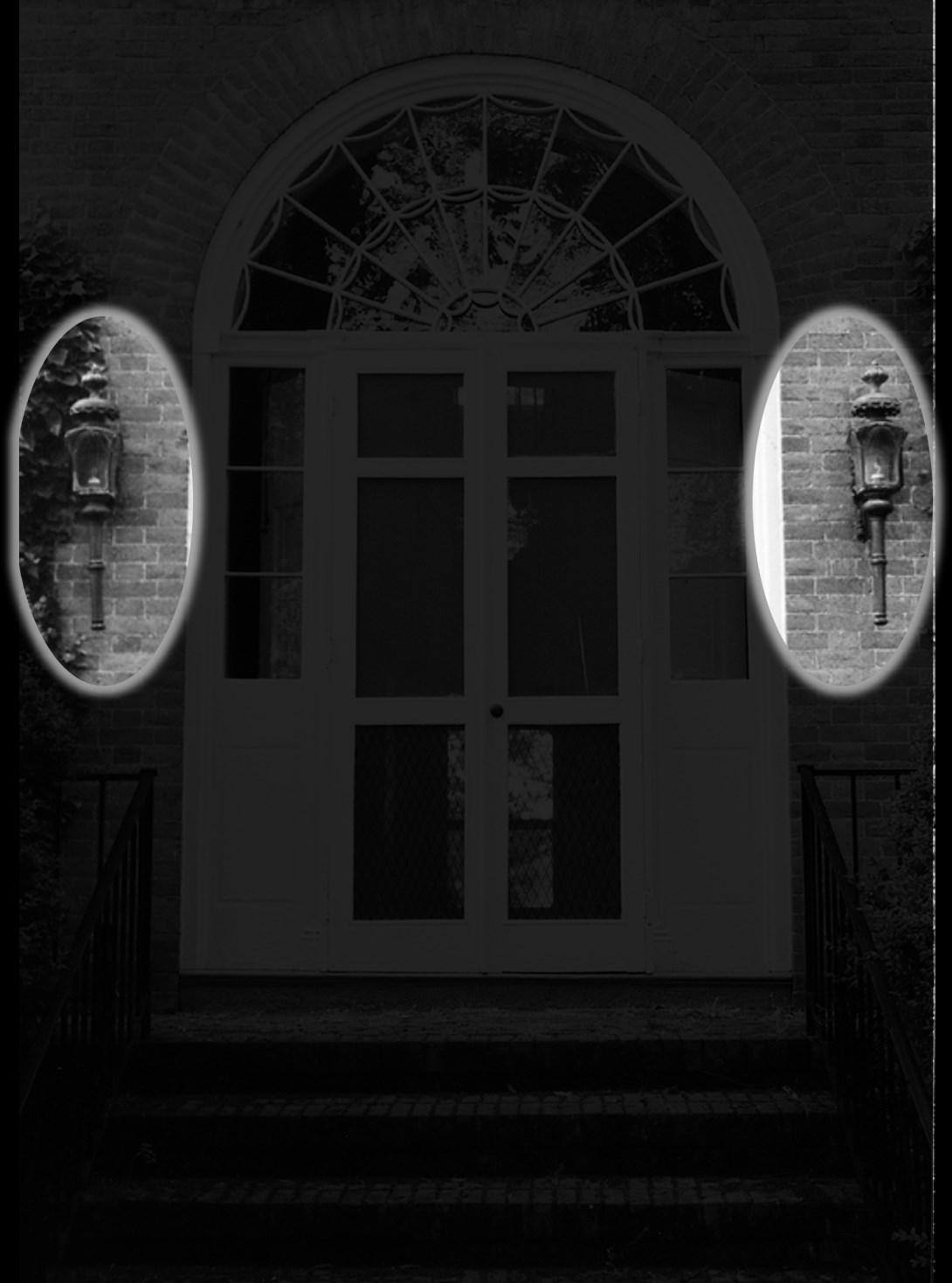



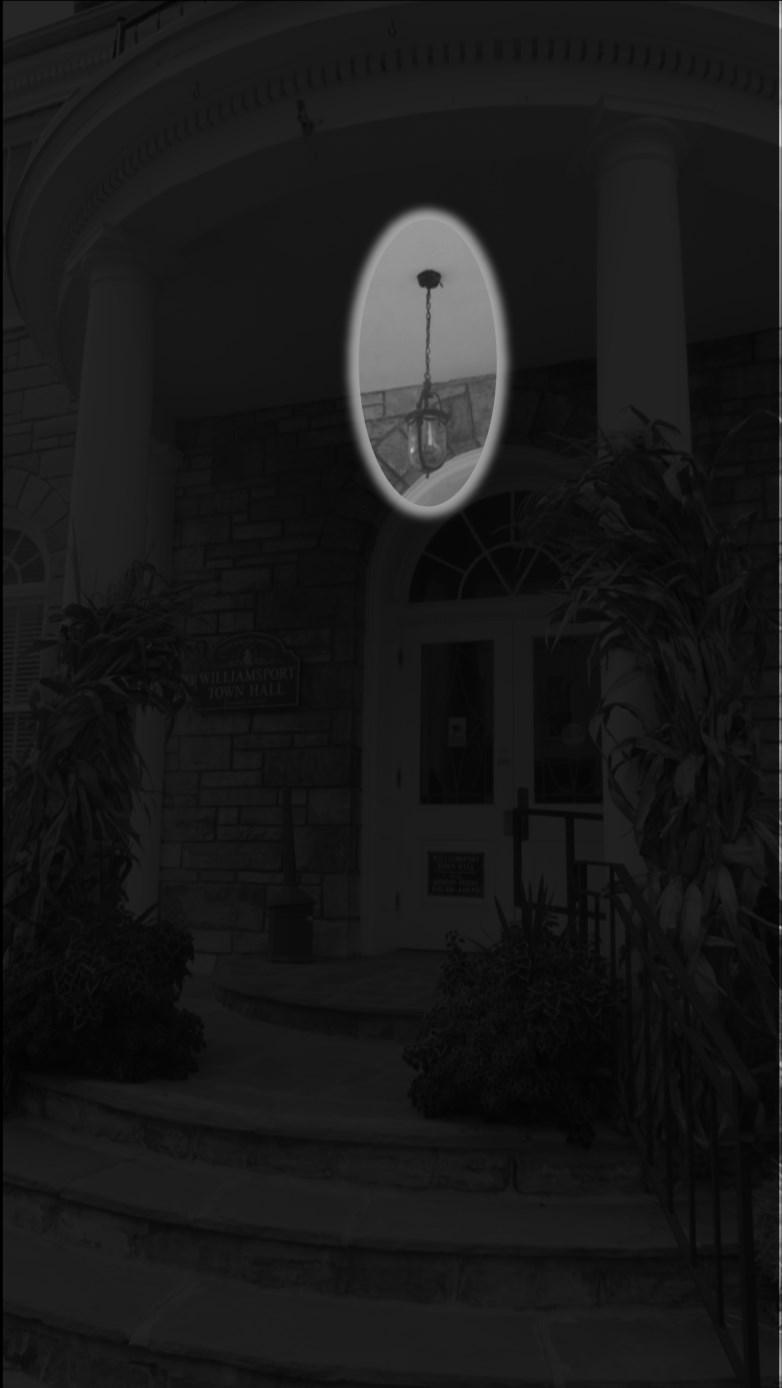
Design Guidelines 73 Protect Maintain Repair Replace
Rose Hill Entrance, WA-I-374
Beard’s Church, WA-I-056
Photo Credit: WCHT
Robert Claggett Farm, WA-III-036
Williamsport Town Hall, WA-WIL-018
Street Lighting in Williamsport, WA-WIL-025 & WA-WIL-026
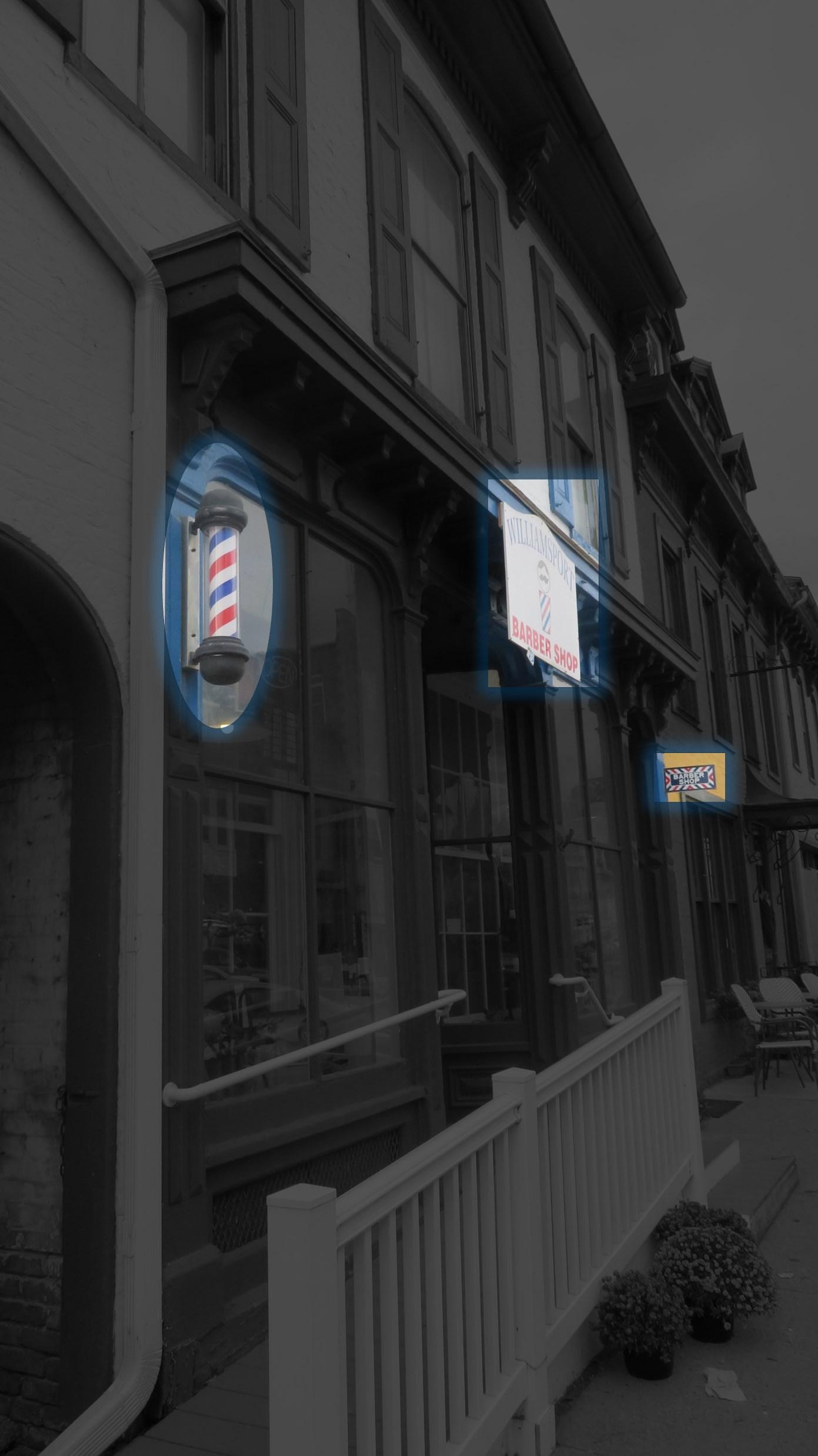
Signs
The HDC reviews prospective new signs that require a permit within the Antietam Overlay (AO1 or AO2) leading into and out of Sharpsburg. The setting and site of the Town of Sharpsburg as well as the adjacent Antietam National Battlefield are protected by this additional review of the signage. Once a sign permit is applied for, the Commission will consider the sign shape, size, positioning, colors, materials, size, illumination, and lettering following key concepts of the architectural review outlined in Section 5D.5 Architectural Review of the Zoning Ordinance. It is important to note that the review by the Commission is in addition to the requirements for signs under Division II – Signs and Division X – Lighting of the Zoning Ordinance. The guidelines for signs may also apply to properties that have the Historic Preservation Overlay or are within a Historic Rural Village. For all other properties that may be older than 50 years and contain or propose a sign, these guidelines can be a helpful resource.
“Signs are everywhere. And everywhere they play an important role in human activity.” (US National Park Service, 2021) In the County, signs serve many purposes, but the main purpose is to identify the historic site or the business within it. Other signs that can be historic or provide historic context in the County include billboards, murals, historical markers, waypoints, and barn advertisements. Signs may be attached to the buildings, painted directly onto the building, or be freestanding. All convey information about the current or past history and provide context to the site or district. In many cases, the placement or relationship of signs can contribute to the streetscape of a historic landscape. Signs can be both symbolic or object based in nature as well as text based historically. Many times commercial buildings include a hierarchy of signage rather than a singular sign. This hierarchy includes primary signage that is typically the main business name, secondary signage that may convey additional information about a business and is subordinate in size to the primary signage, and iconic signage that is subordinate to the primary signage, but creates visual interest at a pedestrian level. Iconic signage is often three dimensional and projecting. All levels of this hierarchy would be reviewed by the Commission.
Most commonly, signs were constructed of wood. Pre-nineteenth-century signs were commonly flat signs conveying information through symbols or lettering. If the signs were hanging or projecting, they were often attached to a wrought iron bracket. Signs could also be shaped in many ways including rectangular, plaques, shields, or ovals. The shape would be dependent on where and how the sign was attached. Other sign materials, including brass, tin, cast iron, steel and enamel, were available in the late nineteenth century. Awnings were also used for sign placement. In the twentieth century the prevalence of electricity heralded new innovations in the signage of properties. This additional power meant that lighting and even
74 Historic Structures Themes: Identify Retain Preserve
1. 2. 3. 1. Primary Signage 2. Secondary Signage 3. Iconic Signage Mediary Masonic Temple, Williamsport, WA-WIL-020
movement within the signs became more prevalent. Neon gas was also frequently used in the twentieth century allowing use of color, light, and shapes combined for signs.
Equally as important as the material of the sign is the lettering used. Lettering typically falls into three main categories: Serif, Non-Serif and Script. A serif in typography is a small line or stroke regularly attached to the end of larger stroke in a letter. Examples of typefaces that contain serifs are Times New Roman, Garamond, and Georgia. Non-serif or sans serif simply means the letters do not have that extra stroke. Examples of these typefaces are Arial, Calibri, or Helvetica. Script typefaces are extremely varied in their elaborateness; most closely resemble the fluidity of handwriting. Typically serif typefaces would be seen on signs until the late nineteenth century to early twentieth century. After that point, signs would more commonly have non-serif or mixed typefaces. After the 1920s, the use of solely non-serif typeface was most common. Although script lettering may, for some, convey a sense of history, it was rarely used in signage because it is difficult to read.
While the Commission does not review the exterior color or paint of historic buildings, the review of colors or paint does occur for signage. Modern choices for paint are extremely varied in both composition and color. Oil based paint types are the most common on historic structures and signs. In order to provide color, the paint pigments were often added to a white lead-base pigment. Exterior colors were not as varied until the late nineteenth century and post-Civil- War era when paint became more mass produced and readymade rather than mixed as needed onsite with pigments. It is important to understand the composition of an existing painted sign as it can contain many levels of paint over time. The main purpose of a sign, to convey information, means that colors would typically be contrasting. Dark bases of grays, blacks, and red oxide based browns would be common with contrasting white lettering. Signs would typically complement a building if attached but may not have matched exterior colors of the main building. Gold leaf used for lettering or accenting graphic objects was more common in the nineteenth century and again, contrasting with the background color.


For the vast majority of signs in the Commissions areas of review, externally illuminated signs are the most appropriate. Internally lit signs are not appropriate in the Antietam Overlay but may be appropriate elsewhere in the County based on the sign type and historic setting. Again, lighting and sign lighting are addressed in the Zoning Ordinance under Division X, which should be consulted prior to permit application.

Design Guidelines 75 Protect Maintain
Replace
Repair
Times New Roman
Calibri
Script MT Bold
Guidelines for Signs
1. Signs should be sited on or around a historic building so as not to obscure or damage architectural features or detract from the historic landscape.
2. Signage on or around a historic building should be subordinate to the building’ s architecture and not overpower the building.
3. Signs should coordinate in size, location, and placement within the building, with adjacent buildings or the surrounding historic landscape’s examples.
4. Historic buildings should limit primary and iconic signage to one per business where feasible with secondary signage used to convey additional information in order to minimize visual clutter.
5. Primary storefront signs should be mounted flush on the signboard where feasible and appropriate.
6. Projecting blade signs should be mounted perpendicular to the façade with ample clearance for pedestrians and should not be used in conjunction with iconic-shaped projecting signage.
7. Illumination of signs should be external. Internally lit signs are not appropriate for most historic areas under Commission review including the Antietam Overlay, Historic Preservation Overlay, and the Historic Rural Villages.
8. Secondary signage including window signs should be subordinate to primary signage and should take up 20 percent or less of each windows area.
9. Awning signage should have lettering limited to the awning face when feasible; that lettering should be incidental in appearance.
10.The colors used on a sign should be complementary to the building and historic landscape and appropriate to the historic context.
11.Limit the number of colors used for painting signage to the smallest number possible.
12.Lettering of signs should be appropriate to the size of the sign. The lettering style should attempt to be correct to the period of the building or the business type.
13.Signs should not appear out of scale with the building to which they are attached or are positioned near. They should not overpower adjacent structures or monopolize the streetscape.
76 Historic Structures Themes: Identify Retain Preserve
14.Primary signage should be shaped simply with rectangular signage being appropriate for most applications. Secondary and iconic signage may vary more in shape and composition.
15.Signs should be crafted using high-quality materials and finishes that complement the durable materials found on historic buildings.
16.Maintain existing historic signs where feasible or integrate them into the adaptive reuse design.
17.Preserve historic painted wall signs by leaving them exposed and unrestored unless severely deteriorated to avoid confusion over the age of the building or sign.
18.Use ground-mounted signs for rural businesses that fall within review areas. Signs should follow Site and Building Lighting guidelines as well as other listed Sign guidelines and should be scaled dependent to the structure size and adjacent historic landscape.
19.See also Key Themes. (p. 57)
Additional Resources
Preservation Brief #25 – The Preservation of Historic Signs
Division II – Signs – Zoning Ordinance
Division X – Lighting – Zoning Ordinance
See also Design Guidelines “Site and Building Lighting”



Design Guidelines 77 Protect
Maintain Repair Replace
Rufus Wilson Complex, WA-V-074
Cushwa Coal Building, Williamsport, WA-WIL-033
-II-542
Kretzer
’s Market/Nutter’s, WA
Solar and Other New Technologies for Environmental Sustainability
The Historic District Commission will review permits and site plans for the installation of solar on individual resources as well as the review of SEGS or solar energy generating systems that may affect the historic character of a resource or the historic landscape. Green roofs and wind turbines may also be applied for and require Commission review. The Commission encourages the protection of the historic landscape and structure while reducing the visual impacts of solar panels and other new technologies from public rights-of-way. Guiding the Commission in their review are the SOI Standards 2, 5, 8, 9, and 10 as listed earlier in this document.
Solar*
Different types of solar installations may be reviewed, including roof mounted or freestanding solar systems. The use of solar on sites in order of preferred placement (most to least preferred) is as follows:
1. Community Solar Arrays These are generally off-site arrays where energy is generated and the hardware is either leased or purchased by the customer in order to receive an energy credit.
2. Freestanding Solar Arrays – These are generally placed away from a historic building and are often pole mounted. They allow for minimal impact to the historic resource when sited appropriately. Archaeological investigations may be necessary depending on the history of the site.
3. Roof Mounted Solar Systems on Accessory Structures or non-contributing buildings – This method minimizes impact to the primary historic resource by locating solar away from the main resource.
4. Roof Mounted Solar Systems on Non-Historic Additions of the Main dwelling or building –In this instance, the systems should be located on secondary elevations to minimize visibility from the public right-of-way.
78 Historic Structures Themes: Identify Retain Preserve
5. Roof Mounted Solar Systems on Historic buildings – If all other options are not feasible the owner can consider this location. Primary elevations visible from the public right-of-way should still be avoided. Buildings that have character-defining roof shapes or materials are highly encouraged to explore the other preferrable locations to preserve the character of the structure.
Installation Guidance for Solar Freestanding Solar Systems should
1. Be screened from the public right-of-way to the greatest extent possible.
2. Have a suitable scale for the district and the setting.
Traditional Roof-Mounted Solar Panels should
1. Have a low-profile.
2. Be mounted less than or equal to six inches above the surface of the roof (to the face of the panel).
3. Be consistent with the existing slope of the supporting roof.
4. Set solar panels back from the edges and ridge of the roof.
5. Place any conduits for connections to electrical meters on the inside of the building or on a secondary elevation.
6. Locate conduits, inverters, storage units, or other hardware associated with the panels on the interior or on secondary elevations with limited visibility from the public rights-of-way.
7. Blend with the surrounding features of the historic resource with respect to color of the panel, support racks, and conduits.
8. Be arranged in an organized configuration and avoid disjointed and multi-roof solutions. This may require the relocation of modern vents, and, pipes.
Additional Resources (Citation)
*Montgomery County Historic Preservation Commission Policy Guidance #20-01: Solar Technology
Installing Solar Panels and Meeting the Secretary of the Interior’s Standards (National Park Service, Technical Preservation Services)
Section 4.25 and 4.26 Solar Energy Generating Systems Zoning Ordinance
Design Guidelines 79 Protect Maintain Repair Replace
Green Roofs
Green roofs are layers of vegetation planted over a waterproofing system that is installed on a flat or slightly sloped roof. Three main categories of green roofs are extensive, intensive, and semi-intensive. These have varying levels of plant and support materials involved and thus require different structural loads to function. Green roofs should not have visual, physical impacts on the building’s historic character. When proposed on existing historic structures, the Commission will review current guidance of the National Park Service.
Additional Resources
Green Roofs – (National Park Service, Technical Preservation Services)
Wind Turbines
Although wind mills may be found in the rural landscape of the County, more modern wind turbines are less prevalent. Current guidance from the SOI recommends planning for the introduction of small wind turbines to follow guidelines for new construction. If a more industrial scale project is proposed, the Commission will review its impacts on the site and cultural landscape as appropriate.
Additional Resources
National Park Service - Guidelines for the Treatment of Cultural Landscapes
Washington County Design Guidelines – New Construction and Accessory Buildings
Section 4.24 Small Wind Energy Systems Zoning Ordinance
80 Historic Structures Themes: Identify Retain Preserve
Hazard Mitigation—Flooding, Storms, or Fire
The Commission highly encourages property owners to take photographs of their structure to establish a baseline documentation, as well as to take pictures whenever major work is completed. This includes both interior and exterior photos of work to the structure. To mitigate risks of flooding and fire, the Commission also recommends regular building maintenance and ensuring adequate insurance on the structure and any work being completed.
The County has historic resources that may be affected by floodplain activity and storm events. The Commission encourages property owners who have questions regarding flooding or a property’s susceptibility to flooding to contact the County’s Floodplain Manager.
As long as a historic building maintains its continued designation as a historic structure, a historic structure located within a FEMA designated special flood hazard area is not subject to the strict adherence to the requirements of substantial damage/improvement floodplain regulations. Rather, the historic building should be made to be more resilient to flooding risk to the most extent practical and in a manner that will preserve its historic character. The County’s adopted building code may have additional or modified requirements and necessary determinations for historic structures in a floodplain.
Additional Resources
Washington County Historic Resources Map (Floodplain included)
Preservation Brief #35 – Understanding Old Buildings: The Process of Architectural Investigation
Preservation Brief #43: The Preparation and Use of Historic Structure Reports
Preservation Brief #50: Lightning Protection for Historic Structures
SOI Guidelines on Flood Adaptation for Rehabilitating Historic Buildings - 2021
National Park Service SOI - Guidelines on Flood Adaptation for Rehabilitating Historic Buildings Video
Maryland Historic Trust – Flood Mitigation Guide (June 2018)
FEMA 386-6 - Integrating Historic Property and Cultural Resource Considerations Into Hazard Mitigation Planning State and Local Mitigation Planning How-To Guide (May 2005)
Design Guidelines 81 Protect Maintain Repair Replace
This page is intentionally left blank
82 Historic Structures
Rural Villages Inventory
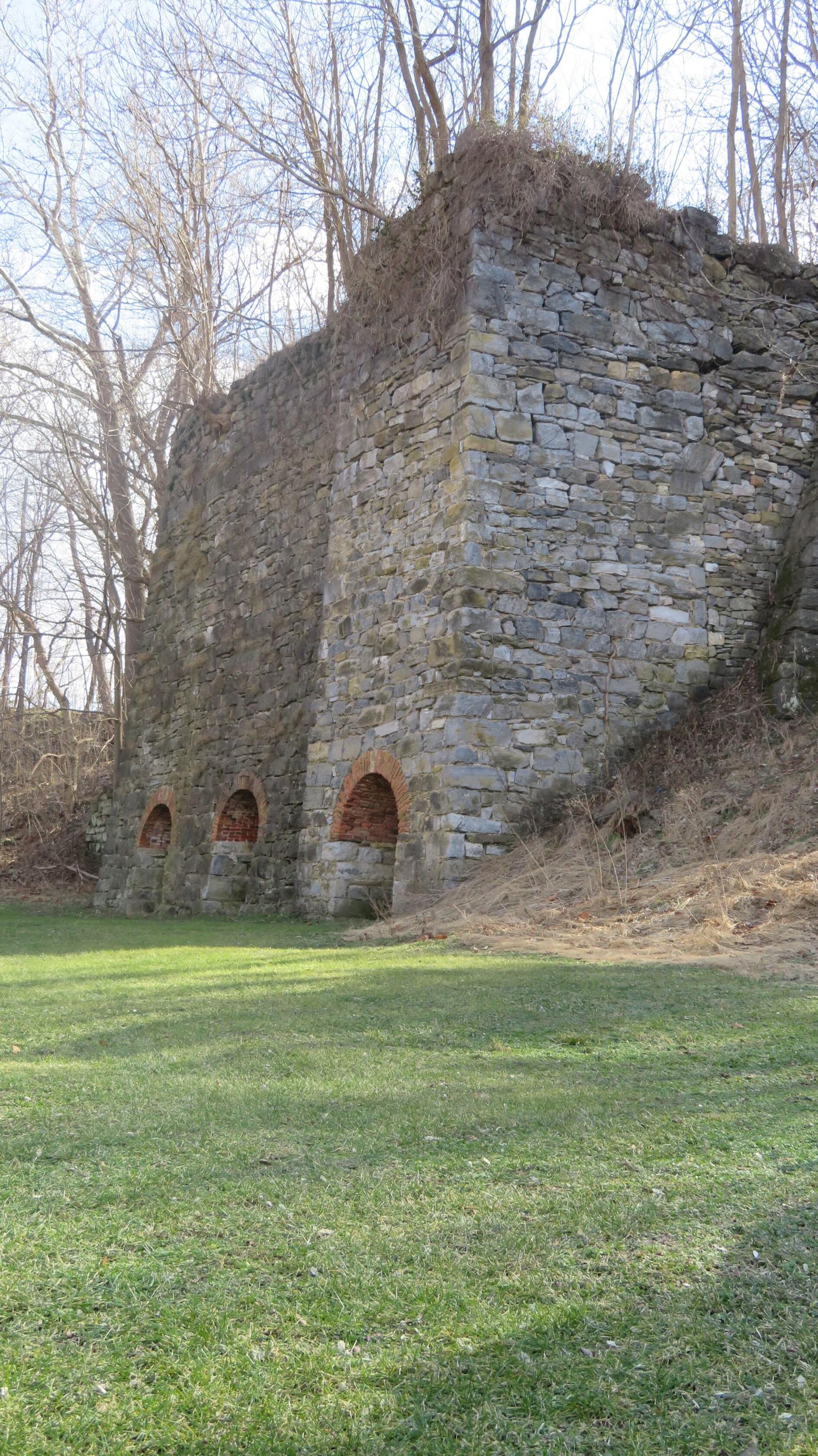
Antietam Bakersville Brownsville Cavetown Downsville Fairplay Gapland Highfield Leitersburg
Mount Lena Pen Mar Ringgold Rohrersville Sandy Hook Tilghmanton
83
Furnace, Antietam Ironworks, WA-II-031
Antietam Historic Rural Village
The Antietam Village Historic District is significant as the site of substantial iron-working enterprise that spanned the period from the colonial years through much of the nineteenth century. Although company records from the various Antietam Corporations have never been found, numerous references to the Antietam works exist in general local and regional history books, in histories of iron in the colonies, and in some primary documents from the Revolutionary period. With reference to the Revolutionary War era, the district was home to one of the operations conducted by the Hughes Brothers, who were major suppliers of weaponry to the Continental forces. In addition to the significance of the district for its industrial associations, the Antietam Village Historic District is also significant as a rural western Maryland village containing vernacular architecture dating from the late eighteenth century into the early years of the twentieth century.
- Description excerpted from Maryland Inventory of Historic Properties’ File
HDC ACTIONS IN THIS RURAL VILLAGE
CONTRIBUTING STRUCTURES
Approval/Denial
NEW CONSTRUCTION Recommendations
INDIVIDUAL LISTINGS Recommendations
DEMOLITION Recommendations
84 Historic Structures


Inventory Number
II-031, II-032, II-033
National Register
Yes
Contributing Structures
27/30
Survey Status
Adopted 2005
Period of Significance
1763-1930
Significance
Architecture and Industry
Maryland Historical Trust Antietam File
Design Guidelines 85
Bakersville Historic Rural Village
Bakersville represents the type of a small crossroads, rural postal village that developed in Washington County in the second quarter of the nineteenth century, to meet the needs of area farm families. It is named for Elias Baker, Sr. (1785-1863), who was Bakersville's first postmaster and the owner of the store around which the tiny hamlet developed. Its small collection of buildings include two interesting antebellum vernacular buildings, as well as a church and three postbellum houses whose designs were inspired by nationally popular building styles.
- Description excerpted from Maryland Inventory of Historic Properties’ File
HDC ACTIONS IN THIS RURAL VILLAGE
CONTRIBUTING STRUCTURES Recommendations
NEW CONSTRUCTION No Actions
INDIVIDUAL LISTINGS Recommendations
DEMOLITION Recommendations
86 Historic Structures


Inventory Number
II-276
National Register No
Contributing Structures
6/8
Survey Status
Completed 2010
Period of Significance
1823-1900
Significance
Architecture, Commerce, and Exploration/ Settlement Maryland Historical Trust Bakersville File
Design Guidelines 87
Brownsville Historic Rural Village
The Brownsville Historic District is historically significant for its association with early settlement and community development in Washington County. First settled in the late eighteenthcentury and established as a postal village in 1833, the community grew up around the tannery established by John Brown (1792-1888) in the 1830s. By the second half of the nineteenth century Brownsville had developed into a small but locally important market and manufacturing center. The community is typical of the myriad of towns and villages that emerged in Washington County and elsewhere in response to improved transportation networks. Brownsville's initial development coincides with the opening of the nearby Chesapeake & Ohio Canal in the 1830s. Its later expansion followed the extension of the Baltimore & Ohio Railroad to Brownsville in 1867. The Brownsville Historic District also achieves significance for its architecture. The town's collection of nineteenth and early twentieth century architectural resources nicely illustrates the transition away from regional vernacular building traditions at the turn of the twentieth century in favor of nationally popular building.
- Description excerpted from Maryland Inventory of Historic Properties’ File
HDC ACTIONS IN THIS RURAL VILLAGE
CONTRIBUTING STRUCTURES Recommendations
NEW CONSTRUCTION No Actions
INDIVIDUAL LISTINGS Recommendations
DEMOLITION Recommendations
88 Historic Structures
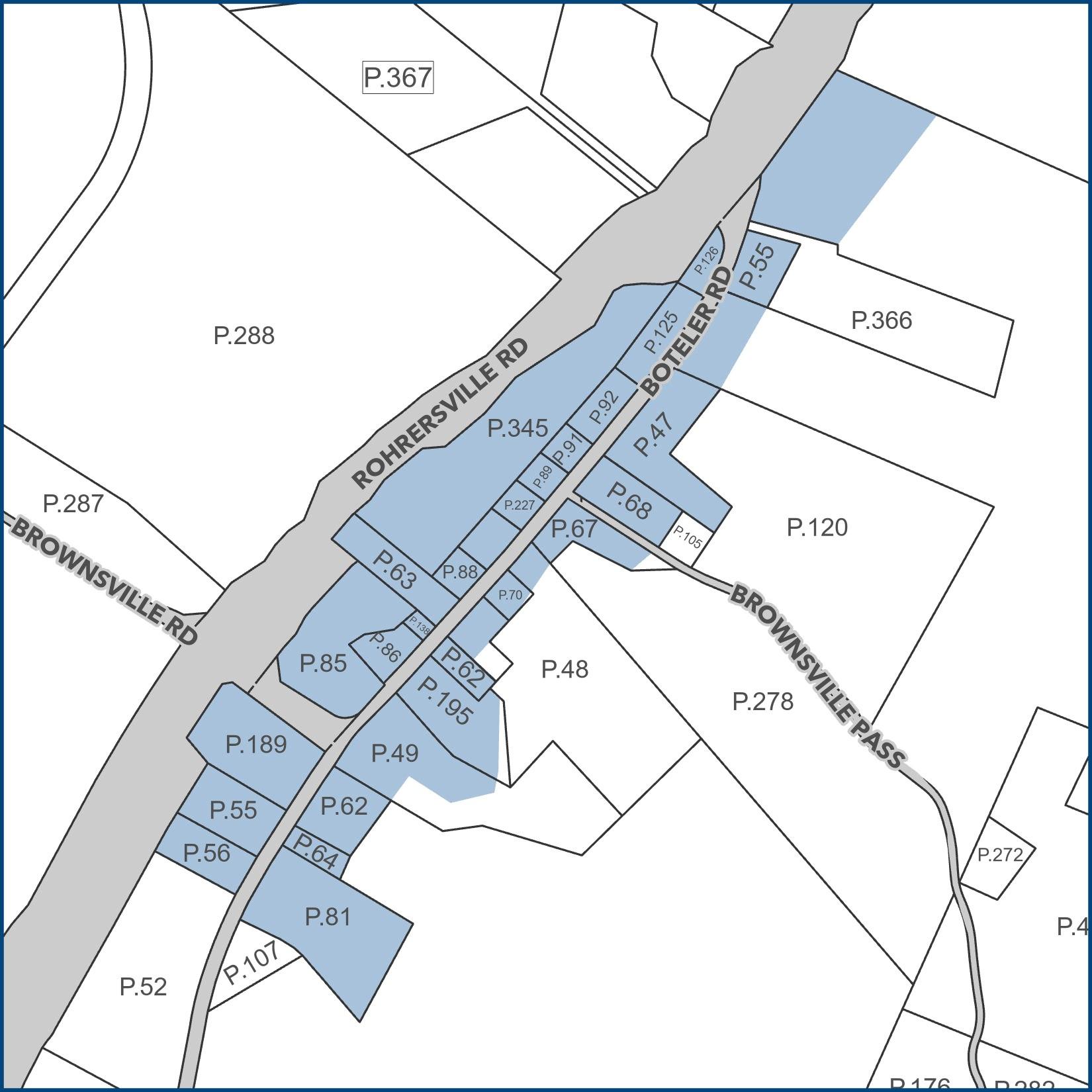
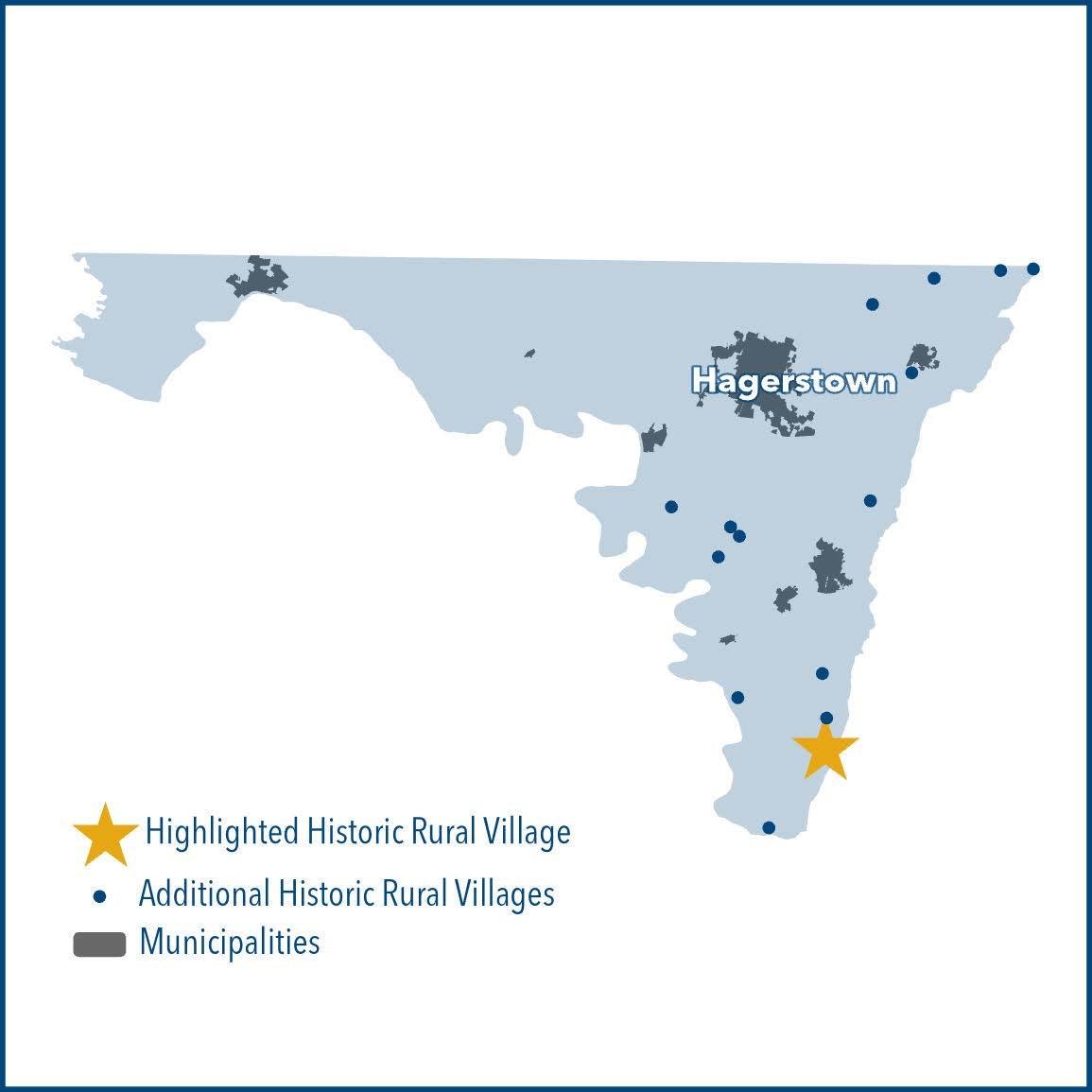
Inventory Number III-009
National Register No
Contributing Structures
24/28
Survey Status
Completed 2010
Period of Significance
1824-1925
Significance
Architecture, Commerce, Settlement, Military and Transportation
Maryland Historical Trust Brownsville File
Design Guidelines 89
Cavetown Historic Rural Village
The Cavetown Historic District is significant under National Register Criterion C for architecture, containing a contiguous collection of locally-significant properties whose designs reflect many of the popular modes prevalent in western Maryland from the 1820s through the 1930s. The Cavetown Historic District's properties reflect primarily vernacular design in the rural reaches of western Maryland throughout the Period of Significance, which begins c. 1820, spans the dates of construction of the district's earliest extant buildings, and ends c. 1950, the approximate date of construction of the latest of the district's historic resources. With respect to Criterion C, the district contains locally-distinctive examples of vernacular architecture that, although executed without reference to formal design tenets, represent the manifestation of local building traditions in this section of Washington County. The district also contains a limited number of examples of formal styles including the Federal and Gothic Revival. The Cavetown Historic District clearly retains its historic rural character along with the physical integrity necessary to reflect its appearance during its Period of Significance.
- Description excerpted from Maryland Inventory of Historic Properties’ File
HDC ACTIONS IN THIS RURAL VILLAGE
CONTRIBUTING STRUCTURES
Approval/Denial
NEW CONSTRUCTION Recommendations
INDIVIDUAL LISTINGS Recommendations
DEMOLITION Recommendations
90 Historic Structures

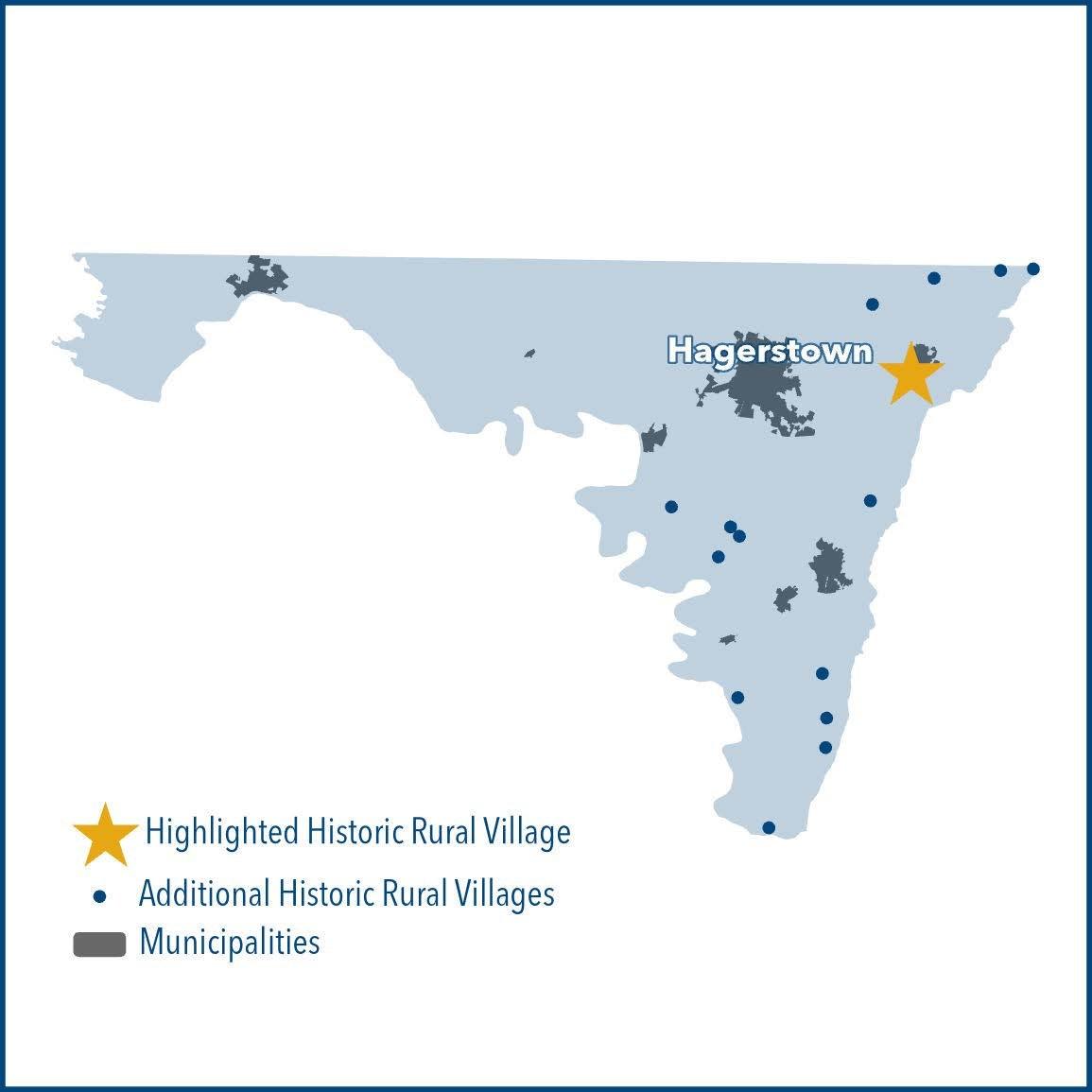
Inventory Number IV-014
National Register No
Contributing Structures
59/69
Survey Status
Adopted 2005
Period of Significance
1820-1950
Significance
Architecture
Maryland Historical Trust Cavetown File
Design Guidelines 91
Downsville Historic Rural Village
The village of Downsville is significant locally and potentially eligible under National Register Criterion A as an example of nineteenth century rural community development in Washington County, Maryland. Downsville began developing in the mid nineteenth century at a crossing of two old roads. Both roads led to important towns in Washington County, one to the county seat of Hagerstown and the other to Williamsport on the Potomac River. After 1835, Williamsport became a major C&O Canal depot, and the south end of the old road to Hagerstown terminated at the C&O Canal Dam #4. As traffic along the roads increased, the small village developed around the Charles Downs' store and, eventually included two churches, a school, and a growing number of shops and residences. The village remained relatively unchanged into the middle of the twentieth century, with the exception of the addition of automobile-related commercial buildings and some modem domestic infill.
- Description excerpted from Maryland Inventory of Historic Properties’ File
HDC ACTIONS IN THIS RURAL VILLAGE
CONTRIBUTING STRUCTURES Recommendations
NEW CONSTRUCTION No Actions
INDIVIDUAL LISTINGS Recommendations
DEMOLITION Recommendations
92 Historic Structures

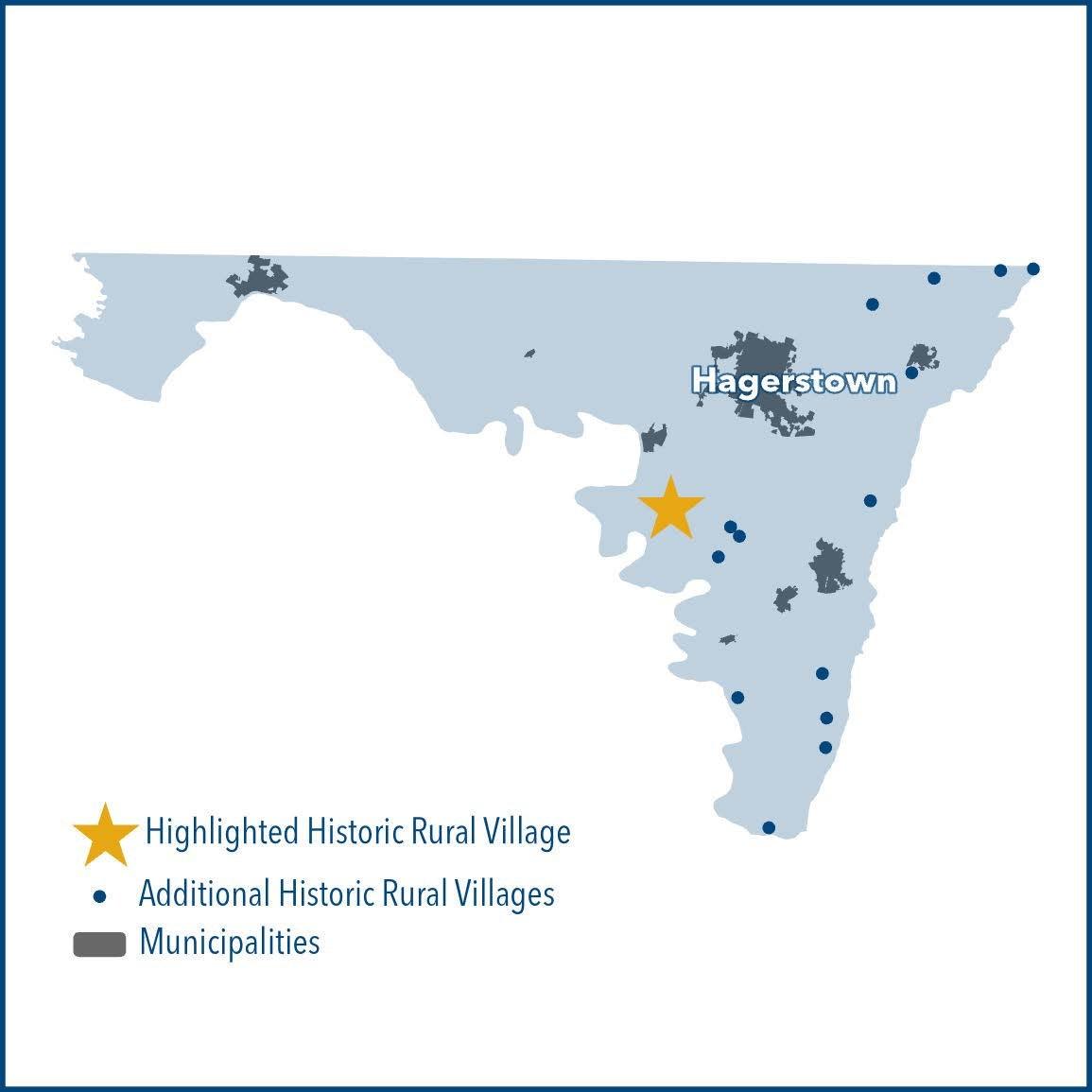
Inventory Number
II-273
National Register
No
Contributing Structures
36/42
Survey Status
Completed 2008
Period of Significance
1852-1958
Significance
Community Planning and Development, Transportation and Military
Maryland Historical Trust Downsville File
Design Guidelines 93
Fairplay Historic Rural Village
The Fairplay Historic District is significant under National Register Criterion C, for architecture, as a small, rural, western Maryland hamlet containing a locally-significant collection of generally residential architecture built between c. 1830 and 1900. The buildings within the district represent a variety of traditional and formal design styles. Some are of log construction, which is itself a significant design characteristic, while others represent mid to late nineteenth century vernacular residential design; a small number of buildings in the district reflect formal architectural antecedents. The settlement of Fairplay is located within Washington County Election District 12, at the junction of three rural roadways, and it developed due to its location at this intersection. Spielman Road enters the district from the west and leads eastward out of the district to intersect with the Sharpsburg Pike at the Tilghmanton settlement, about two miles distant.
- Description excerpted from Maryland Inventory of Historic Properties’ File
HDC ACTIONS IN THIS RURAL VILLAGE
CONTRIBUTING STRUCTURES
Approval/Denial
NEW CONSTRUCTION Recommendations
INDIVIDUAL LISTINGS Recommendations
DEMOLITION Recommendations
94 Historic Structures
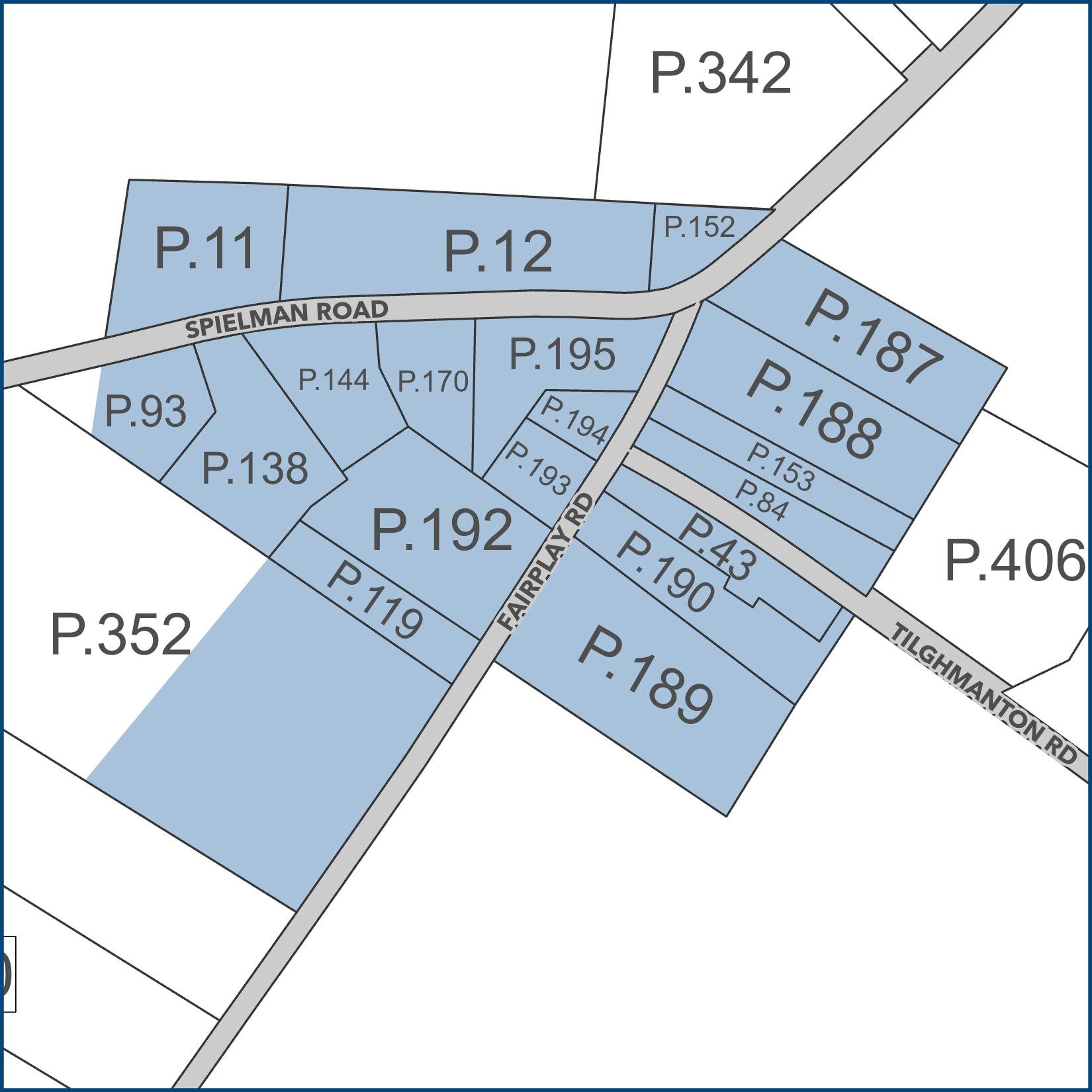

Inventory Number
II-277
National Register No
Contributing Structures
22/26
Survey Status
Adopted 2005
Period of Significance
1830-1900
Significance
Architecture
Maryland Historical Trust Fairplay File
Design Guidelines 95
Gapland Historic Rural Village
Gapland is an important example of a turn-of-the century railroad town in the Pleasant Valley region of Washington County, Maryland. When the Washington County Railroad was at its peak, the town also experienced growth and economic stability. The Baltimore & Ohio Railroad brought people, jobs, and material goods to Gapland and allowed the rural farming community to develop an identity as a town. Gapland's growth in the early twentieth century is reflected in the concentration of popular turn-of-the century architectural forms expressed in the houses along Gapland Road. Although Gapland Station (a.k.a. Clagett's Station) building is no longer standing, evidence of the rail line and its impact on the town remain. As the popularity of rail travel declined, so too did the town of Gapland. Even with the growth of automobile transit, Gapland has remained a small, but important rural village.
- Description excerpted from Maryland Inventory of Historic Properties’ File
HDC ACTIONS IN THIS RURAL VILLAGE
CONTRIBUTING STRUCTURES Recommendations
NEW CONSTRUCTION No Actions
INDIVIDUAL LISTINGS Recommendations
DEMOLITION Recommendations
96 Historic Structures


Inventory Number
III-039
National Register No
Contributing Structures
33/60
Survey Status
Completed 2010
Period of Significance
1800-1940
Significance
Architecture, Exploration/Settlement, Social History and Transportation
Maryland Historical Trust Gapland File
Design Guidelines 97
Highfield Historic Rural Village
The Highfield/Cascade Historic District is of particular significance to Washington County and to western Maryland as the tangible reflection of technological advance (namely, the development of the railroad) upon the growth of recreational and leisure activities, evidenced in the predominating character of the documented area as a resort community. The Period of Significance for the district begins c. 1890 and ends c. 1940, dates that span the approximate dates of construction of the area's historic resources and encompass the formative years of popularity of the area as a summer resort. The district consists of small and medium-scale domestic architecture executed in several of the architectural styles popular during the Period of Significance, including Queen Anne, Colonial Revival, Dutch Colonial Revival, and Bungalow.
- Description excerpted from Maryland Inventory of Historic Properties’ File
HDC ACTIONS IN THIS RURAL VILLAGE
CONTRIBUTING STRUCTURES
Approval/Denial
NEW CONSTRUCTION Recommendations
INDIVIDUAL LISTINGS Recommendations
DEMOLITION Recommendations
98 Historic Structures

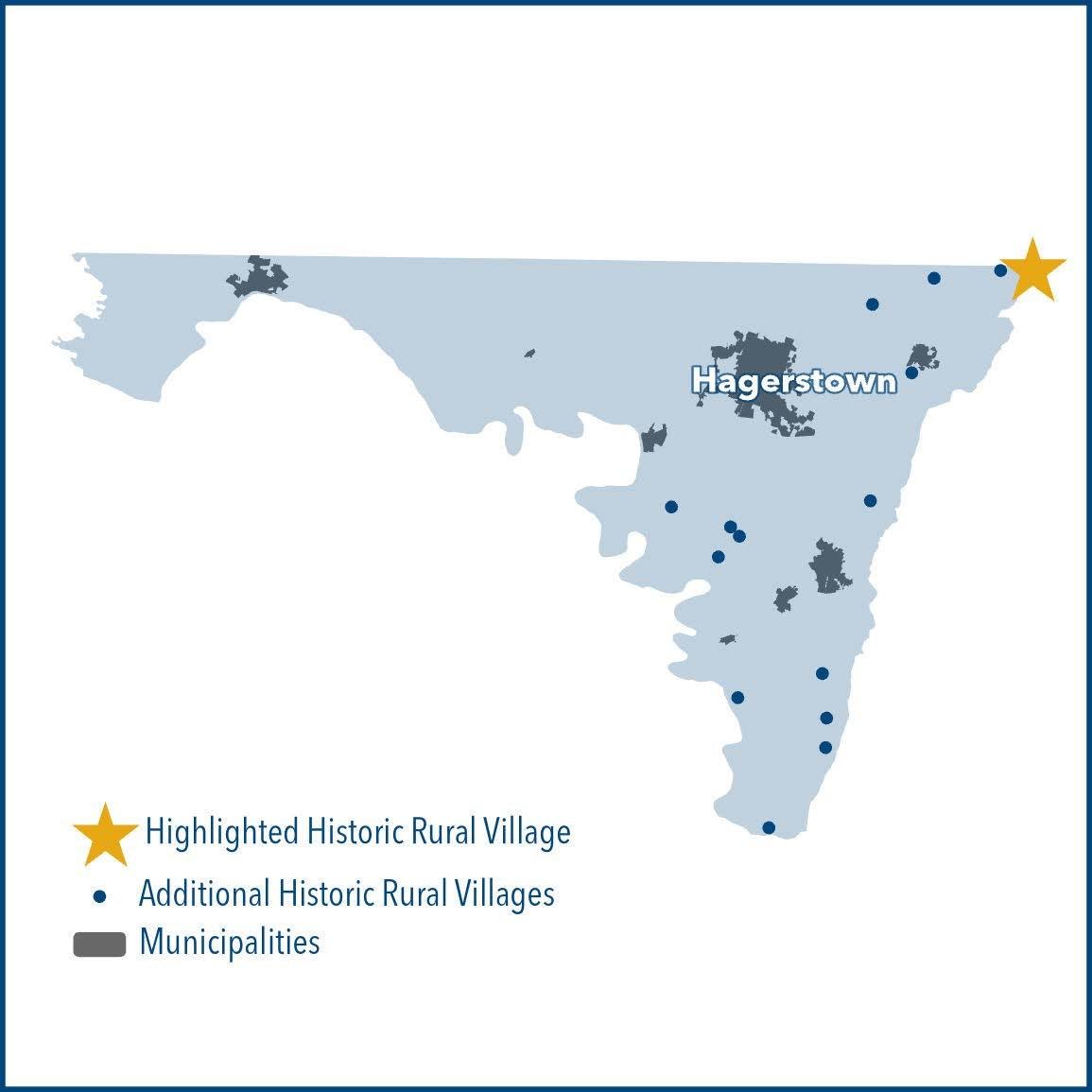
Inventory Number IV-057
National Register No
Contributing Structures
60/60
Survey Status
Adopted 2005
Period of Significance
1890-1940
Significance
Architecture
Maryland Historical Trust Highfield File
Design Guidelines 99
Leitersburg Historic Rural Village
The Leitersburg Historic District is significant under National Register Criterion A for its association with the development of commerce and transportation in Washington County and the surrounding region in the nineteenth and early twentieth centuries. Leitersburg was founded in 1815 by Andrew Leiter after the 1807 Greencastle-Baltimore Road was constructed to intersect the Nicholson's Gap Road on his property. The town developed with many hotels and commercial establishments to serve travelers on the two roads. The town also served as an exchange point between the many mills and distilleries located on the nearby Antietam Creek. The village continued to prosper when nine miles of the Nicholson's Gap Road was rebuilt as the Leitersburg Turnpike in 1847.
The Leitersburg Historic District derives additional significance under National Register Criterion C as a well-preserved example of a type of crossroads community, which characterized the region in the nineteenth century, and for its variety of historic architecture. Leitersburg's town plan, comprising a public square at the intersection of two major thoroughfares, typified communities in southern Pennsylvania and adjacent Maryland during the period. The village comprises a cohesive collection of architectural resources reflecting a wide variety of vernacular types and popular expressions dating from the early nineteenth century through the early twentieth century. The majority of early buildings were of log construction.
- Description excerpted from Maryland Inventory of Historic Properties’ File
HDC ACTIONS IN THIS RURAL VILLAGE
CONTRIBUTING STRUCTURES
INDIVIDUAL LISTINGS Recommendations
DEMOLITION Recommendations
100 Historic Structures
Approval/Denial NEW CONSTRUCTION Recommendations
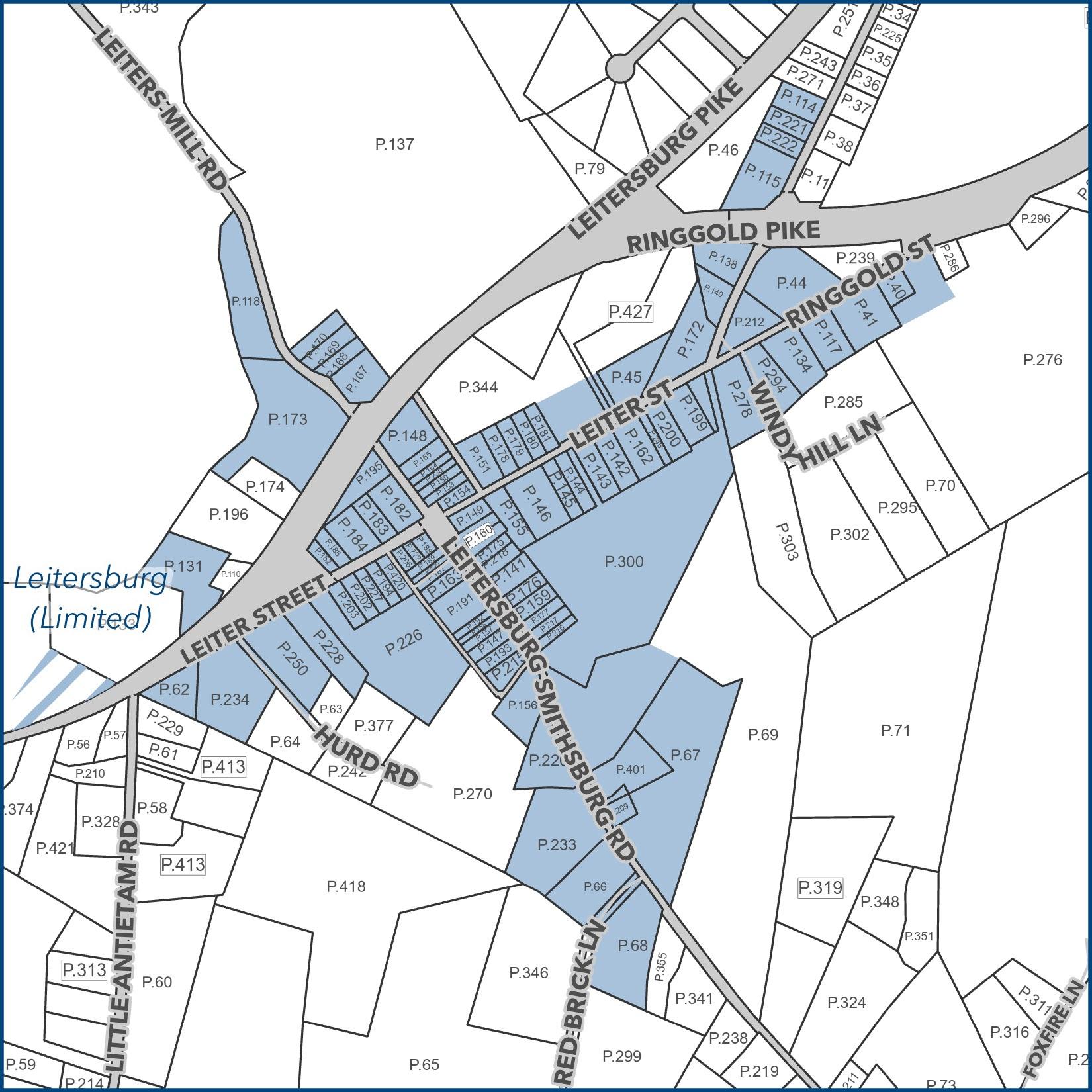

Inventory Number
I-146
National Register Yes
Contributing Structures
155/227
Survey Status
Adopted 2005
Period of Significance
1815-1926
Significance
Community Planning & Development, Architecture, Commerce, and Transportation
Maryland Historical Trust Leitersburg File
Design Guidelines 101
Mount Lena Historic Rural Village
Mt. Lena likely had its beginning in the late-eighteenth-century when Orr's Tavern was located on the road at the base of South Mountain. Much of the land on which the village developed was owned by the Hughes brothers, who operated the nearby Mt. Aetna Iron Furnace, requiring large amounts of timber land for charcoal. Mt. Lena was a village of laborers, probably beginning with the furnace and charcoal burners, as well as working at nearby mills and farms. In the 1880s the road became the Beaver Creek and South Mountain Turnpike, and in 1904, Mt. Lena was made a station stop along the Hagerstown & Myersville Railway, part of an extended line from Frederick to Hagerstown. U.S. Route 40, started in 1936, put an end to the railway by 1938, but was not finished over South Mountain until after WWII, about 1946. With U.S. Route 40, Mt. Lena became a bypassed roadside village, and its growth all but ended. By 1946, the route over South Mountain through Orr's Gap, along which Mt. Lena developed and was eventually bypassed, had seen at least four incarnations as road, turnpike, highway, and electric railway.
- Description excerpted from Maryland Inventory of Historic Properties’ File
HDC ACTIONS IN THIS RURAL VILLAGE
CONTRIBUTING STRUCTURES Recommendations
NEW CONSTRUCTION No Actions
INDIVIDUAL LISTINGS Recommendations
DEMOLITION Recommendations
102 Historic Structures


Inventory Number
II-166
National Register
No
Contributing Structures
42/78
Survey Status
Completed 2008
Period of Significance
1790-1946
Significance
Community Planning and Development and Transportation
Maryland Historical Trust Mount Lena File
Design Guidelines 103
Pen Mar Historic Rural Village
The Pen Mar Historic District has been documented with reference to National Register Criteria A and C. With reference to Criterion A, the area is significant under entertainment/ recreation, as a distinctive western Maryland Blue Ridge Mountain summer resort community dating from the last quarter of the nineteenth century. The district is particularly significant to the history of Washington County and western Maryland, because its existence reflects the influence of technological advances upon leisure life throughout the Period of Significance. Under Criterion C, with respect to architecture, the district derives its significance from its position as a locally-distinctive collection of summer homes and cottages built between the late nineteenth century and the first third of the twentieth century, generally vernacular in character, with only a scattering of residences executed in any formal design. The Period of Significance begins in 1877 when the Western Maryland Railroad began the construction of the recreational facilities at Pen Mar Park, which is no longer extant and was located across Pen Mar Road northwest of the district. The Period of Significance ends in 1943 when the railroad dismantled the remnants of their park and the community settled into its present purely residential character.
- Description excerpted from Maryland Inventory of Historic Properties’ File
HDC ACTIONS IN THIS RURAL VILLAGE
CONTRIBUTING STRUCTURES
Approval/Denial
NEW CONSTRUCTION Recommendations
INDIVIDUAL LISTINGS Recommendations
DEMOLITION Recommendations
104 Historic Structures

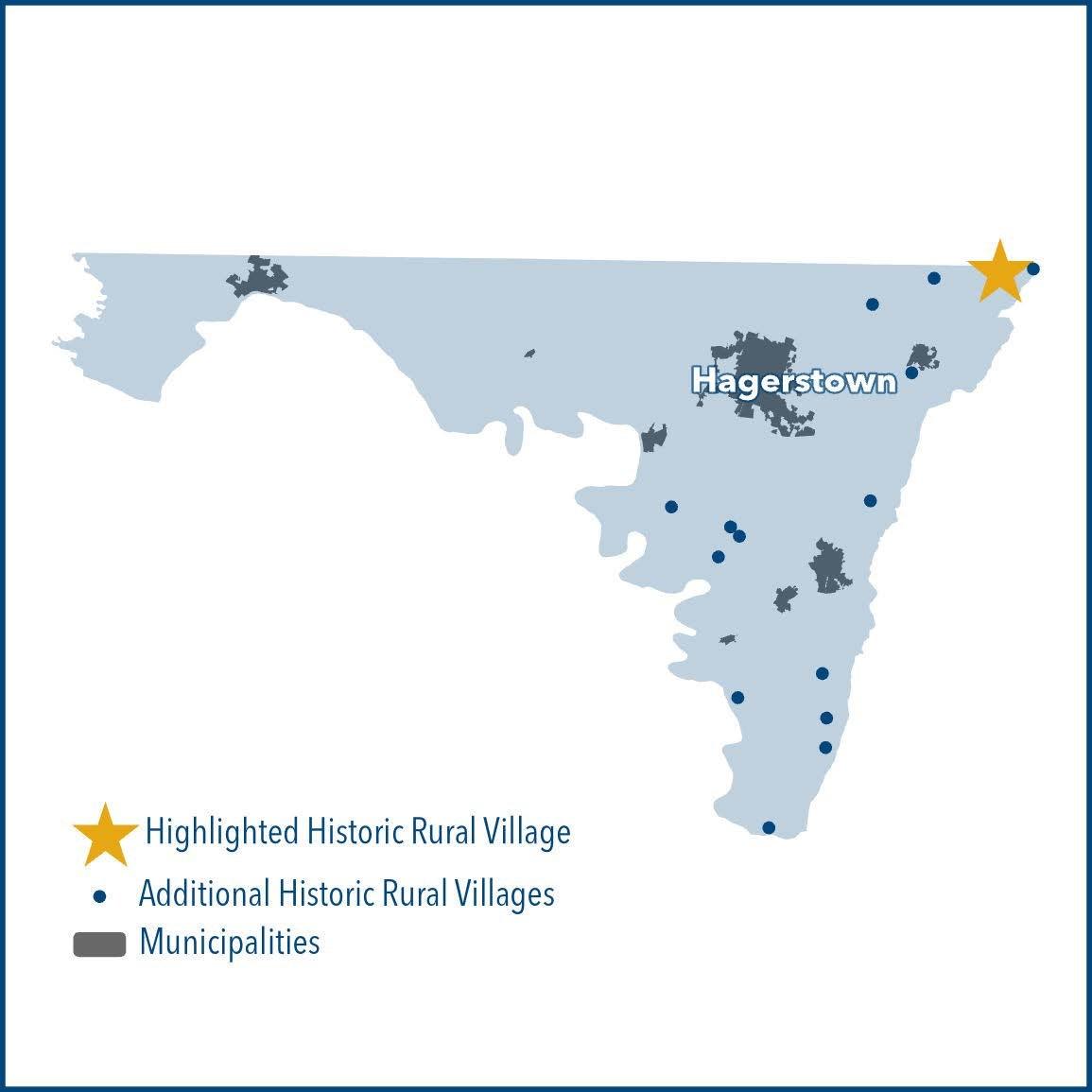
Inventory Number IV-019
National Register No
Contributing Structures
53/66
Survey Status
Adopted 2005
Period of Significance
1878-1943
Significance
Architecture and Entertainment/Recreation
Maryland Historical Trust Pen Mar File
Design Guidelines 105
Ringgold Historic Rural Village
The Ringgold Historic District is significant under National Register Criterion C for Architecture, containing a contiguous collection of locally-significant properties that reflect both popular styles of design prevalent in western Maryland from the 1820s through the 1920s and vernacular architecture representative of local building traditions in the area. The majority of properties in the Ringgold Historic District reflect primarily vernacular design in the rural reaches of western Maryland throughout the Period of Significance, which begins in 1825 when pioneer settler John Creager erected a log house in the area (not extant), spans the dates of construction of the district's earliest extant buildings, and ends c. 1920, the approximate date of construction of the latest of the district's historic resources. The district contains locally-distinctive examples of vernacular architecture that, although executed without reference to formal design tenets, represent the manifestation of local building traditions in this section of Washington County . The district contains only limited examples of formal styles including the Federal, Gothic Revival, Italianate, Bungalow, Colonial Revival, and American Foursquare.
- Description excerpted from Maryland Inventory of Historic Properties’ File
HDC ACTIONS IN THIS RURAL VILLAGE
CONTRIBUTING STRUCTURES
NEW CONSTRUCTION
Approval/Denial
Recommendations
INDIVIDUAL LISTINGS Recommendations
DEMOLITION Recommendations
106 Historic Structures
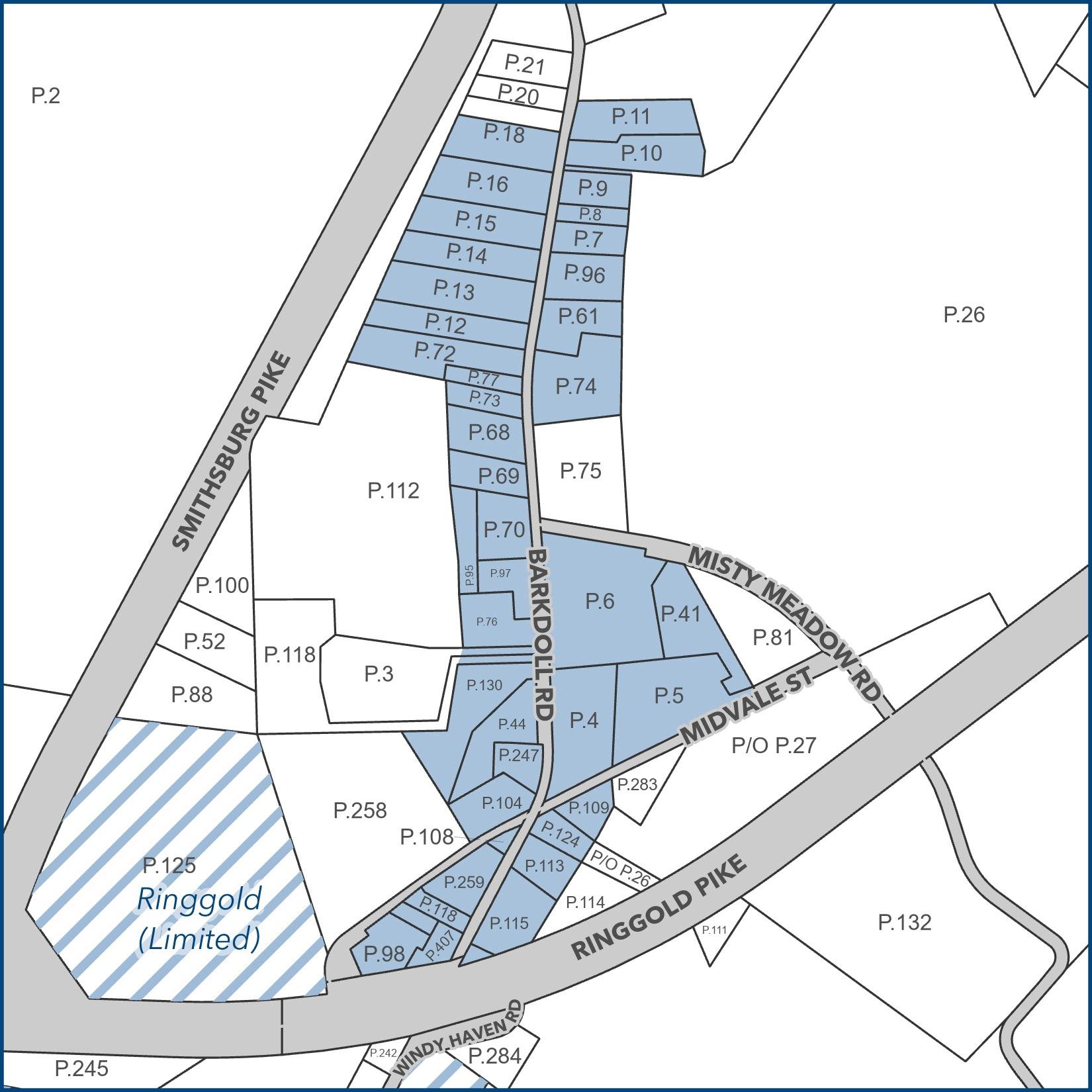
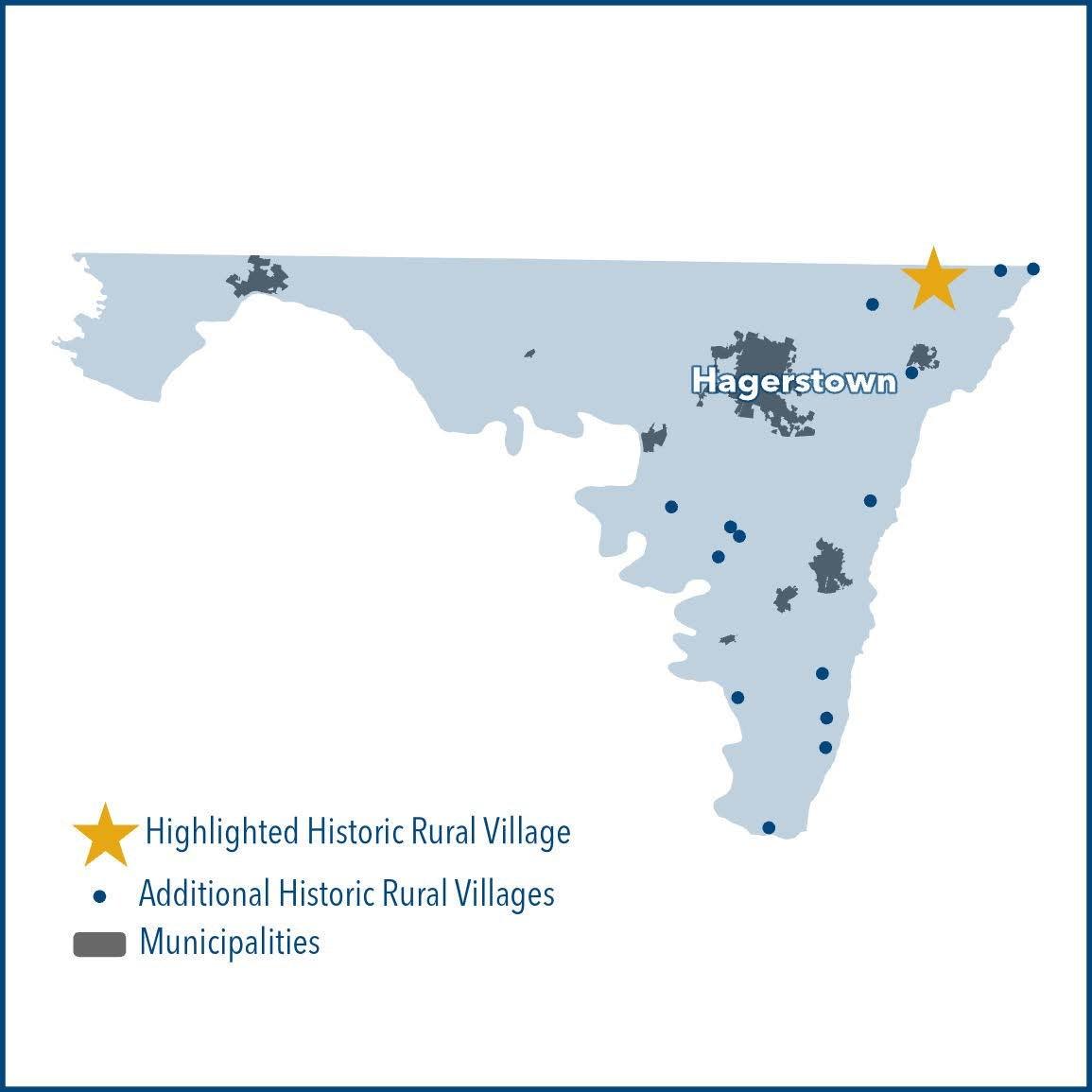
Inventory Number IV-007
National Register No
Contributing Structures
42/46
Survey Status
Adopted 2005
Period of Significance
1825-1920
Significance
Architecture
Maryland Historical Trust Ringgold File
Design Guidelines 107
Rohrersville Historic Rural Village
Located in southern Washington County, Maryland, Rohrersville was settled in the 1820s and initially developed in response to Washington County's strong agricultural economy, its location along an early wagon road and major transportation route, and a marble works industry. The village's mid-nineteenth-century development was influenced by the arrival of the railroad in 1867. By 1920 much of the extant village had been erected. Aside from the loss of its commercial character and limited alterations to its building stock, Rohrersville retains its mid nineteenth to early-twentieth-century architecture that portrays the cultural and historical trends of the time. Rohrersville is significant as an excellent example of a rural historic village in Washington County reflective of the prosperity of the surrounding agricultural region, the marble industry that supported it, and the eighteenth and nineteenth-century transportation systems that made the community viable.
- Description excerpted from Maryland Inventory of Historic Properties’ File
HDC ACTIONS IN THIS RURAL VILLAGE
CONTRIBUTING STRUCTURES Approval/Denial
NEW CONSTRUCTION Recommendations
INDIVIDUAL LISTINGS Recommendations
DEMOLITION Recommendations
108 Historic Structures
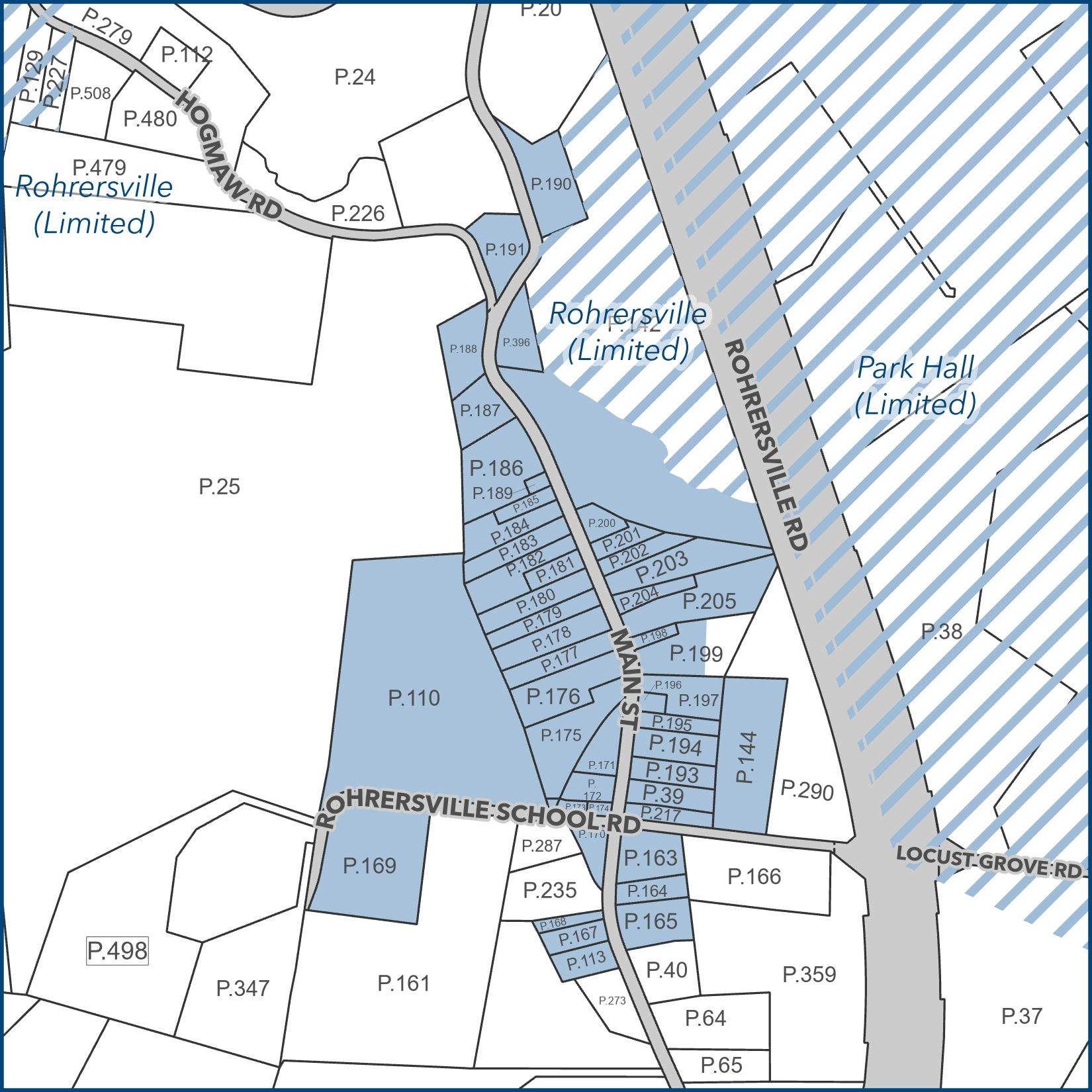

Inventory Number
III-025
National Register No
Contributing Structures
42/42
Survey Status
Adopted 2005
Period of Significance
1815-1930
Significance
Architecture, Economics, Social/Education/ Cultural and Transportation
Maryland Historical Trust Rohrersville File
Design Guidelines 109
Sandy Hook Historic Rural Village
The village of Sandy Hook is significant for its association with nineteenth century transportation trends as well as for events before and during the Civil War. As a rural village along a major transportation corridor, Sandy Hook is not as large and prosperous as other towns adjacent to the C&O Canal and B&O railroad; however, the village functioned as a necessary part of the transportation network and maintains its character as a nineteenth century rural village. The village was also incidentally involved in major events before and during the Civil War. Sandy Hook retains integrity of location, setting, feeling, and association.
- Description excerpted from Maryland Inventory of Historic Properties’ File
HDC ACTIONS IN THIS RURAL VILLAGE
CONTRIBUTING STRUCTURES
Approval/Denial
NEW CONSTRUCTION Recommendations
INDIVIDUAL LISTINGS Recommendations
DEMOLITION Recommendations
110 Historic Structures

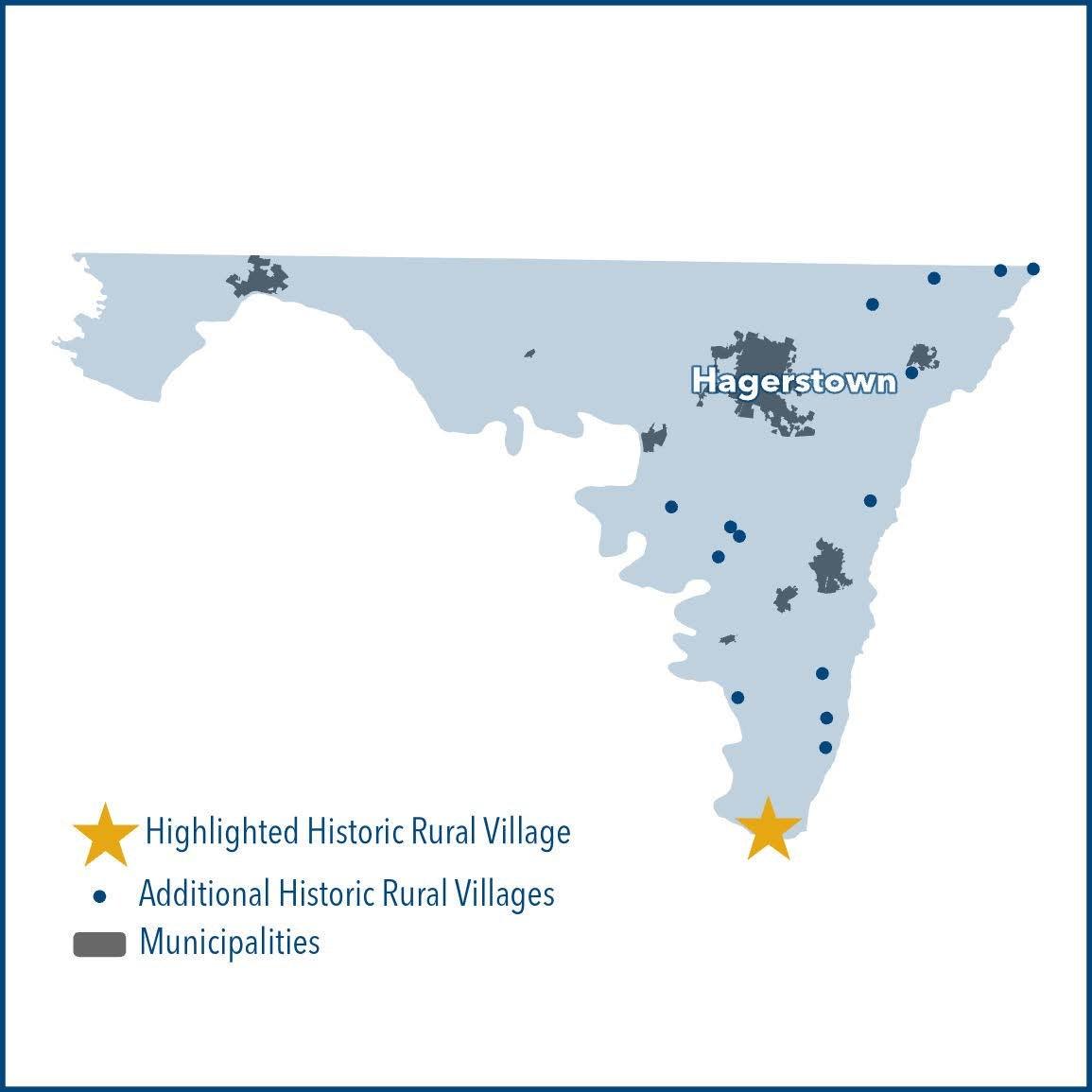
Inventory Number III-032
National Register No
Contributing Structures
31/47
Survey Status
Adopted 2005
Period of Significance
1800-1954
Significance
Architecture, Military and Transportation
Maryland Historical Trust Sandy Hook File
Design Guidelines 111
Tilghmanton Historic Rural Village
The Tilghmanton Historic District is documented with reference to National Register Criterion C, for architecture, as a reasonably intact and visually cohesive mid nineteenth century rural western Maryland village. The district contains a grouping of modest vernacular homes reflecting the traditions and design preferences of working-class settlers along the Hagerstown -Sharpsburg Pike during the years between c. 1830 and the early years of the twentieth century. Included within the district's inventory of historic resources are log homes that represent the earliest settlement architecture of the village, a collection of modest vernacular homes built without reference to any architectural style, two Federal-style houses, four residences executed in the Colonial Revival and Dutch Colonial Revived style, one early commercial building representing the limited and strictly local mercantile life of the hamlet, and one early twentieth-century schoolhouse. The village of Tilghmanton was named for Col. Frisby (also spelled "Frisbi") Tilghman (1774-1847), who, as a young man, came to Washington County late in the eighteenth century from Maryland's eastern shore. Tilghman's own residence, "Rockland" (WA-II-102), is located approximately one mile north of the settlement that bears his name.
- Description excerpted from Maryland Inventory of Historic Properties’ File
HDC ACTIONS IN THIS RURAL VILLAGE
CONTRIBUTING STRUCTURES
Approval/Denial
NEW CONSTRUCTION Recommendations
INDIVIDUAL LISTINGS Recommendations
DEMOLITION Recommendations
112 Historic Structures


Inventory Number
II-152
National Register
No
Contributing Structures
82/110
Survey Status
Adopted 2005
Period of Significance
1830-1930
Significance
Architecture
Maryland Historical Trust Tilghmanton
Design Guidelines 113
File
This page is intentionally left blank

Glossary
Middlekauff-Wiles Farm and Cemetery, WA-V-086
Accessory Structure
Structures that support the use of the main building on the same parcel of land.
Adaptive Reuse
Rehabilitation of a historic structure for use other than its original purpose, such as a residence converted into an office. Also called adaptive use.
Addition
A portion of a structure built after the original structure was completed. Additions may be historic or non-historic.
Alteration
The act or process which changes one or more of the exterior architectural features of a designated structure.
Antietam Overlay
A zoning overlay designed to protect the view shed of the Red Hill Area and the approaches to Antietam Battlefield.
Appropriate
See Compatible/Compatibility
Architrave
The lintel or beam that rests on the capitals of columns
Art Moderne
An architectural style, post 1930's with simple geometry and a curving low form. Characteristics include: long horizontal lines with rounded corners; flat roofs with no eaves; windows which wraparound the structure; and window shape may be porthole or glass block.
Articulation
The manner in which various features are designed and arranged on a building elevation.
Awning
A secondary covering attached to the exterior wall of a building, providing shade and protection from the elements around doors, windows, and other openings. May be retractable or stationary.
Baluster
One of a series of short vertical members used to support a stair or porch handrail, forming a balustrade
Balustrade
An entire rail system, with top rail and balusters.
Bargeboard
A board placed on the verge or incline of a roof gable end to conceal the rafter end and provide ornamentation; also called a vergeboard.
ii Historic Structures
The portion of a façade between columns or piers providing regular division of a façade, usually marked by windows or doors.
Board and Batten, Siding
A siding and paneling style that uses narrow strips of wood placed over the joints of wide boards for a geometric, layered effect.
Bollard
A short post used to divert traffic from an area or road.
Bracket
A projecting support placed under an architectural overhang such as a roof cornice or eave
Brick
A single building unit typically made of fired or sun-dried clay, used in masonry construction and laid in courses known as bonds.
Brick Bond
The pattern in which a bricklayer articulates the brick and mortar design of a wall, using the stretcher (the long, narrow side) and header (the short side) of the brick.
Casement Window
A window with one or two sashes which are hinged at the sides and usually open outward.
Certificate of Appropriateness
A certificate issued by the Historic District Commission indicating review and authorization of plans for alteration, construction, demolition or relocation of a landmark, or property, structure, site or object within a district.
Certified Local Government
The Certified Local Government program recognizes counties and municipalities that have made a special commitment to preservation. This commitment includes, but is not limited to, establishing a qualified historic preservation commission to designate and review historic properties.
Character
The qualities and attributes of any structure, site, street or district.
Character-Defining Features
Specific features of a structure, site, street, or district that contribute to its significance and designation, and that help define the distinctive character of the structure, site, street, or district.
Clapboard, siding
Horizontal wooden boards, thinner at the top edge, which are overlapped to provide a weatherproof exterior wall surface.
Design Guidelines iii Bay
Column
A circular or square vertical structural member. Many times columns fall into one of five classical orders: Tuscan, Doric, Ionic, Corinthian and Composite.
Compatible/Compatibility
The ability of alterations and new designs to be located in or near historic properties and districts without adverse effect. Some elements affecting design compatibility include location, height, scale, mass and bulk of structures; building materials; architectural details; circulation and access; landscaping; and parking impacts. Compatibility refers to the sensitivity of development proposals in maintaining the character and context of historic properties and districts. (also appropriate)
Configuration
The arrangement of elements and details on a building or structure that help to define the character.
Consolidant
In wood or other surfaces, this is used to stabilize deteriorated surfaces by protecting and making them firm again.
Construction
The act of adding an addition to an existing building or structure, or the erection of a new principle or accessory building or structure on a lot or property.
Contemporary
Reflecting characteristics of the current period. Contemporary denotes characteristics that illustrate that a building, structure, or detail was constructed in the present or recent past.
Context
The setting in which a historic element, site, structure, street or district exists.
Contributing
A structure , feature or property within a historic district or on the site of a historic landmark property that was built during the Period of Significance for the district or designated property and can be recognized as being from that period (meaning they retain integrity).
Corbels
In masonry, a projection, or one of a series of projections, each stepped progressively farther forward with height and articulating a cornice or supporting an overhanging member.
Corinthian
A classical order of architecture, characterized by fluted columns and elaborate capitals decorated with a floral motif, often an acanthus leaf.
Cornice
A projecting element that tops a wall.
iv Historic Structures
Cupola
A small, often dome-like structure on top of a building. Often used to provide light and air below, and usually crowns a larger roof or dome.
Cresting
A decorated ornamental finish along the top of a wall or roof often made of ornamental metal.
Dam
A barrier constructed to hold back water and raise its level, forming a reservoir used to generate power.
Deck
A flat surface that forms the main outside floor of a porch or balcony.
Demolition
The razing of a building, structure, or site in part or in total.
Demolition by Neglect
Allowing a building to fall into such a state of disrepair that it becomes necessary or desirable to demolish it. Property owners have been accused of permitting demolition by neglect on purpose, in order to save on rehabilitation costs.
Dentils
A row of small tooth-like blocks in a classical cornice.
Doric
A classical order of architecture, characterized by simplicity of design. Typically Doric columns have no base, are not fluted and feature a smooth capital that flares out from the column base to meet a square abacus.
Dormer
A roofed structure that contains one or more windows and projects from a sloped roof.
Double-Hung Window
A window with two sashes, one sliding vertically over the other.
Drop, Siding
A siding type prevalent in the nineteenth century with production at lumber mills. The siding has a Dutch inspired swoop at the top and a hidden rabbet to allow self spacing.
Eave
The edge of a roof that projects beyond the face of a wall.
Ecclesiastical
Relating to the church or its clergy
Elevation
Any one of the external face or façades of a building.
Entablature
A horizontal, continuous lintel on a classical building supported by columns or a wall, comprising the architrave, frieze, and cornice
Design Guidelines v
Façade
The exterior front wall of a building, usually the most ornate or articulated elevation.
Fanlights
A semi-circular window usually over a door with radiating muntins suggesting a fan.
Fascia
A flat horizontal member of molding; forms the trim of a flat roof or pitched roof; also part of a classical entablature.
Fence
An artificially constructed barrier, typically of wood, metal or other material or combination of materials to enclose, screen or separate areas.
Fenestration
The arrangement of windows on a building
Finial
A projecting decorative element, usually of metal, at the top of a roof turret or gable.
Fixed Pane, Window
A window that is non-operational. These can sometimes be called picture windows and do not have operable hardware. Their main purpose is to allow light.
Flashing
Thin metal sheets used to prevent moisture infiltration at joints of roof planes and between the roof and vertical surfaces.
Flat, Roof
A roof which is almost completely horizontal. Often found on commercial architecture and concealed with a parapet.
Form
The shape and structure of a building.
Foundation
The lowest exposed portion of the building wall, which supports the structure above.
Frieze
The part of an entablature between the architrave and the cornice
Gabled, Roof
A triangular shaped roof formed by two intersecting roof planes; also the triangular shaped wall at the end of the roof.
Gambrel, Roof
A type of gable roof with two slopes on each side, the upper being less steep than the lower.
Ghost Sign
A historic painted wall sign.
vi Historic Structures
Glazing
Part of a window, wall, or door that is made up of glass. Also known as lights.
Header
Upper horizontal framing member of a window or door.
Hipped, Roof
A roof with all four sides sloping downwards towards the walls the structure
Historic Advisory Committee (HAC)
A committee created in 1967 which, today focuses on listing and reviewing updates to the historic resources in the County as well as sponsor the John Frey Historic Preservation Award.
Historic District Commission (HDC)
A commission created to administer permit review within historic zoning designations.
Historic Preservation Zoning (HP Overlay)
A zoning overlay that was originally adopted in 1973 and amended in 1986 with a text and map amendment that focused the district to keep exterior appearances of buildings intact.
Ionic
A classical order of architecture characterized by the use of volutes on the capital and fluted columns supported by a base with an egg-and-dart motif.
In-Kind
Replacement of a building element to match the original in material, size, profile, texture, and color.
Integrity
The ability of a structure or district to convey its historic and architectural significance.
Jack Arch
A flat, structural element in masonry construction that provides support at an opening, similar to a lintel, but constructed of smaller, individual pieces. Also knows as a flat arch.
Jalousie Window
A jalousie window or louvre window is a window composed of parallel glass, acrylic, or wooden louvres set in a frame. The louvres are joined onto a track so that they may be tilted open and shut in unison to control airflow, usually by turning a crank.
Jamb
The side framing member of a door or window.
Jib window
A window which has sashes that move up or down into the window’s frame to create a larger opening for ventilation. These windows may consist of 1-3 sashes and may also include wooden panels below the sash which open, typically to a porch. Other similar terms for this window type include box head, slip or pocket windows.
Design Guidelines vii
Landmark
A property, structure, site or object designated as a “landmark” that has a high degree of historic, cultural, architectural or archaeological significance. All such designations include the lot(s) of record associated with the structure or object designated as a landmark.
Landscape
The totality of the built or human influenced habitat experienced at any one place. Dominant features are topography, plant cover, buildings or other structures and their patterns.
Lintel
The horizontal top member of a window, door or other opening.
Maintain
To keep in a state of preservation or repair to avoid deterioration of historic materials and features.
Mansard (Mansart), Roof
A roof with a double slope on all four sides, with the lower slope being almost vertical and the upper almost horizontal.
Maryland Historical Trust (MHT)
The state agency dedicated to preserving and interpreting the legacy of Maryland's past. Through research, conservation and education, the Maryland Historical Trust assists the people of Maryland in understanding their historical and cultural heritage. MHT is the State Historic Preservation Office for the State of Maryland. (see also State Historic Preservation Office)
Masonry
Construction of brick, stone, or other material requiring mortar and construction by a mason.
Mass
The overall size, height, shape and composition of the exterior of volumes of a building, especially when the structure has major and minor elements. (Also called Massing)
Molding
A continuous decorative band, often serving as a decorative device; often decorative with a variety of contours or outlines, and typically covering the joint formed where two surfaces or material types meet
Mortar
A mixture of sand, lime, cement and water, used as a binding agent in masonry construction.
viii Historic Structures
Mothballing
To stop using a structure but keep it in good condition through proper preparation for disuse so that it can be readily used again in the future
Mullion
A vertical element separating windows, doors, or panels set in a series.
Muntins
A secondary framing member to divide and hold the panes of glass in a multilight window or glass door.
New Construction
Construction which is characterized by the introduction of new elements, sites, buildings or structures or additions to existing buildings and structures.
Non-Contributing
A structure, feature or property within a historic district or on the site of a historic landmark property that does not support or add to the historic and architectural significance of a designated property or historic district.
Oriel (window)
A form of bay window which protrudes from the main wall of a building but does not reach to the ground. Supported by corbels, brackets, or similar cantilevers, an oriel window is most commonly found projecting from an upper floor but is also sometimes used on the ground floor.
Orientation
The relationship of a structure to the compass points or a site feature; may refer to the direction a façade faces, such as the south elevation, or the direction of a main axis, as in an east-west orientation.
Ornamentation
Applied embellishment in various styles that is a distinguishing characteristic of buildings. Ornamentation often occurs on entablatures, columns, and the tops of buildings and around entryways and windows, especially in the form of moldings.
Outbuilding
A small, secondary building separated from the main building.
Palladian Window
A palladian window is a large window divided in three parts: a central sash that is arched at the top and two sashes on each side of it that are smaller than the central sash; the smaller sashes are rectangular, topped with flat lintels
Parapet
A low wall at the edge of a roof, balcony, or deck.
Pediment
A triangular crowning element forming the gable of a roof; any similar triangular element used over windows, doors, etc.
Design Guidelines ix
Period of Significance
The time period during which an historic landmark or historic district gained its architectural, historical, and/or geographical importance. Typically, the period of significance covers a longer period of time than a structure’s, in order to encompass the period during which the district developed.
Pilasters
A square pillar attached, but projecting from a wall, resembling a classical column.
Porch
A structure attached to a building to shelter an entrance.
Portico
A roofed space, open or partly enclosed, forming the entrance and centerpiece of the façade of a building, often with a column and pediment.
Primary Façade
The main building face; the sides of a building that are street-facing.
Projecting Sign
A sign attached perpendicular to the wall of a building. Also called blade sign.
Proportion
The relationship of the size, shape, and location of one building element to all the other elements; each architectural style typically has its own rules of proportion.
Puncheon
A short post, especially one used for supporting the roof
Quoins
A series of raised stone, bricks, or wood panels ornamenting the outside of a wall corner
Race, dam
A narrow channel or watercourse, which water flows through for the purpose of turning a waterwheel
Rail, window
A horizontal piece of the window sash
Reconstruction
The act or process of reassembling, reproducing or replacing by new construction, the form, detail and appearance of the property and its setting as it appeared at a particular period of time by means of the removal of later work, or by the replacement of missing earlier work, or by reuse of the original materials.
Rehabilitation
The act or process of returning a building, object, site or structure to a state of utility through repair, remodeling, or alteration. Rehabilitation projects make possible an efficient contemporary use while preserving those portions or features of the building, object, site or structure, that are significant to its historical, architectural and geographical value.
x Historic Structures
Relocation
Any change of the location of a building, object or structure in its present setting or to another setting.
Repair
Use of measures to stabilize, consolidate, or conserve existing materials and features
Restoration
The act or process of accurately recovering the form and details of a building, object, site or structure, and its setting as it appeared at a particular period of time by means of the removal of later work, or by the replacements of missing earlier work.
Retain
To keep secure and intact. Retain describes the act of keeping an element, detail or structure, and providing a level of repair to aid in the preservation of elements, sites and structures.
Rhythm
Regular occurrence of elements or features, such as spacing between buildings.
Right-Of-Way
Public land that has been granted an easement, such as for utilities, or reserved for transportation purposes. Can include pedestrian traffic, vehicular traffic, canals, railway traffic, oil and gas pipeline, etc.
Rusticated
Roughening of stonework or concrete blocks to give greater articulation to each block.
Sash
The movable framework holding the glass in a window
Scale
Proportional elements that demonstrate the size, materials and style of buildings. The proportions of the elements of a building to one another and the whole, and to adjacent buildings.
Screening
Any landscaping or structure such as walls, landscaped berms, and hedges, used to conceal or reduce the negative visual and audio impacts of certain land uses or activities from streets or adjacent development.
Secondary Structure
A smaller or lesser structure associated with a primary structure on a property. Also called an accessory structure.
Secretary of Interior (SOI)
A branch of the National Park Service which oversees the use and conservation of federal lands. The SOI also developed standards commonly used by property owners, architects and governments to make deicsions about the appropriate treatment of historic properties.
Design Guidelines xi
Section 106
Refers to Section 106 of the National Historic Preservation Act of 1966, which requires State and Federal agencies to take into account the effects of their proposed activities or activities they permit on properties included, or eligible for inclusion, in the National Register of Historic Places.
Setbacks
The distance a structure is located from the street, other public way, or property line. Setback can also refer to the distance between structures on one or multiple lots.
Setting
The sum of attributes of a locality, neighborhood or property that defines its character.
Sheathing
An exterior covering of boards or other surface applied to the frame of the structure.
Shed, roof
A pitched roof with a single plane rising from one wall to the opposite wall. This type of roof can be found on outbuildings as the sole roof type or also be found in combination with other roof types as part of dormers or porches.
Shingles, Roof
A roofing material
Shingles, Siding
A variable width, length, and thickness of re-sawed lumber where the wood is split along the grain rather than sawing. This siding was popular on Queen Anne style homes as a decorative element of varying patterns.
Shutter
A usually movable cover or screen for a window or door that limits light and weather through the opening
Shutter Dog
A piece of hardware attached to the exterior wall which holds a shutter open and flush to the structure when the shutter is not in use. These can be highly decorative.
Sidelights
A vertical area of fixed glass on either side of a door or window.
Siding
The exterior wall covering or sheathing of a structure.
Sign
A sign is an object or device or part thereof situated outdoors or indoors which is used to identify or advertise a business.
Sill
The horizontal, usually projecting, lower lip of a window or door.
xii Historic Structures
Single-Hung, Window
A window with a single movable sash that slides up from the bottom while the stop sash stays stationary
Siting
The placement of a building, structure, or object on a site in relation to natural features, boundaries, and other parts of the built environment.
Sluice Box, Dam
A sliding gate or other device for controlling the flow of water
Spalling
The chipping or flaking of a masonry surface often due to moisture or weathering.
State Historic Preservation Office (SHPO)
An official within each state appointed by the governor to administer the state historic preservation program and carry out certain responsibilities relating to federal undertakings within the state. In Maryland this is the Maryland Historical Trust. See also Maryland Historical Trust
Stile, window
A vertical edge piece of the window sash
Style
A type of architecture distinguished by special characteristics of structure and ornament and often related in time; also a general quality of a distinctive manner.
Terrace
A relatively level paved or planted area adjoining a building
Transom
A horizontal window opening over a door or window
Trim
The decorative framing of openings and other features on a façade.
Tuscan
A classical order of architecture, characterized by simplicity of design. Similar to the Doric Order with the exception that Tuscan columns are supported by a base with an egg-anddart motif, like that of the Ionic Order.
Valley
The intersection of two sloping roof surfaces.
Veneer
A thin layer of material used as decorative facing that is not load bearing.
Vernacular
A regional form or adaptation of an architectural style. Often utilitarian in nature and stylistically influenced by HighStyle architecture.
V-Groove, Siding
Variable width (6-10inches) siding which is installed horizontally with a rabbeted bottom allowing self spacing with the preceding course, leaving a slight "v" pattern between the courses.
Design Guidelines xiii
This page is intentionally left blank
xiv Historic Structures
Citations:
Calvert County, M. H. (2001, October). Historic District Design Guidelines. Retrieved from Calvert County Maryland: https://www.calvertcountymd.gov/DocumentCenter/View/256/ HDGuidelines?bidId=
Montgomery County Maryland. (2021, 12 29). Solar Panel Interactive Guide. Retrieved from Montgomery County Planning: https://montgomeryplanning.org/wp-content/ uploads/2021/12/Solar-Panel-Interactive.pdf
Murphy & Dittenhafer Architects for Frederick County. (2021, October 12). https:// www.frederickcountymd.gov/. Retrieved from Frederick County, Maryland Design Guidelines: https://www.frederickcountymd.gov/DocumentCenter/View/315/HistoricPreservation-Commission-Design-Guidelines
U.S. Department of the Interior, N. P. (2017). The Secretary of the Interior's Standards for the Treatment of Historic Properties with Guidelines for Preserving, Rehabilitating, Restoring and Reconstructing Historic Buildings. Washington, D.C.: Technical Preservation Services.
US National Park Service. (2021, 12 28). Brief 25: The Preservation of Historic Signs. Retrieved from nps.gov: https://www.nps.gov/tps/how-to-preserve/briefs/25-signs.htm
Washington County, Maryland. (2021, 12 22). Washington County Zoning Ordinance. Retrieved from Local Legal Materials: https://www.washco-md.net/wp-content/uploads/ county-attny-Zoning-Ord.pdf#page=200
Design Guidelines xv













































































































































